 |
My personal reason why these are my heroes and influenced my life. I choose to keep them private.
|
 |
And there ain't nothing quite as sad
As watching your heroes die
One by one as they fall
Soon there'll be no heroes at all!
Who's going to fill their shose?
|
 |
|
 For God so loved the world, that he gave his only begotten Son, that whosoever believeth in him should not perish, but have everlasting life.... John 3:16 For God so loved the world, that he gave his only begotten Son, that whosoever believeth in him should not perish, but have everlasting life.... John 3:16
"Yet a little while, and the world seeth me no more; but ye see me: because I live, ye shall live also.... John 14:19 |
|
 |
|
|
 Jesus Christ plays a central role in our beliefs and in our lives. Our mission is to invite all of God’s children to follow Jesus and experience the joy that is possible because of Him. Jesus Christ plays a central role in our beliefs and in our lives. Our mission is to invite all of God’s children to follow Jesus and experience the joy that is possible because of Him.
Russell Marion Nelson Sr. (born September 9, 1924) is an American religious leader and retired surgeon who is the 17th and current president of the Church of Jesus Christ of Latter-day Saints (LDS Church). Nelson was a member of the LDS Church's Quorum of the Twelve Apostles for nearly 34 years, and was the quorum president from 2015 to 2018. As church president, Nelson is recognized by the church as a prophet, seer, and revelator. |
| |
|
Are members of The Church of Jesus Christ of Latter-day Saints Christian? >>>
Yes! As members of The Church of Jesus Christ of Latter-day Saints, we believe Jesus Christ is the Son of God and the Savior of the World. He loves us all more than we can imagine. We consider ourselves devoted followers of Jesus. While some of our beliefs are distinct, we believe that through His life, ministry, sacrifice, and resurrection, Jesus Christ saves us from sin, suffering, and death.
|
| |
What are Church services like? >>>
Church service times vary from congregation to congregation. However, you can always count on one main worship service for everyone, followed by classes for children, youth, and adults.
The service for everyone is called “sacrament meeting.” This meeting consists of songs, prayers, and sermons (or “talks”) given by different members of the congregation every week. But the most important part of the meeting is when we take the sacrament (which is similar to communion) to remember the Savior.
|
| |
Why does The Church of Jesus Christ of Latter-day Saints have temples? >>>
For Latter-day Saints, a temple is different from other Church buildings. The temple is a place where Latter-day Saints receive special instruction about God and Jesus Christ. In the temple, members make eternal covenants (or promises) with God. This includes promises to keep the commandments, live the gospel of Jesus Christ, be faithful in marriage, and to help take care of each other by sharing what we have.
Also, because we believe families are forever, much of the work done inside temples is to make family bonds even stronger. Marriages in the temple are performed to last eternally, not just “until death do you part.” Parents and children become eternal families in temples. Ancestors can also receive all the blessings of the temple if someone performs the sacred ordinances in their behalf and they accept that act of service. Temples are busy places!
|
| |
What is the Book of Mormon? >>>
The Book of Mormon is a book of inspired scripture that teaches us about God and Jesus Christ. It helps us receive direction for our personal lives and can help us feel closer to Jesus Christ. Where does the name come from? Hundreds of years ago, an ancient prophet named Mormon compiled a record of his people. They faced a lot of the same challenges that we do. And just like us, they found strength when they turned to Jesus Christ. Get an introduction to the Book of Mormon with missionaries.
The Book of Mormon stands alongside the Bible as another testament of Jesus Christ and His divine mission as the Savior and Redeemer of the world. Together, the Bible and the Book of Mormon provide more understanding of God’s great love for all of us and can help us come closer to Him.
|
| |
Do we believe in the Bible? >>>
Yes. The Bible is the word of God, a sacred volume of scripture, and following its teachings brings joy to our lives. Along with the Bible, we also find inspiration in other books of scripture unique to The Church of Jesus Christ of Latter-day Saints. They all work together to teach us important truths about God and Jesus Christ.
|
 |
|
 |
|
EULAN & LEE POSS |
 |
 Dad was a very hard worker always doing something and doing it very well. I can remember watching him build a project with no plans or supply list. When he would start a project, he always had the blueprint in his head. I was always amazed when he finished the job, there were no scraps. It didn’t matter if it was concrete work, brick, carpentry or metal, dad knew how to do Dad was a very hard worker always doing something and doing it very well. I can remember watching him build a project with no plans or supply list. When he would start a project, he always had the blueprint in his head. I was always amazed when he finished the job, there were no scraps. It didn’t matter if it was concrete work, brick, carpentry or metal, dad knew how to do
it all.
Mom was an incredible lady, and always dressed to the nines. She was the glue that held the family together. As a child growing up, I remember for
breakfast shealways made biscuits and gravy, bacon, sausage, eggs, pancakes and oatmeal. I guess with four boys she wanted to make sure we all ate and were satisfied.
Read More >>>
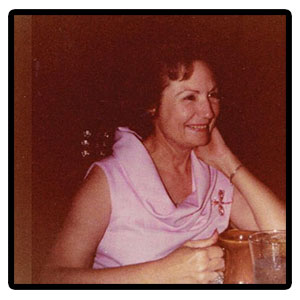 Mom was always there for us and very understanding even with 4 boys. In 1957, mom told dad day she wanted a pink Cadillac, so of course dad bought her a new 1957 Pink Cadillac. One day Mom came home with a half dozen ping pong paddles with attached rubber band to the red rubber balls. We thought that was great until she snapped off the rubber bands … we knew it wasn’t good. She told us she was tired of us growing boys laughing when she swatted us for the latest transgressions and was going to place the paddles around the house so they would be close when needed. Mom was about 5 ft tall, we were taller and growing but she always ruled the roost with us. We knew for certain we were in trouble when she said, ‘just wait till your dad gets home!’ Dad would always show up in a good mood and glad to be home from work, until mom said, “Honey do you know what your son did?” You could see dad’s face as she made her statement, he really didn’t want to deal with it. The look was always followed by, “Boy, this is going to hurt me more than it hurts you.” Maybe you have also heard this statement. With no Air conditioner back then, when it was hot, mom would shew us boys out ‘to play’ and tell us to be back when the streetlight came on. Mom was always there for us and very understanding even with 4 boys. In 1957, mom told dad day she wanted a pink Cadillac, so of course dad bought her a new 1957 Pink Cadillac. One day Mom came home with a half dozen ping pong paddles with attached rubber band to the red rubber balls. We thought that was great until she snapped off the rubber bands … we knew it wasn’t good. She told us she was tired of us growing boys laughing when she swatted us for the latest transgressions and was going to place the paddles around the house so they would be close when needed. Mom was about 5 ft tall, we were taller and growing but she always ruled the roost with us. We knew for certain we were in trouble when she said, ‘just wait till your dad gets home!’ Dad would always show up in a good mood and glad to be home from work, until mom said, “Honey do you know what your son did?” You could see dad’s face as she made her statement, he really didn’t want to deal with it. The look was always followed by, “Boy, this is going to hurt me more than it hurts you.” Maybe you have also heard this statement. With no Air conditioner back then, when it was hot, mom would shew us boys out ‘to play’ and tell us to be back when the streetlight came on.
Mom was very active in church and the family would go Sunday morning, evening and every Wednesday night. She became the church organist and she couldn’t read music. Mom played strictly by ear. I was always impressed by her musical ability. . All she had to do was hear the melody one time and she had it down.
Dad was a very hard worker always doing something and doing it very well. I can remember watching him build a project with no plans or supply list. When he would start a project, he always had the blueprint in his head. I was always amazed when he finished the job, there were no scraps. It didn’t matter if it was concrete work, brick, carpentry or metal, dad knew how to do
it all. I’m sure Dad acquired his skills when he worked for the C.C.C. camp. I know that during WWII Dad was classified as 4 F because he was flat footed, and had a heart murmur and started working in the shipyard in Houston Texas as a welder.
During the depression the President started the C.C.C. camp for construction projects to keep men employed. One project that I know Dad worked on was the path leading through the Carlsbad Caverns in New Mexico. The 1.25 mile (2 km) Natural Entrance Trail is extremely steep. Depending on if you decide to hike up or down, you gain or lose about 750 feet (229 m)—equivalent to walking up or down a 75-story building. The hike takes about one hour (on average) to complete.
Dad would always tease the children by asking them if they wanted ice cream. When they said yes, he would then hold out his fist and say here you go; do you want chocolate, strawberry, or vanilla. I think of dad often and really miss him.
|
|
 |
|
 What can I say about my brothers. I was very blessed to have my brother Ray, Don, and Jerry. From Ray rescuing me from a cliff in Apple Valley California. And, watching him being able to do anything. Don for spending time with him in a patrol car keeping citizens safe. And Jerry being there when I got in trouble and getting me out of in. Having a bedroom that was named THE J&L RANCH. What can I say about my brothers. I was very blessed to have my brother Ray, Don, and Jerry. From Ray rescuing me from a cliff in Apple Valley California. And, watching him being able to do anything. Don for spending time with him in a patrol car keeping citizens safe. And Jerry being there when I got in trouble and getting me out of in. Having a bedroom that was named THE J&L RANCH.
They all cast a large shadow for me to live up to. I found it was very hard to walk in their shoes. However , I did out rank them in the military. |
| |
BOBBY POSS |
|
|
|

I was very blessed to have four wonderful children Amy, Aron, Alisa, and Adom. They all grew up to have wonderful families and I couldn’t be prouder of all of them. Nine wonderful grandchildren. |
|
|
VICKI NICHOLS |
 |
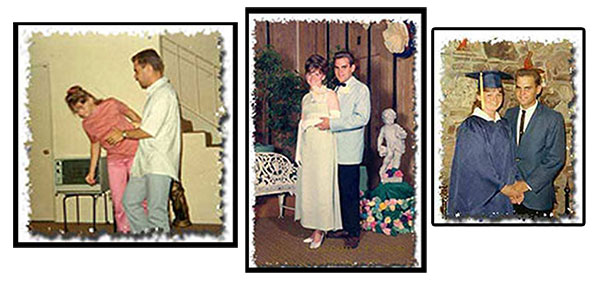 |
| Vicki Nichols, I met her in my 10th grade of Jr. high school. She was my 1st love and somehow always in my thoughts from the day we met even now! We were together all through High School and part of my Army life. I lost contact with her after I can home from the Army. Years later I saw her sister Kathy and she informed me that she passed away from cancer. That was a very sad day for me! |
|
 |
|
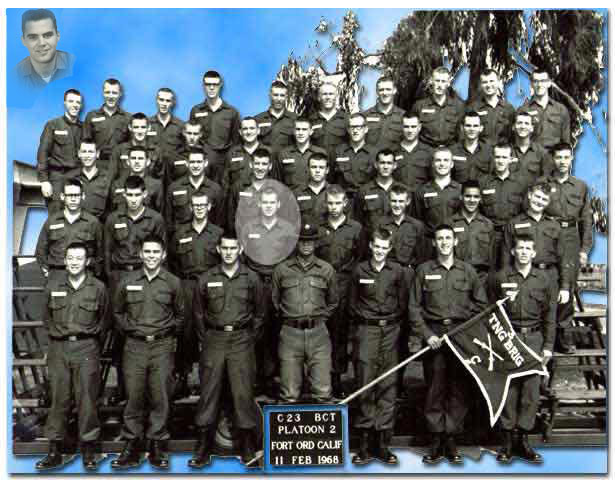 |
 |
 In 1968, Americans were asking, "Do you know the way to San
Jose?" as Diane Warwicke serenading this great land of ours
with her songs. I never made it to San Jose, but Uncle Sam
showed me the way to Fort Ord, California. In 1968, Americans were asking, "Do you know the way to San
Jose?" as Diane Warwicke serenading this great land of ours
with her songs. I never made it to San Jose, but Uncle Sam
showed me the way to Fort Ord, California.
For the next eight weeks, my time was taking up with learning
to be a good maggot, running with a full pack, kissing the
dirt, counting in a system Dewey-Decimal never dreamt of:
"Up One, Two, Three, Four." Drilling, with training tacked
onto it, was the mainstay. Oh yes, I learned a new name, "JODY."
It seemed my girl's pledge of eternal love lasted until this
guy named Jody showed up. He had my girl at home, and I could
only image what they were doing together. Just turned 18,
and even thought of going to see the Chaplin...but he came
to us instead. To hear his inspirational words of loving support [send the children out of the room], click here (19K), here (120K), and here (69K). |
 |
| Army Marching Cadence |
 |
(DI) Your Left Youre Right... Left Right Left Right... (Boots - [Maggot] Repeats)
(DI) You never get home when your Left... Your Right... (Boots - [Maggot])
(DI) Your Left Youre Right... Left Right Left Right... (Boots - [Maggot] Repeats)
(DI) Hey, De high De Oh... (Boots - [Maggot] Repeats)
(DI) Up the hill... The way we go... (Boots - [Maggot] Repeats)
(DI) Forty inches all around... (Boots - [Maggot] Repeats)
(DI)That The Ft Ord special... (Boots - [Maggot] Repeats)
(DI) What a crazy sound... (Boots - [Maggot] Repeats)
(DI) Up - One, two, three, four... (Boots - [Maggot] Repeats)
Read More >>>

The
day I enlisted was 29 January 1968. While my mother was crying,
my father gave me twenty bucks and a shaving case kit. He
told me that I would need them both. I kissed my mother and
shook my father's hand and said good-bye, and God Bless. Then
I turned away and walked through the main post office's doors.
I had no idea that, "mommies little baby boy would
soon become a MEAT HEAD and MAGGOT!" I became all that, then
some, despite my amazement.
"When I joined I had no idea how anything worked. Everything was brand new," Gerhardt says. "For me, hearing that first cadence the very first time was awesome. Because you always wanted to hear what the next verse was. So you always wanted to keep up so that you could hear the person calling the cadence so you knew what to say back to them."
The infectious appeal of cadences is used to motivate and coordinate people who might not have anything else in common. But they also do something more fundamenta.
(DI) Your Left Youre Right... Left Right Left Right... (Boots - [Maggot] Repeats)
(DI) You never get home when your Left... Your Right... (Boots - [Maggot])
(DI) Your Left Youre Right... Left Right Left Right... (Boots - [Maggot] Repeats)
(DI) Hey, De high De Oh... (Boots - [Maggot] Repeats)
(DI) Up the hill... The way we go... (Boots - [Maggot] Repeats)
(DI) Forty inches all around... (Boots - [Maggot] Repeats)
(DI)That The Ft Ord special... (Boots - [Maggot] Repeats)
(DI) What a crazy sound... (Boots - [Maggot] Repeats)
(DI) Up - One, two, three, four... (Boots - [Maggot] Repeats)
(DI) I want to be an Airborne Ranger... (Boots - [Maggot] Repeats)
(DI) Live a life of Gus and danger... (Boots - [Maggot] Repeats)
(DI) Up the hill... down the hill ... (Boots - [Maggot] Repeats)
(DI) I want to be an Airborne Ranger... (Boots - [Maggot] Repeats)
(DI) Up - One, two, three, four ... (Boots - [Maggot] Repeats)
“I don’t know, but I’ve been told” is definitely real, but after that, whatever you’ve heard in the movies or on TV was cleaned up with soap and bleach, because in the military it gets real dirty, real fast. And fun..
Yellow Bird Cadence
(DI) A yellow bird, with a yellow bill. (Boots - [Maggot] Repeats)
(DI) He landed on My window sill. (Boots - [Maggot] Repeats)
(DI) I coaxed him in. With a piece of bread, (Boots - [Maggot] Repeats)
(DI) and then I kissed his Little Little head! (Stomp your falling foot in unison) (Boots - [Maggot] Repeats)
(DI) I called the doctor. The doctor said. (Boots - [Maggot] Repeats)
(DI) My dear good man. This bird is dead. (Boots - [Maggot] Repeats)
(DI) The moral of The Story is (Boots - [Maggot] Repeats)
(DI) If you want some bread (Boots - [Maggot] Repeats)
(DI) You better Give some Head (Boots - [Maggot] Repeats)
(DI) Up - One, two, three, four... (Boots - [Maggot] Repeats)
MAMA MAMA Can't you see Cadence
(DI) Mama mama can’t you see, (Boots - [Maggot] Repeats)
(DI) what the army’s done to me. (Boots - [Maggot] Repeats)
(DI) They put me in a barber’s chair, (Boots - [Maggot] Repeats)
(DI) spun me around I had no hair (Boots - [Maggot] Repeats)
(DI) Up - One, two, three, four... (Boots - [Maggot] Repeats)
(DI) Mama mama can’t you see, (Boots - [Maggot] Repeats)
(DI) what the army’s done to me. (Boots - [Maggot] Repeats)
(DI) They took away my favorite jeans, (Boots - [Maggot] Repeats)
(DI) now I’m wearing army greens. (Boots - [Maggot] Repeats)
(DI) Up - One, two, three, four... (Boots - [Maggot] Repeats)
(DI) Mama mama can’t you see, (Boots - [Maggot] Repeats)
(DI) what the army’s done to me. (Boots - [Maggot] Repeats)
(DI) I use to date beauty queens, (Boots - [Maggot] Repeats)
(DI) now I love my M16. (Boots - [Maggot] Repeats)
(DI) Up - One, two, three, four... (Boots - [Maggot] Repeats)
(DI) Mama mama can’t you see? (Boots - [Maggot] Repeats)
(DI) What the Army’s done to me? (Boots - [Maggot] Repeats)
(DI) I used to date the prom king (Boots - [Maggot] Repeats)
(DI) Now I hug an AR15. (Boots - [Maggot] Repeats)
(DI) Up - One, two, three, four... (Boots - [Maggot] Repeats)
(DI) Mama mama can’t you see? (Boots - [Maggot] Repeats)
(DI) What the Army’s done to me? (Boots - [Maggot] Repeats)
(DI) Took away my lovin’ man (Boots - [Maggot] Repeats)
(DI) Now I sleep with Uncle Sam. (Boots - [Maggot] Repeats)
(DI) Up - One, two, three, four... (Boots - [Maggot] Repeats)
I put my hand on my girlfriend Cadence
(DI) I put my hand on my girlfriend’s toe (Boots - [Maggot] Repeats)
(DI) Ya ho Ya ho (Boots - [Maggot] Repeats)
(DI) I put my hand on my girlfriend’s toe (Boots - [Maggot] Repeats)
(DI) Ya ho Ya ho (Boots - [Maggot] Repeats)
(DI) I put my hand on my girlfriend’s toe (Boots - [Maggot] Repeats)
(DI) She said dear boy you’re much too slow (Boots - [Maggot] Repeats)
(DI) Get in, get out quit f**ing about. (Boots - [Maggot] Repeats)
(DI) Ya ho Ya ho Ya ho (Boots - [Maggot] Repeats)
(DI) I put my hand on my girlfriend’s knee (Boots - [Maggot] Repeats)
(DI) Ya ho Ya ho (Boots - [Maggot] Repeats)
(DI) I put my hand on my girlfriend’s knee (Boots - [Maggot] Repeats)
(DI) Ya ho Ya ho (Boots - [Maggot] Repeats)
(DI) I put my hand on my girlfriend’s knee (Boots - [Maggot] Repeats)
(DI) She said dear boy you’re tickling me. (Boots - [Maggot] Repeats)
(DI) Get in, get out quit f**ing about. (Boots - [Maggot] Repeats)
(DI) Ya ho Ya ho Ya ho (Boots - [Maggot] Repeats)
(DI) I put my hand on my girlfriend’s thigh (Boots - [Maggot] Repeats)
(DI) Ya ho Ya ho (Boots - [Maggot] Repeats)
(DI) I put my hand on my girlfriend’s thigh (Boots - [Maggot] Repeats)
(DI) Ya ho Ya ho (Boots - [Maggot] Repeats)
(DI) I put my hand on my girlfriend’s thigh (Boots - [Maggot] Repeats)
(DI) She said dear boy you’re much too shy. (Boots - [Maggot] Repeats)
(DI) Get in get out quit f**ing about. (Boots - [Maggot] Repeats)
(DI) Ya ho Ya ho Ya ho (Boots - [Maggot] Repeats)
Infantry Cadence
(DI) Oh, sol-dier (Boots - [Maggot] Repeats)
(DI) Com-bat sol-dier (Boots - [Maggot] Repeats)
(DI) Pick up your weap-on and Fol-low Me (Boots - [Maggot] Repeats)
(DI) I am the In-fan-try (Boots - [Maggot] Repeats)
|
|
 |
|
 |
|
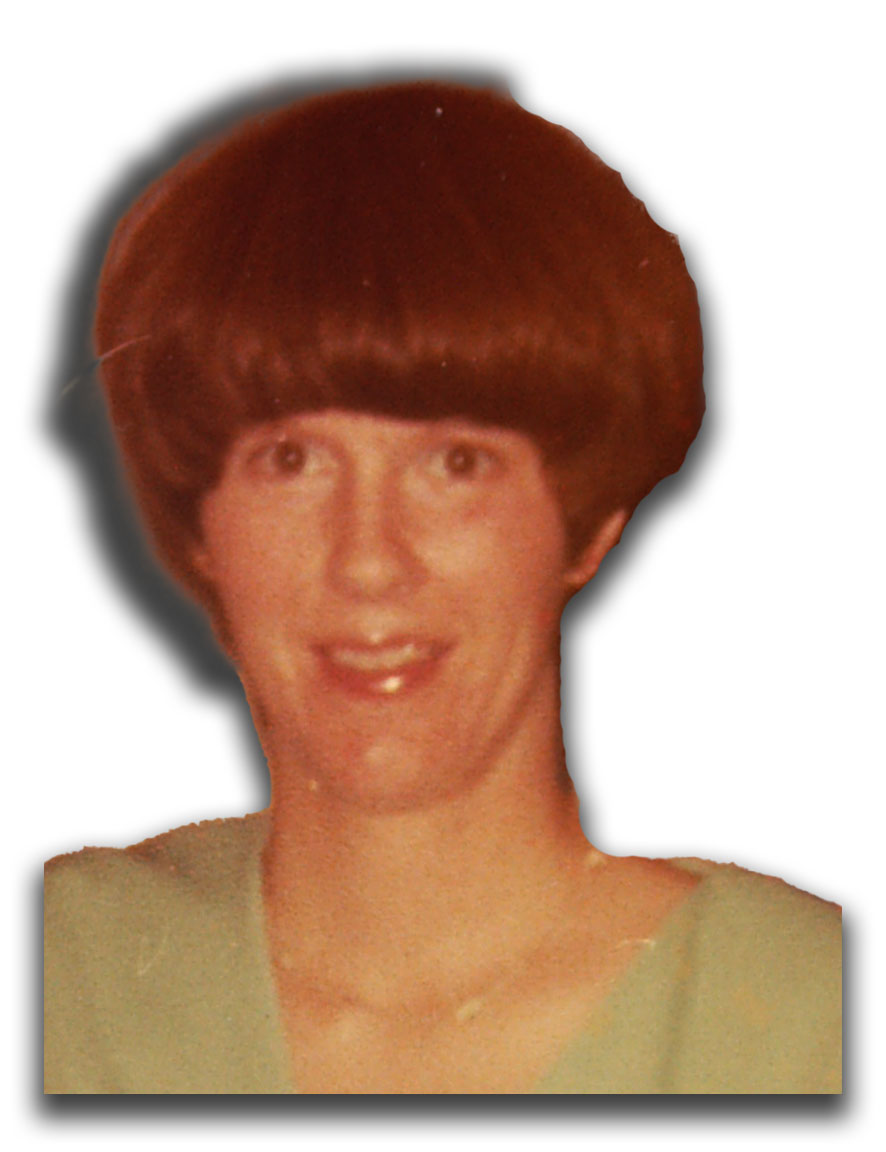 I thought from the day I saw her I noticed her humor and her love for life. She was my 1st only wife although we got a divorce, she had been a wonderful mother to our children. I watch her conquering nursing school and become a wonderful nurse. We had four wonderful children together, each of our children was very much wanted in our lives. Andi wherever you are I wish you the best of luck and love. I thought from the day I saw her I noticed her humor and her love for life. She was my 1st only wife although we got a divorce, she had been a wonderful mother to our children. I watch her conquering nursing school and become a wonderful nurse. We had four wonderful children together, each of our children was very much wanted in our lives. Andi wherever you are I wish you the best of luck and love. |
|
 |
|
 Ann came into my life in the late 80’s. Our friendship goes with out saying. Ann is one of a kind. Her love for family and God is what make her stand out among others. Ann passion for the well-being of others is unmatchable. Ann came into my life in the late 80’s. Our friendship goes with out saying. Ann is one of a kind. Her love for family and God is what make her stand out among others. Ann passion for the well-being of others is unmatchable.
She loves being with her grandchildren and she can shake up a dance floor with her Two Stepping. I couldn’t see myself growing old with anyone else. |
 |
|
 |
|
 Susan, well she can light up any room or make anyone smile. Just being around, she shines a light on your day. She always finds a silver light in all things. Susan, well she can light up any room or make anyone smile. Just being around, she shines a light on your day. She always finds a silver light in all things.
Susan a gift from the unniverse!!
And one thing am most proud of is….. she calls me “DAD”. |
 |
|
 |
|
BUD ABBOTT & LOU COSTELLO |
 |
| |
|
| |
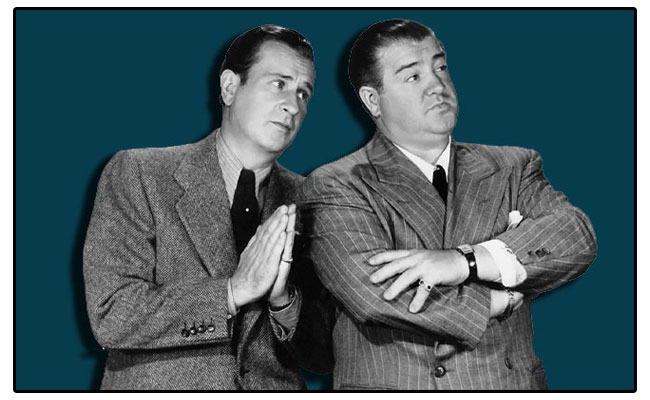 Abbott and Costello were an American comedy duo composed of comedians Bud Abbott and Lou Costello, whose work in radio, film, and television made them the most popular comedy team of the 1940s and 1950s, and the highest-paid entertainers in the world during the Second World War. Their patter routine "Who's on First?" is considered one of the greatest comedy routines of all time, a version of which appears in their 1945 film The Naughty Nineties. Abbott and Costello were an American comedy duo composed of comedians Bud Abbott and Lou Costello, whose work in radio, film, and television made them the most popular comedy team of the 1940s and 1950s, and the highest-paid entertainers in the world during the Second World War. Their patter routine "Who's on First?" is considered one of the greatest comedy routines of all time, a version of which appears in their 1945 film The Naughty Nineties.
Read More >>>
Abbott and Costello, American comedic duo who performed onstage, in films, and on radio and television. Bud Abbott (original name William Alexander Abbott; b. October 2, 1895, Asbury Park, New Jersey, U.S.—d. April 24, 1974, Woodland Hills, California) and Lou Costello (original name Louis Francis Cristillo; b. March 6, 1906, Paterson, New Jersey, U.S.—d. March 3, 1959, East Los Angeles, California) specialized in rapid-fire patter and knockabout slapstick, and they are regarded as the archetypal team of burlesque comedy. Abbott was born into a circus family, and he managed burlesque houses before he met Costello. He spent much time backstage studying the top American comics of the day, including W.C. Fields, Bert Lahr, and the comedy team of Bobby Clark and Paul McCullough. In 1923 Abbott produced his own show, Broadway Flashes, in which he played a leading role in order to save the cost of an actor’s salary. He spent the next decade perfecting his talents as a straight man and working with a number of partners that included his wife, Betty.
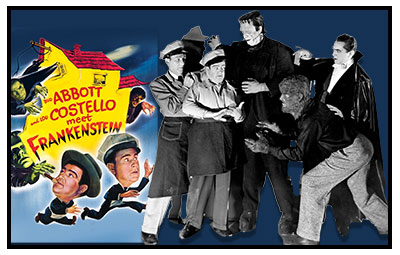 As a young man, Costello greatly admired Charlie Chaplin. In 1927 he moved to Hollywood, where he worked as a stuntman; after an injury he quit stunt work to perform in New York burlesque. Although he had never worked onstage before, he quickly became one of the top burlesque comics and learned the hundreds of standard comedy routines of the circuit. Those stock routines allowed comics to work interchangeably with a variety of partners (often on a moment’s notice); in such informal pairings, Abbott and Costello performed together sporadically throughout the early 1930s, before their official teaming in early 1936. As a young man, Costello greatly admired Charlie Chaplin. In 1927 he moved to Hollywood, where he worked as a stuntman; after an injury he quit stunt work to perform in New York burlesque. Although he had never worked onstage before, he quickly became one of the top burlesque comics and learned the hundreds of standard comedy routines of the circuit. Those stock routines allowed comics to work interchangeably with a variety of partners (often on a moment’s notice); in such informal pairings, Abbott and Costello performed together sporadically throughout the early 1930s, before their official teaming in early 1936.
During the next few years, the team worked the burlesque circuit and perfected routines each had done countless times with other partners, including the baseball sketch “Who’s on First?,” for which they became famous. Although they would occasionally vary their standard formula in a few of their films, Abbott and Costello’s act remained mostly consistent throughout their two decades as a team. Abbott was something of a bully and a schemer, and Costello played the hapless childlike patsy who was known for catchphrases such as “I’m a ba-a-a-a-d boy!” Their characters were stock types of the burlesque tradition; as such, their comedy relied more on the rapid-fire delivery of gags than on character or situational humour. They have been credited as one of the few comedy teams to have preserved on film many of the classic routines of the American vaudeville and burlesque traditions.
Who’s On First?
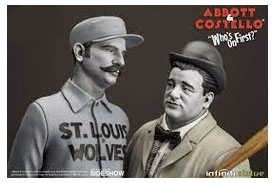
Abbott: Alright, now whaddya want?
Costello: Now look, I'm the head of the sports department. I gotta know the baseball
players' names. Do you know the guys' names?
Abbott: Oh sure.
Costello: So you go ahead and tell me some of their names.
Abbott: Well, I'll introduce you to the boys. You know sometimes nowadays they give
ballplayers peculiar names.
Costello: You mean funny names.
Abbott: Nicknames, pet names, like Dizzy Dean -
Costello: His brother Daffy
Abbott: Daffy Dean -
Costello: And their cousin!
Abbott: Who's that?
Costello: Goofy!
Abbott: Goofy, huh? Now let's see. We have on the bags - we have Who's on first,
What's on second, I Don't Know's on third.
Costello: That's what I wanna find out.
Abbott: I say Who's on first, What's on second, I Don't Know's on third -
Costello: You know the fellows' names?
Abbott: Certainly!
Costello: Well then who's on first?
Abbott: Yes!
Costello: I mean the fellow's name!
Abbott: Who!
Costello: The guy on first!
Abbott: Who!
Costello: The first baseman!
Abbott: Who!
Costello: The guy playing first!
Abbott: Who is on first!
Costello: Now whaddya askin' me for?
Abbott: I'm telling you Who is on first.
Costello: Well, I'm asking YOU who's on first!
Abbott: That's the man's name.
Costello: That's who's name?
Abbott: Yes.
Costello: Well go ahead and tell me.
Abbott: Who.
Costello: The guy on first.
Abbott: Who!
Costello: The first baseman.
Abbott: Who is on first!
Costello: Have you got a contract with the first baseman?
Abbott: Absolutely.
Costello: Who signs the contract?
Abbott: Well, naturally!
Costello: When you pay off the first baseman every month, who gets the money?
Abbott: Every dollar. Why not? The man's entitled to it.
Costello: Who is?
Abbott: Yes. Sometimes his wife comes down and collects it.
Costello: Who's wife?
Abbott: Yes.
Costello: All I'm tryin' to find out is what's the guy's name on first base.
Abbott: Oh, no - wait a minute, don't switch 'em around. What is on second base.
Costello: I'm not askin' you who's on second.
Abbott: Who is on first.
Costello: I don't know.
Abbott: He's on third - now we're not talkin' 'bout him.
Costello: Now, how did I get on third base?
Abbott: You mentioned his name!
Costello: If I mentioned the third baseman's name, who did I say is playing third?
Abbott: No - Who's playing first.
Costello: Never mind first - I wanna know what's the guy's name on third.
Abbott: No - What's on second.
Costello: I'm not askin' you who's on second.
Abbott: Who's on first.
Costello: I don't know.
Abbott: He's on third.
Costello: Aaah! Would you please stay on third base and don't go off it?
Abbott: What was it you wanted?
Costello: Now who's playin' third base?
Abbott: Now why do you insist on putting Who on third base?
Costello: Why? Who am I putting over there?
Abbott: Yes. But we don't want him there.
Costello: What's the guy's name on third base?
Abbott: What belongs on second.
Costello: I'm not askin' you who's on second.
Abbott: Who's on first.
Costello: I don't know.
Abbott & Costello: THIRD BASE!
Costello: You got an outfield?
Abbott: Oh yes!
Costello: The left fielder's name?
Abbott: Why.
Costello: I don't know, I just thought I'd ask you.
Abbott: Well, I just thought I'd tell you.
Costello: Alright, then tell me who's playin' left field.
Abbott: Who is playing fir�Costello: STAY OUTTA THE INFIELD! I wanna know what's the left fielder's name.
Abbott: What's on second.
Costello: I'm not askin' you who's on second.
Abbott: Who's on first.
Costello: I don't know.
Abbott & Costello: THIRD BASE!
Costello: The left fielder's name?
Abbott: Why.
Costello: Because!
Abbott: Oh, he's center field.
Costello: Look, you gotta pitcher on this team?
Abbott: Now wouldn't this be a fine team without a pitcher.
Costello: The pitcher's name.
Abbott: Tomorrow.
Costello: You don't wanna tell me today?
Abbott: I'm tellin' you now.
Costello: Then go ahead.
Abbott: Tomorrow.
Costello: What time?
Abbott: What time what?
Costello: What time tomorrow are you going to tell me who's pitching?
Abbott: Now listen. Who is not pitching. Who is on fir�Costello: I'll break your arm if you say Who's on first. I wanna know what's the
pitcher's name.
Abbott: What's on second.
Costello: I don't know.
Abbott & Costello: THIRD BASE!
Costello: You got a catcher?
Abbott: Oh, absolutely.
Costello: The catcher's name.
Abbott: Today.
Costello: Today. And Tomorrow's pitching.
Abbott: Now you've got it.
Costello: All we've got is a couple of days on the team.
Abbott: Well, I can't help that.
Costello: Well, I'm a catcher too.
Abbott: I know that.
Costello: Now suppose that I'm catching, Tomorrow's pitching on my team and their
heavy hitter gets up.
Abbott: Yes.
Costello: Tomorrow throws the ball. The batter bunts the ball. When he bunts the ball,
me being a good catcher, I wanna throw the guy out at first base. So I pick up the ball
and throw it to who?
Abbott: Now that's the first thing you've said right.
Costello: I don't even know what I'm talkin' about!
Abbott: Well, that's all you have to do.
Costello: Is to throw the ball to first base.
Abbott: Yes.
Costello: Now who's got it?
Abbott: Naturally!
Costello: If I throw the ball to first base, somebody's gotta catch it. Now who caught
it?
Abbott: Naturally!
Costello: Who caught it?
Abbott: Naturally.
Costello: Who?
Abbott: Naturally!
Costello: Naturally.
Abbott: Yes.
Costello: So I pick up the ball and I throw it to Naturally.
Abbott: NO, NO, NO! You throw the ball to first base and Who gets it?
Costello: Naturally.
Abbott: That's right. There we go.
Costello: So I pick up the ball and I throw it to Naturally.
Abbott: You don't!
Costello: I throw it to who?
Abbott: Naturally.
Costello: THAT'S WHAT I'M SAYING!
Abbott: You're not saying it that way.
Costello: I said I throw the ball to Naturally.
Abbott: You don't - you throw the ball to Who?
Costello: Naturally!
Abbott: Well, say that!
Costello: THAT'S WHAT I'M SAYING! I throw the ball to who?
Abbott: Naturally.
Costello: Ask me.
Abbott: You throw the ball to Who?
Costello: Naturally.
Abbott: That's it.
Costello: SAME AS YOU!! I throw the ball to first base and who gets it?
Abbott: Naturally!
Costello: Who has it?
Abbott: Naturally!
Costello: HE BETTER HAVE IT! I throw the ball to first base. Whoever it is grabs the
ball, so the guy runs to second. Who picks up the ball and throws it to What, What
throws it to I Don't Know, I Don't Know throws it back to Tomorrow - triple play.
Abbott: Yes.
Costello: Another guy gets up - it's a long fly ball to Because. Why? I don't know. He's
on third and I don't give a darn!
Abbott: What was that?
Costello: I said I don't give a darn!
Abbott: Oh, that's our shortstop.
|
 |
| |
|
 |
|
ABRAHAM LINCOLN |
 |
|
| |
Abraham Lincoln
 I was born February 12, 1809 in Hardin County, Kentucky. My father removed from Kentucky to what is now Spencer County, Indiana in my eighth year. There, I grew up. My mother, who died in my tenth year, was of a family of the name of Hanks. I went to A-B-C schools by littles. I was born February 12, 1809 in Hardin County, Kentucky. My father removed from Kentucky to what is now Spencer County, Indiana in my eighth year. There, I grew up. My mother, who died in my tenth year, was of a family of the name of Hanks. I went to A-B-C schools by littles.
I think that the aggregate of all my schooling did not amount to one year. What I have in the way of education, I have picked up. At twenty-one, I came to Illinois. At New Salem, I studied what I should do. Thought of learning a blacksmith trade. Thought of trying to study law. I borrowed law books, took them home, and went at it in good earnest. In the autumn of 1836 I obtained a law license, removed to Springfield, and commenced practice. In 1854, the law profession had almost superseded the thought of politics in my mind, when the repeal of the Missouri Compromise aroused me as I have never been before. What I have done since then is pretty well known. A. Lincoln.
"Great Moments With Mr. Lincoln"
Script © The Walt Disney Company
Read More >>>
Script © The Walt Disney Company
The world has never had a good definition of the word liberty, and the American people, just now, are much in want of one. We all declare for liberty; but in using the same word we do not all mean the same thing.
What constitutes the bulwark of our liberty and our independence?
It is not our frowning battlements, our bristling sea coasts. These are not our reliance against tyranny. Our reliance is in the love of liberty which God has planted in our bosoms.
Our defense is in the preservation of the spirit which prizes liberty as the heritage of all men, in all lands, everywhere. Destroy this spirit, and you have planted the seeds of despotism around your own doors.
At what point shall we expect the approach of danger? By what means shall we fortify against it? Shall we expect some trans-Atlantic military giant, to step the ocean, and crush us at a blow?
Never!
All the armies of Europe, Asia and Africa combined could not by force, take a drink from the Ohio, or make a track on the Blue Ridge, in a trial of a thousand years.
At what point then is the approach of danger to be expected?
I answer: that if it ever reach us, it must spring from amongst us; it cannot come from abroad. If destruction be our lot, we, ourselves, must be its authors and finishers. As a nation of free men, we must live through all times, or die by suicide.
Let reverence for the law be breathed by every American mother, to the lisping babe that prattles on her lap. Let it be taught in the schools, in the seminaries, and in the colleges. Let it be written in primers, in spelling books and almanacs. Let it be preached from the pulpit, proclaimed in legislative halls, and enforced in courts of justice. And in short, let it become the political religion of the nation. And let the old and the young, the rich and the poor, the grave and the gay, of all sexes, and tongues and colors and conditions, sacrifice unceasingly at its altars.
And let us strive to deserve, as far as mortals may, the continued care of Divine Providence. Trusting that, in future national emergencies, He will not fail to provide us the instruments of safety and security. Neither let us be slandered from our duty by false accusations against us, nor frightened from it by the menaces of destruction to the Government nor of dungeons to ourselves!
Let us have faith that right makes might, and in that faith, let us, to the end, dare to do our duty as we understand it.
|
 |
| |
|
|
ASA "AL JOLSON" YOELSON |
 |
|
| |
Asa "Al Jolson" Yoelson
 (May 26, 1886 – October 23, 1950) (May 26, 1886 – October 23, 1950)
Al was an acclaimed American singer and actor whose career lasted from 1911 until his death in 1950. He was one of the most popular entertainers of the twentieth century whose influence extended to other popular performers, including Bing Crosby and Eddie Fisher.
Jolson is best known today for his appearance in one of the first "talkies," The Jazz Singer, the first feature film with sound to enjoy wide commercial success, in 1927. Performing the song "Mammy" in blackface, Jolson ad-libbed his signature catchphrase, "You ain't heard nothing yet!" Along with being one of the supreme performers of the vaudeville stage, Jolson was also the first musical artist to sell over 10 million records. Although Jolson's legacy has been somewhat controversial due to his use of stage blackface, his work is being re-appreciated for capturing the roots of minstrelry shows and the classic popular songs of his era.
Read More >>>
The Jazz Singer stars entertainment legend Al Jolson in a story that bore a few similarities to his own life story. Jolson portrays a would-be entertainer whose show-business aspirations conflict with the values of his rabbi father (Warner Oland). Jolson found the challenge of conquering the screen via the new VITAPHONE technology irresistible, so he headed to Hollywood and began work on The Jazz Singer at a fervent pace. Only a few months later, his labors resulted in the creation of an indelible piece of motion picture history.
There was never any intention to have dialogue in the film, but during his first vocal performance, Jolson improvised the words: "Wait a minute, wait a minute, you ain't heard nothin' yet!"
But after Jolson uttered his now famous line, the rest was history. Less than two years later, nearly 8,000 theaters were wired for sound. The Jazz Singer created the momentum for “talking pictures” that couldn’t be stopped and silent films would soon become virtually extinct. However, he is best known today for his appearance in one of the first "talkies"—The Jazz Singer—the first feature film with sound to enjoy wide commercial success, in 1927. The film is the story of a young Jewish man, Jakie Rabinowitz, who defies the traditions of his devout Jewish family when he seeks to become a popular singer of secular music. In The Jazz Singer Jolson performed the song "Mammy" in blackface. In fact, Jolson's singing should not be considered as jazz, for his style remained forever rooted in the style of the vaudeville stage at the turn of twentieth century. Jolson ad-libbed his best-known catchphrase, "You ain't heard nothing yet!," in The Jazz Singer. It is also the name of a song he co-wrote earlier.
 Among the many songs he popularized were "You Made Me Love You (I Didn't Want to Do It)," "Rock-A-Bye Your Baby With A Dixie Melody," "Swanee" (songwriter George Gershwin's first success), "April Showers," "Toot, Toot, Tootsie, Goodbye," "California, Here I Come," "When the Red, Red Robin Comes Bob-Bob-Bobbin' Along," "Sonny Boy," and "Avalon." Among the many songs he popularized were "You Made Me Love You (I Didn't Want to Do It)," "Rock-A-Bye Your Baby With A Dixie Melody," "Swanee" (songwriter George Gershwin's first success), "April Showers," "Toot, Toot, Tootsie, Goodbye," "California, Here I Come," "When the Red, Red Robin Comes Bob-Bob-Bobbin' Along," "Sonny Boy," and "Avalon."
Jolson was the first musical artist to sell over ten million records in total. While no official Billboard magazine chart existed during his career, its staff archivist Joel Whitburn used a variety of sources to estimate the hits of 1890-1954. By his reckoning, Jolson had the equivalent of 23 Number-One hits, the fourth-highest total ever, trailing only Bing Crosby, Paul Whiteman, and Guy Lombardo. Whitburn calculated that Jolson would have topped one chart or another for 114 weeks.
Jolson's legacy is considered by many to be severely neglected today because of his use of stage blackface. Jolson was not a racist, and blackface as a theatrical convention was used by many performers (both white and black). Some critics argue the make-up acted as a mask for Jolson, giving his performances a greater spontaneity. However, the make-up had roots in minstrelry shows where Jolson got his start, and is today viewed by many as racially offensive.
Jolson was billed as "The World's Greatest Entertainer," which is how many of the greatest stars, including Bing Crosby, Frank Sinatra, Judy Garland, Elvis Presley, Mick Jagger, Jim Morrison, Rod Stewart, and Jackie Wilson referred to him. Charlie Chaplin wrote in his autobiography that Jolson was one of the most electrifying entertainers he had ever seen.
Forty-four years after Jolson's death, the United States Postal Service acknowledged his contribution by issuing a postage stamp in his honor. The 29-cent stamp was unveiled by Erle Jolson Krasna, Jolson's fourth wife, at a ceremony in New York City's Lincoln Center on September 1, 1994. This stamp was one of a series honoring popular American singers, which included Bing Crosby, Nat King Cole, Ethel Merman, and Ethel Waters.
Jolson has three stars on the Hollywood Walk of Fame: For his contributions to the motion picture industry, to the recording industry, and to the radio industry. In August 2006, Al Jolson had a street in New York named in his honor after nine years of attempts by the international Al Jolson Society.
|
| |
 |
| |
|
|
ANNETTE FUNICELLO |
 |
|
| |
Annette Funicello
(October 22, 1942 – April 8, 2013)
“I have said countless times, 'I owe everything to those ears,' and I mean it.
Annette Funicello is an American singer and actress known for her starring roles on Walt Disney's The Mickey Mouse Club and in the Beach Party film series.
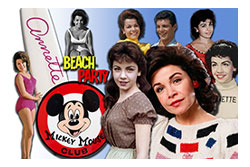 After dancing the lead in Walt Disney's production of Swan Lake at the Starlight Bowl in Burbank, California, in 1955, Funicello was invited by Disney to audition for his new children's show, The Mickey Mouse Club. She landed a part on the show, which premiered in October 1955, when Funicello was just 13 years old, and soon became the series' the most popular "Mouseketeer." Audiences regularly tuned in to watch Funicello and other members of the children's variety show perform song and dance routines in turtle-neck sweaters displaying their names in big block letters, blue skirts/slacks and, most notably, mouse-eared beanies. After dancing the lead in Walt Disney's production of Swan Lake at the Starlight Bowl in Burbank, California, in 1955, Funicello was invited by Disney to audition for his new children's show, The Mickey Mouse Club. She landed a part on the show, which premiered in October 1955, when Funicello was just 13 years old, and soon became the series' the most popular "Mouseketeer." Audiences regularly tuned in to watch Funicello and other members of the children's variety show perform song and dance routines in turtle-neck sweaters displaying their names in big block letters, blue skirts/slacks and, most notably, mouse-eared beanies.
Read More >>>
The actress would later credit the show as her claim to fame and an incredible learning experience, and call Walt Disney her "second father." She once stated, "I've always found Mr. Disney to be somewhat of a shy person, a kid at heart."
 After leaving The Mickey Mouse Club, Annette Funicello remained under contract to Disney and appeared on TV shows such as Zorro (1957) and The Nine Lives of Elfego Baca (1958). She also starred in a number of Disney feature films, including The Shaggy Dog (1959), Babes in Toyland (1961), The Misadventures of Merlin Jones (1964) and The Monkey's Uncle (1965). After leaving The Mickey Mouse Club, Annette Funicello remained under contract to Disney and appeared on TV shows such as Zorro (1957) and The Nine Lives of Elfego Baca (1958). She also starred in a number of Disney feature films, including The Shaggy Dog (1959), Babes in Toyland (1961), The Misadventures of Merlin Jones (1964) and The Monkey's Uncle (1965).
In the early 1960s, Funicello starred in a series of beach party films with Frankie Avalon, including Beach Party (1963), Muscle Beach Party (1964), Bikini Beach (1964), Beach Blanket Bingo (1965) and How to Stuff a Wild Bikini (1965). During this time, she also recorded a series of Top 40 pop singles, including "Tall Paul," "First Name Initial," "How Will I Know My Love" and "Pineapple Princess."
In 1987, Funicello again teamed up with Frankie Avalon to co-produce and star as parents of a pair of troublesome teenagers in Paramount's Back to the Beach. Then, in 1989 and 1990, Avalon and Funicello staged a nostalgic concert tour, performing the beach party music and hit singles they made famous in the 1960s.
In 1992, Funicello announced that she had been battling multiple sclerosis, a degenerative neurological disease, since 1987. To assist in fundraising to fight neurological disorders, the actress founded the Annette Funicello Teddy Bear Company, which markets a line of collectible bears. She also developed her own perfume line, Cello by Annette. A portion of the proceeds from these products goes to the Annette Funicello Research Fund for Neurological Disorders, an organization founded by the actress in 1993.
Annette Funicello died on April 8, 2013, at age 70, at Mercy Southwest Hospital in Bakersfield, California. She was survived by second husband Glen Holt, whom she married in 1986, and three children from her earlier marriage to Jack Gilardi (1965-1981). In her later years, Funicello resided in Encino, a small neighborhood in Los Angeles' San Fernando Valley.
|
|
| |
|
GEORGE HERMAN
"BABE" RUTH |
|
 |
| |
 George Herman "Babe" Ruth (February 6, 1895 – August 16, 1948) was an American professional baseball player whose career in Major League Baseball (MLB) spanned 22 seasons, from 1914 throughm 1935. Nicknamed "the Bambino" and "the Sultan of Swat", he began his MLB career as a star left-handed pitcher for the Boston Red Sox, but achieved his greatest fame as a slugging outfielder for the New York Yankees. George Herman "Babe" Ruth (February 6, 1895 – August 16, 1948) was an American professional baseball player whose career in Major League Baseball (MLB) spanned 22 seasons, from 1914 throughm 1935. Nicknamed "the Bambino" and "the Sultan of Swat", he began his MLB career as a star left-handed pitcher for the Boston Red Sox, but achieved his greatest fame as a slugging outfielder for the New York Yankees.
Ruth is regarded as one of the greatest sports heroes in American culture and is considered by many to be the greatest baseball player of all time. In 1936, Ruth was elected into the Baseball Hall of Fame as one of its "first five" inaugural members.
Read More >>>
As a full-time outfielder with the Yankees, Ruth quickly emerged as the greatest hitter to have ever played the game. Nicknamed by sportswriters the “Sultan of Swat,” in his first season with the Yankees in 1920, he shattered his own single-season record by hitting 54 home runs, 25 more than he had hit in 1919. The next season Ruth did even better: he slammed out 59 homers and drove in 170 runs. In 1922 his salary jumped to $52,000, making him by far the highest-paid player in baseball. That summer he and Helen appeared in public with a new daughter, Dorothy, who was apparently the result of one of his many sexual escapades.
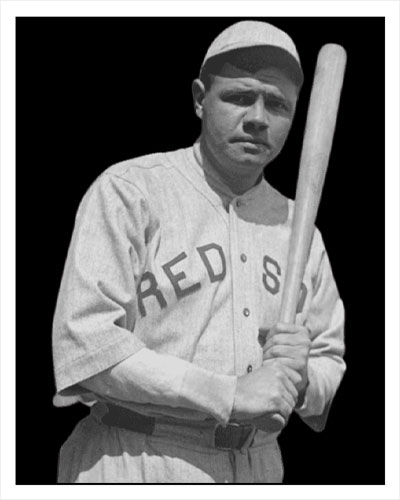 In 1922 Ruth’s home run totals dropped to 35, but in 1923—with the opening of the magnificent new Yankee Stadium, dubbed by a sportswriter “The House That Ruth Built”—he hit 41 home runs, batted .393, and had a record-shattering slugging percentage (total bases divided by at bats) of .764. He continued with a strong season in 1924 when he hit a league-leading 46 home runs, but in 1925, while suffering from an intestinal disorder (thought by many to be syphilis), his offensive production declined sharply. That season, while playing in only 98 games, he hit 25 home runs. In 1922 Ruth’s home run totals dropped to 35, but in 1923—with the opening of the magnificent new Yankee Stadium, dubbed by a sportswriter “The House That Ruth Built”—he hit 41 home runs, batted .393, and had a record-shattering slugging percentage (total bases divided by at bats) of .764. He continued with a strong season in 1924 when he hit a league-leading 46 home runs, but in 1925, while suffering from an intestinal disorder (thought by many to be syphilis), his offensive production declined sharply. That season, while playing in only 98 games, he hit 25 home runs.
He also struggled in his private life. Two years earlier he had met and fallen in love with actress Claire Hodgson, and in 1925 he legally separated from Helen. Helen’s death from a fire in 1929 freed him to marry Hodgson the same year. The couple then formally adopted Dorothy, and Ruth adopted Hodgson’s.
On the field during the 1926 season, Ruth returned to his old form. Indeed, in the 1926–32 seasons Ruth in his offensive output towered over all other players in the game. For those seven seasons he averaged 49 home runs per season, batted in 151 runs, and had a batting average of .353 while taking the Yankees to four league pennants and three World Series championships. In 1927 Ruth’s salary leapt to $70,000. That season he hit 60 home runs, a record that remained unbroken until Roger Maris hit 61 in 1961 (see also Researcher’s Note: Baseball’s problematic single-season home run record). That same season Ruth teamed with Lou Gehrig to form the greatest home-run hitting duo in baseball. Ruth and Gehrig were the heart of the 1927 Yankees team—nicknamed Murderer’s Row—which is regarded by many baseball experts as the greatest team to ever play the game.
The 1932 World Series revealed not only Ruth’s flair for exploiting the moment but produced his famous “called shot” home run. In the third game of the series against Chicago, while being heckled by the Cubs bench, Ruth, according to a story whose accuracy remains in doubt to this day, responded by pointing his finger to the centre-field bleachers. On the very next pitch, Ruth hit the ball precisely into that spot. After 1932 Ruth’s playing skills rapidly diminished. Increasingly corpulent and slowed by age, his offensive numbers dropped sharply in both 1933 and 1934. He wanted to manage the Yankees, but Ruppert, the team’s owner, is reported to have said that Ruth could not control his own behaviour, let alone that of the other players, and so refused to offer him the post. Hoping eventually to become a manager, in 1935 Ruth joined the Boston Braves as a player and assistant manager. But the offer to manage a big-league team never came. Ruth finished his career that season with 714 home runs, a record that remained unblemished until broken by Henry Aaron in 1974.
Later life and legacy of Babe Ruth
In 1936 sportswriters honoured Ruth by selecting him as one of five charter members to the newly established Baseball Hall of Fame in Cooperstown, New York. Ruth was a hopeless spendthrift, but, fortunately for him, in 1921 he met and employed Christy Walsh, a sports cartoonist-turned-agent. Walsh not only obtained huge contracts for Ruth’s endorsement of products but also managed his finances so that Ruth lived comfortably during retirement. During his final years Ruth frequently played golf and made numerous personal appearances on behalf of products and causes but missed being actively involved in baseball. Still, he maintained his popularity with the American public; after his death from throat cancer, at least 75,000 people viewed his body in Yankee Stadium, and some 75,000 attended his funeral service (both inside and outside St. Patrick’s Cathedral).
Ruth was a major figure in revolutionizing America’s national game. While the frequent claim that his feats single-handedly saved the game from a massive public disillusionment that might have otherwise accompanied the Black Sox Scandal of 1919 is an exaggeration, his home-run hitting did revitalize the sport. Prior to Ruth, teams had focused on what they called “scientific” or “inside” baseball—a complicated strategy of employing singles, sacrifices, hit-and-run plays, and stolen bases in order to score one run at a time. But Ruth seemed to make such tactics obsolete; with one mighty swat, he could clear the bases. While no other player in his day compared to Ruth in the ability to hit home runs, soon other players were also swinging harder and more freely. Indeed, Ruth helped to introduce an offensive revolution in baseball. In the 1920s batting averages, home runs, and runs scored soared to new heights. Ruth was also to a large extent responsible for manning the great Yankee dynasty of the 1920s and early 1930s. Between 1921 and 1932 the Yankees won seven pennants and four World Series.
In the 1920s, a decade that produced a galaxy of sports celebrities such as Red Grange in gridiron football and Jack Dempsey in prizefighting, no figure from the world of sport exceeded the public appeal of Ruth. “He has become a national curiosity,” reported The New York Times as early as 1920, “and the sightseeing Pilgrims who daily flock into Manhattan are as anxious to rest eyes on him as they are to see the Woolworth Building.” Each morning men and boys across the United States unfolded their newspapers to see if Ruth had hit yet another home run. Notorious for his enormous appetites for all things of the flesh, Ruth seemed to represent a new era in American history, a time when men and women were freer than they had been in the past to enjoy themselves. He embodied a new model of success. In an increasingly complex world of assembly lines and bureaucracies, Ruth, like other celebrities of the day, leapt to fame and fortune by his sheer natural talents and personal charisma rather than by hard work and self-control. The very words “Ruth” and “Ruthian” entered the American lexicon as benchmarks to describe outstanding performers and performances in all fields of human endeavour. As with no other sports figure in American history except perhaps Muhammad Ali, Ruth continued long after his playing career ended to occupy a towering place in America’s imagination.
|
|
| |
|
LESLIE TOWNES
BOB HOPE |
 |
|
| |
 Leslie Townes "Bob" Hope (May 29, 1903 – July 27, 2003) was a British-born. Leslie Townes "Bob" Hope (May 29, 1903 – July 27, 2003) was a British-born.
American comedian, centenarian, actor, entertainer and producer with a career that spanned nearly 80 years and achievements in vaudeville, network radio, television, and USO Tours. He appeared in more than 70 short and feature films, starring in 54. These included a series of seven Road to... musical comedy fillms with long-time friend Bing Crosby as his partner.
 Presenting the Distinguished Service Medal to Hope in 1946, Past National Commander John R. Quinn called the entertainer "the personal jester of every man and woman in uniform ... Wherever they were - in foxhole, Quonset hut, jungle or warship - he administered the toxin of cheer and laughter. ... He has flown one-half million miles to perform in the din of the front lines as well as in the hush of hospitals." Presenting the Distinguished Service Medal to Hope in 1946, Past National Commander John R. Quinn called the entertainer "the personal jester of every man and woman in uniform ... Wherever they were - in foxhole, Quonset hut, jungle or warship - he administered the toxin of cheer and laughter. ... He has flown one-half million miles to perform in the din of the front lines as well as in the hush of hospitals."
Read More >>>
Hope responded, "I don't have to tell you that this is rather a surprise to me. I didn't read it in the paper until three weeks ago, you know, but it is really wonderful, and I know that (Bing) Crosby will never believe it." Never without a joke, he added, "Of course, he hasn't received anything like this since Gen. Lee gave him his (medal) for leading the retreat from Bull Run."
Hope's beloved Christmas show started in 1948, with his "last one" scheduled in 1972 in Vietnam. But every Christmas after that, he continued to entertain U.S. troops. He spent so much time in the field that Congress made him the nation's first honorary veteran in 1997, at 94.
Called "America's No. 1 Soldier in Greasepaint" and "GI Bob," Hope made a few more public appearances, celebrating his 100th birthday in May 2003. He died two months later.
<> Hope was the fifth of seven sons of a stonemason and a former Welsh concert singer; his family immigrated to the United States when he was four years old. He grew up in Cleveland, Ohio, manifesting the first signs of his vocation at age 10 when he won a Charlie Chaplin imitation contest. After a series of odd jobs, including amateur boxer, Hope during his late teens embarked on an entertainment career and later performed with a succession of partners in vaudeville. He first appeared on Broadway in Sidewalks of New York (1927), and after additional work in vaudeville and a failed Hollywood screen test, he landed his first substantial stage role in the Jerome Kern musical Roberta (1933). During the mid-1930s he starred in a series of comedy shorts and found increasing success in radio, a medium well-suited to his loquacious style. Hope made his feature-film debut in The Big Broadcast of 1938 (1938), in which he first sang his signature tune “Thanks for the Memory,” and he launched the long-running The Bob Hope Show on radio in that same year. By the end of the decade, Hope was one of America’s most popular comics. Hope was the fifth of seven sons of a stonemason and a former Welsh concert singer; his family immigrated to the United States when he was four years old. He grew up in Cleveland, Ohio, manifesting the first signs of his vocation at age 10 when he won a Charlie Chaplin imitation contest. After a series of odd jobs, including amateur boxer, Hope during his late teens embarked on an entertainment career and later performed with a succession of partners in vaudeville. He first appeared on Broadway in Sidewalks of New York (1927), and after additional work in vaudeville and a failed Hollywood screen test, he landed his first substantial stage role in the Jerome Kern musical Roberta (1933). During the mid-1930s he starred in a series of comedy shorts and found increasing success in radio, a medium well-suited to his loquacious style. Hope made his feature-film debut in The Big Broadcast of 1938 (1938), in which he first sang his signature tune “Thanks for the Memory,” and he launched the long-running The Bob Hope Show on radio in that same year. By the end of the decade, Hope was one of America’s most popular comics.
Just as silent films had popularized physical and slapstick comedy, the encroachment of sound motion pictures and radio during the 1930s paved the way for Hope’s style of brash verbal comedy. Although a bug-eyed double take is a familiar Hope trademark, most of his comedy relied on quips and wisecracks delivered at a breakneck pace. His persona was that of transparent bravado, glib repartee, and ingratiating mediocrity—a smart aleck who cowers at the slightest threat. He did not elicit audience sympathy and was less likely to win the girl at the end of a film than he was to wind up the buffoonish victim of some quagmire of his own making. By allowing the audience to feel superior to him, Hope was one of the few comic performers to sustain a successful career built upon a largely unsympathetic character.
Bob Hope with men of X Corps, Wonsan, Korea, 1950.
During World War II Hope traveled extensively to entertain troops overseas and at home; most of his war-era radio shows were broadcast from military bases throughout the world. Because of his similar tours during American military involvement in Korea, Vietnam, and the Persian Gulf over subsequent decades, Hope became as renowned for his armed forces shows as for his accomplishments as an entertainer. In 1997 the U.S. Congress recognized his efforts by naming him the first “Honorary Veteran” in U.S. history. Hope called it “the greatest honor I have ever received.” His other honours and awards included an honorary Commander of the Order of the British Empire (CBE), an honorary British knighthood, the Congressional Gold Medal, the Presidential Medal of Freedom, and five special Academy Awards for humanitarian services and contributions to the film industry.
Awards notwithstanding, Hope endured harsh criticism throughout his career both for his politics and for his reluctance to challenge himself as a performer. As his films became increasingly tired and formulaic in the 1960s, so too did his hawkish politics become out of sync with the American mood during the Vietnam War era. Young Americans, unfamiliar with the glib wisecracking Hope of the 1940s films, now derided him as the embodiment of the “Establishment.” He was probably seen at his best during these years in live performance, where, free from the need to be topical, he could deliver a largely spontaneous show built around the vast mental warehouse of jokes that he had compiled over the decades.
>By the late 1970s Hope’s status as a major comic had been restored somewhat by prominent critics and directors (such as Woody Allen) who lavished praise upon his films of the 1940s and early ’50s. To his harshest critics, Hope will probably remain little more than a capable mouthpiece for his staff of comedy writers. To admirers, he represents a vital component in American comedy history and personifies the comic tastes of the World War II generation, by whom wit and wordplay were highly valued.
|
|
| |
|
CHARLES HARDIN
"BUDDY" HOLLEY |
 |
|
| |
Charles Hardin Holley (September 7, 1936 – February 3, 1959), known as Buddy Holly, was an American singer and songwriter who was a central and pioneering figure of mid-1950s rock and roll. He was born to a musical family in Lubbock, Texas, during the Great Depression, and learned to play guitar and sing alongside his siblings. Holly's style was influenced by gospel music, country music, and rhythm and blues acts, which he performed in Lubbock with his friends from high school.
Read More >>>
Holly made his first appearance on local television in 1952, and the following year he formed the group "Buddy and Bob" with his friend Bob Montgomery. In 1955, after opening for Elvis Presley, Holly decided to pursue a career in music. He opened for Presley three times that year; his band's style shifted from country and western to entirely rock and roll. In October that year, when Holly opened for Bill Haley & His Comets, he was spotted by Nashville scout Eddie Crandall, who helped him get a contract with Decca Records.
Holly's death was memorialized in Don McLean's iconic song "American Pie" as "the day the music died." Holly's music never really died, though, despite the singer's tragic and untimely death.
On February 3, 1959, American rock and roll musicians Buddy Holly, Ritchie Valens, and "The Big Bopper" J. P. Richardson were all killed in a plane crash near Clear Lake, Iowa, together with pilot Roger Peterson.
At the time, Holly and his band, consisting of Waylon Jennings, Tommy Allsup, and Carl Bunch, were playing on the "Winter Dance Party" tour across the Midwest. Rising artists Valens, Richardson, and vocal group Dion and the Belmonts had joined the tour as well. The long journeys between venues on board the cold, uncomfortable tour buses adversely affected the performers, with cases of flu and even frostbite.
After stopping at Clear Lake to perform, and frustrated by the conditions on the tour buses, Holly chose to charter a plane to reach their next venue in Moorhead, Minnesota. Richardson, suffering from flu, swapped places with Jennings, taking his seat on the plane, while Allsup lost his seat to Valens on a coin toss. Soon after takeoff, late at night and in poor, wintry weather conditions, the pilot lost control of the light aircraft, a Beechcraft Bonanza, which crashed into a cornfield, killing all four on board.
|
|
| |
|
DORIS MARY ANNE KAPPELHOFF
DORIS DAY |
 |
|
 |
| President Medal Of Freedom |
|
| |
 Doris Day (born Doris Mary Anne Kappelhoff; April 3, 1922 – May 13, 2019) Doris Day (born Doris Mary Anne Kappelhoff; April 3, 1922 – May 13, 2019)
Ms. Day began her career as a big-band vocalist, and she was successful almost from the start: One of her first records, “Sentimental Journey,” released in 1945, sold more than a million copies, and she went on to have numerous other hits.
The bandleader Les Brown, with whom she sang for several years, once said, “As a singer Doris belongs in the company of Bing Crosby and Frank Sinatra.”
But it was the movies that made her a star.
Read More >>>
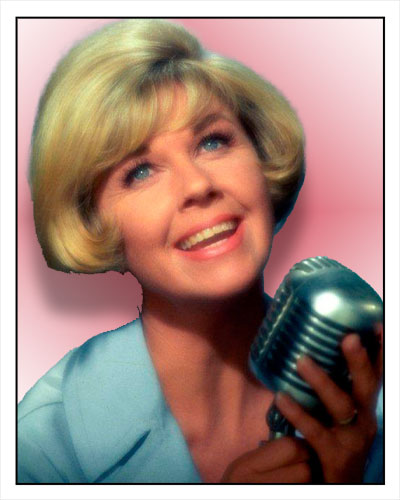 Between “Romance on the High Seas” in 1948 and “With Six You Get Eggroll” in 1968, she starred in nearly 40 movies. On the screen she turned from the perky girl next door in the 1950s to the woman next door in a series of 1960s sex comedies that brought her four first-place rankings in the yearly popularity poll of theater owners, an accomplishment equaled by no other actress except Shirley Temple. Between “Romance on the High Seas” in 1948 and “With Six You Get Eggroll” in 1968, she starred in nearly 40 movies. On the screen she turned from the perky girl next door in the 1950s to the woman next door in a series of 1960s sex comedies that brought her four first-place rankings in the yearly popularity poll of theater owners, an accomplishment equaled by no other actress except Shirley Temple.
In the 1950s she starred, and most often sang, in comedies (“Teacher’s Pet,” “The Tunnel of Love”), musicals (“Calamity Jane,” “April in Paris,” “The Pajama Game”) and melodramas (“Young Man With a Horn,” the Alfred Hitchcock thriller “The Man Who Knew Too Much,” “Love Me or Leave Me”).
She went on to appear in “Pillow Talk” (1959), “Lover Come Back” (1961) a nd “That Touch of Mink” (1962), fast-paced comedies in which she fended off the advances of Rock Hudson (in the first two films) and Cary Grant (in the third). Those movies, often derided today as examples of the repressed sexuality of the ’50s, were considered daring at the time. nd “That Touch of Mink” (1962), fast-paced comedies in which she fended off the advances of Rock Hudson (in the first two films) and Cary Grant (in the third). Those movies, often derided today as examples of the repressed sexuality of the ’50s, were considered daring at the time.
“I suppose she was so clean-cut, with perfect uncapped teeth, freckles and turned-up nose, that people just thought she fitted the concept of a virgin,” Mr. Hudson once said of Ms. Day. “But when we began ‘Pillow Talk’ we thought we’d ruin our careers because the script was pretty daring stuff.” The movie’s plot, he said, “involved nothing more than me trying to seduce Doris for eight reels.”
(Ms. Day and Mr. Hudson remained close. Not long before his death from AIDS in 1985, he appeared with her on her television show “Doris Day’s Best Friends” and at a news conference. “He was very sick,” Ms. Day said. “But I just brushed that off and I came out and put my arms around him and said, ‘Am I glad to see you.’ ”)
Ms. Day in fact was one of the few actresses of the 1950s and ’60s to play women who had a real profession, and her characters were often more passionate about their career than about their co-stars.
“My public image is unshakably that of America’s wholesome virgin, the girl next door, carefree and brimming with happiness,” she said in “Doris Day: Her Own Story,” a 1976 book by A. E. Hotchner based on a series of interviews he conducted with Ms. Day. “An image, I can assure you, more make-believe than any film part I ever played. But I am Miss Chastity Belt, and that’s all there is to it.”
An Aspiring Dancer
Doris Day was born Doris Mary Anne Kappelhoff in Cincinnati on April 3, 1922. (For years most sources gave her birth year as 1924, and so did she. But shortly before her birthday in 2017, The Associated Press obtained a copy of her birth certificate from the Ohio Office of Vital Statistics and established that she had been born two years earlier. After Ms. Day was shown the evidence, she said in a statement, “I’ve always said that age is just a number and I have never paid much attention to birthdays, but it’s great to finally know how old I really am.”) She was the second child of Frederick William von Kappelhoff, a choral master and piano teacher who later managed restaurants and taverns in Cincinnati, and Alma Sophia (Welz) Kappelhoff. Her parents separated when she was a child.
Ms. Day never wanted to be a movie star. At 15 she was a good enough dancer to win the $500 first prize in an amateur contest. Her mother and the parents of her 12-year-old partner used the money to take them both to Los Angeles for professional dancing lessons. The families intended to move west permanently, but Doris’s right leg was shattered when the automobile in which she was riding was hit by a train.
To distract Doris during the year it took the leg to mend, her mother — who had named her after a movie star, Doris Kenyon — paid for singing lessons. She was a natural.
And when Ms. Day opened her mouth to sing, the effect was magical. She had a perfectly controlled voice that brimmed with emotion. “It’s Magic,” which she sang in “Romance on the High Seas,” and “I’ll Never Stop Loving You,” which she sang in “Love Me or Leave Me,” were nominated for Academy Awards for best song. The two with which she is especially identified, “Secret Love,” from “Calamity Jane,” and “Que Sera, Sera,” from “The Man Who Knew Too Much,” won Oscars.
Ms. Day, who summed up her fatalistic philosophy in the words of one of her biggest hits, “Que Sera, Sera” (“What will be, will be”), never liked unhappy endings. She told one interviewer: “It upsets me when the hero or heroine dies. I would like them to live happily ever after.”
But, except in movies, nobody lives happily ever after. Ms. Day told Mr. Hotchner: “During the painful and bleak periods I’ve suffered through these past years, my animal family has been a source of joy and strength to me. I have found that when you are deeply troubled, there are things you get from the silent, devoted companionship of your pets that you can get from no other source.”
“I have never found in a human being,” she added, “loyalty comparable to that of any pet.”
|
|
| |
|
John Henry Holliday
better known as Doc Holliday |
 |
|
| |
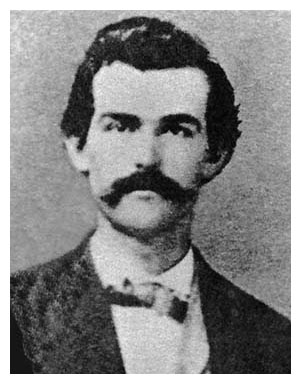 John Henry Holliday (August 14, 1851 – November 8, 1887), better known as Doc Holliday, was an American dentist, gambler, and gunfighter who was a close friend and associate of lawman Wyatt Earp. Holliday is best known for his role in the events surrounding and his participation in the gunfight at the O.K. Corral in Tombstone, Arizona. He developed a reputation as having killed more than a dozen men in various altercations, but modern researchers have concluded that, contrary to popular myth-making, Holliday killed only one to three men. Holliday's colorful life and character have been depicted in many books and portrayed by well-known actors in numerous movies and television series. John Henry Holliday (August 14, 1851 – November 8, 1887), better known as Doc Holliday, was an American dentist, gambler, and gunfighter who was a close friend and associate of lawman Wyatt Earp. Holliday is best known for his role in the events surrounding and his participation in the gunfight at the O.K. Corral in Tombstone, Arizona. He developed a reputation as having killed more than a dozen men in various altercations, but modern researchers have concluded that, contrary to popular myth-making, Holliday killed only one to three men. Holliday's colorful life and character have been depicted in many books and portrayed by well-known actors in numerous movies and television series.
Read More >>>
At age 20, Holliday earned a degree in dentistry from the Pennsylvania College of Dental Surgery. He set up practice in Griffin, Georgia, but he was soon diagnosed with tuberculosis, the same disease that had claimed his mother when he was 15 and his sister before his birth, having acquired it while tending to his mother's needs. Hoping the climate in the American Southwest would ease his symptoms, he moved to that region and became a gambler, a reputable profession in Arizona in that day. Over the next few years, he reportedly had several confrontations. He saved Wyatt Earp's life during a saloon confrontation in Texas, and they became friends. In 1879, he joined Earp in Las Vegas, New Mexico, and then rode with him to Prescott, Arizona, and then Tombstone. While in Tombstone, local members of the outlaw Cochise County Cowboys repeatedly threatened him and spread rumors that he had robbed a stagecoach. On October 26, 1881, Holliday was deputized by Tombstone city marshal Virgil Earp. The lawmen attempted to disarm five members of the Cowboys near the O.K. Corral on the west side of town, which resulted in the famous shootout.
Following the Tombstone shootout, Virgil Earp was maimed by hidden assailants while Morgan Earp was killed. Unable to obtain justice in the courts, Wyatt Earp took matters into his own hands. As the recently appointed deputy U.S. marshal, Earp formally deputized Holliday, among others. As a federal posse, they pursued the outlaw Cowboys they believed were responsible. They found Frank Stilwell lying in wait as Virgil boarded a train for California and Wyatt Earp killed him. The local sheriff issued a warrant for the arrest of five members of the federal posse, including Holliday. The federal posse killed three other Cowboys during late March and early April 1882, before they rode to the New Mexico Territory. Wyatt Earp learned of an extradition request for Holliday and arranged for Colorado Governor Frederick Walker Pitkin to deny Holliday's extradition. Holliday spent the few remaining years of his life in Colorado. He died of tuberculosis in his bed at the Hotel Glenwood at age 36.
|
|
| |
| |
|
ELIZABETH VICTORIA MONTGOMERY |
 |
|
| |
 Elizabeth Victoria Montgomery (April 15, 1933 – May 18, 1995) was an American actress whose career spanned five decades in film, stage, and television. She portrayed the good witch Samantha Stephens on the popular television series Bewitched, which earned her five Primetime Emmy Award nominations and four Golden Globe Award nominations. Elizabeth Victoria Montgomery (April 15, 1933 – May 18, 1995) was an American actress whose career spanned five decades in film, stage, and television. She portrayed the good witch Samantha Stephens on the popular television series Bewitched, which earned her five Primetime Emmy Award nominations and four Golden Globe Award nominations.
Montgomery suffered from colon cancer. She ignored the influenza-like symptoms during the filming of Deadline for Murder: From the Files of Edna Buchanan, which she finished filming in late March 1995. Due to the late diagnosis, the cancer metastasized from her colon to her liver.
With no hope of recovery and unwilling to die in a hospital, Montgomery chose to return to her Beverly Hills home that she shared with Foxworth. She died on the morning of May 18, 1995, at the age of 62, surrounded by Foxworth and her three children from her previous marriage to William Asher. |
|
| |
|
ELVIS PRESLEY |
 |
|
| |
Elvis Presley (born January 8, 1935, Tupelo, Mississippi, U.S.—died August 16, 1977, Memphis, Tennessee) American popular singer widely known as the “King of Rock and Roll” and one of rock music’s dominant  performers from the mid-1950s until his death. performers from the mid-1950s until his death.
Presley grew up dirt-poor in Tupelo, Mississippi, moved to Memphis as a teenager, and, with his family, was off welfare for only a few weeks when producer Sam Phillips at Sun Records, a local blues label, responded to his audition tape with a phone call.
Read More >>>
Several weeks worth of recording sessions ensued with a band consisting of Presley, guitarist Scotty Moore, and bassist Bill Black.
Their repertoire consisted of the kind of material for which Presley would become famous: blues and country songs, Tin Pan Alley ballads, and gospel hymns.
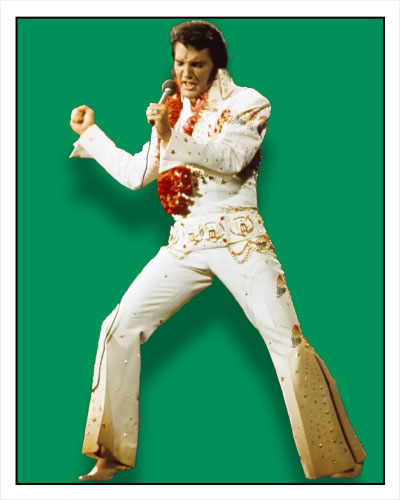 Presley knew some of this music from the radio, some of it from his parents’ Pentecostal church and the group sings he attended at the Rev. H.W. Brewster’s Black Memphis church, and some of it from the Beale Street blues clubs he began frequenting as a teenager. Presley knew some of this music from the radio, some of it from his parents’ Pentecostal church and the group sings he attended at the Rev. H.W. Brewster’s Black Memphis church, and some of it from the Beale Street blues clubs he began frequenting as a teenager.
Presley was already a flamboyant personality, with relatively long greased-back hair and wild-coloured clothing combinations, but his full musical personality did not emerge until he and the band began playing with blues singer Arthur (“Big Boy”) Crudup’s song “That’s All Right Mama” in July 1954. They arrived at a startling synthesis, eventually dubbed rockabilly, retaining many of the original’s blues inflections but with Presley’s high tenor voice adding a lighter touch and with the basic rhythm striking a much more supple groove. This sound was the hallmark of the five singles Presley released on Sun over the next year. Although none of them became a national hit, by August 1955, when he released the fifth, “ Mystery Train,” arguably his greatest record ever, he had attracted a substantial Southern following for his recordings, his live appearances in regional roadhouses and clubs, and his radio performances on the nationally aired Louisiana Hayride. (A key musical change came when drummer D.J. Fontana was added, first for the Hayride shows but also on records beginning with “Mystery Train.”)
Colonel Tom Parker and national celebrity
Presley’s management was then turned over to Colonel Tom Parker, a country music hustler who had made stars of Eddy Arnold and Hank Snow. Parker arranged for Presley’s song catalog and recording contract to be sold to major New York City-based enterprises, Hill and Range and RCA Victor, respectively. Sun received a total of $35,000; Elvis got $5,000. He began recording at RCA’s studios in Nashville, Tennessee, with a somewhat larger group of musicians but still including Moore, Black, and Fontana, and began to create a national sensation with a series of hits: “ Heartbreak Hotel,” “Don’t Be Cruel,” and “Love Me Tender” (all 1956), “All Shook Up” (1957), and more.
From 1956 through 1958 he completely dominated the pop music charts and ushered in the age of rock and roll, opening doors for both white and Black rock artists. His television appearances, especially those on Ed Sullivan’s Sunday night variety show, set records for the size of the audiences. Even his films, a few slight vehicles, were box office smashes.
Presley’s immediate influence and impact
Presley became the teen idol of his decade, greeted everywhere by screaming hordes of young women, and, when it was announced in early 1958 that he had been drafted and would enter the U.S. Army, there was that rarest of all pop culture events, a moment of true grief. More important, he served as the great cultural catalyst of his period. Elvis projected a mixed vision of humility and self-confidence, of intense commitment and comic disbelief in his ability to inspire frenzy. He inspired literally thousands of musicians—initially those more or less like-minded Southerners, from Jerry Lee Lewis and Carl Perkins on down, who were the first generation of rockabillies, and, later, people who had far different combinations of musical and cultural influences and ambitions. From John Lennon to Bruce Springsteen, Bob Dylan to Prince, it was impossible to think of a rock star of any importance who did not owe an explicit debt to Presley.
Beyond even that, Presley inspired his audience. “It was like he whispered his dream in all our ears and then we dreamed it,” said Springsteen at the time of Presley’s death. You did not have to want to be a rock and roll star or even a musician to want to be like Elvis—which meant, ultimately, to be free and uninhibited and yet still a part of the everyday. Literally millions of people—an entire generation or two—defined their sense of personal style and ambition in terms that Elvis first personified.
As a result, he was anything but universally adored. Those who did not worship him found him despicable (no one found him ignorable). Preachers and pundits declared him an anathema, his Pentecostally derived hip-swinging stage style and breathy vocal asides obscene. Racists denounced him for mingling Black music with white (and Presley was always scrupulous in crediting his Black sources, one of the things that made him different from the Tin Pan Alley writers and singers who had for decades lifted Black musical styles without credit). He was pronounced responsible for all teenage hooliganism and juvenile delinquency. Yet, in every appearance on television, he appeared affable, polite, and soft-spoken, almost shy. It was only with a band at his back and a beat in his ear that he became “Elvis the Pelvis.”
Military service, movies, and mainstreaming
In 1959, while stationed in West Germany—where he served as a soldier rather than joining the Special Services entertainment division—Presley met Priscilla Beaulieu, who was 14 years old at the time (Presley was 24). They started a romantic relationship that continued after Presley returned to the United States in 1960. When he resumed his musical career, those who regarded him as commercial hype without talent expected him to fade away. Instead, he continued to have hits from recordings stockpiled just before he entered the army.
Presley picked up pretty much where he had left off, churning out a series of more than 30 movies (from Blue Hawaii [1961] to Change of Habit [1969]) over the next eight years, almost none of which fit any genre other than “Elvis movie,” which meant a light comedic romance with musical interludes. Most had accompanying soundtrack albums, and together the movies and the records made him a rich man, although they nearly ruined him as any kind of artist. Presley did his best work in the 1960s on singles either unconnected to the films or only marginally stuck into them, recordings such as “It’s Now or Never (‘O Sole Mio’)” (1960), “Are You Lonesome Tonight?” and “ Little Sister” (both 1961), “Can’t Help Falling in Love” and “ Return to Sender” (both 1962), and “ Viva Las Vegas” (1964). Presley was no longer a controversial figure: he had become one more predictable mass entertainer, a personage of virtually no interest to the rock audience that had expanded so much with the advent of the new sounds of the Beatles, the Rolling Stones, and Bob Dylan.
Elvis: The Comeback Special Elvis Presley in the TV special Elvis: The Comeback Special (1968).
By 1968 the changes in the music world had overtaken Presley—both movie grosses and record sales had fallen. In December his one-man Christmas TV special aired: a tour de force of rock and roll and rhythm and blues, it restored much of his dissipated credibility. In 1969 he released a single having nothing to do with a film, “ Suspicious Minds”; it went to number one. He also began doing concerts again and quickly won back a sizable following, although it was not nearly as universal as his audience in the 1950s; in the main, it was Southern and Midwestern, working-class, and overwhelmingly female. For much of the next decade, he was again one of the top live attractions in the United States. (For a variety of reasons, he never performed outside North America.) Presley was now a mainstream American entertainer, an icon but not so much an idol.
Priscilla Presley and Elvis Presley on their wedding day in Las Vegas, 1967.
In 1967 he married Priscilla Beaulieu without much furor. The next year he became a parent with the birth of their daughter, Lisa Marie Presley. Elvis Presley and Priscilla Presley eventually grew apart separating in 1972 and divorcing the following year.
Presley made no more movies, although there was a good concert film, Elvis on Tour (1972). His recordings were of uneven quality, but on each album he included a song or two that had focus and energy. Hit songs were harder to come by—“Suspicious Minds” was his last number one and “ Burning Love” (1972) his final Top Ten entry. But, thanks to concerts, spectaculars best described by critic Jon Landau as an apotheosis of American musical comedy, he remained a big money earner. He now lacked the ambition and power of his early work, but that may have been a good thing: he never seemed a dated relic of the 1950s trying to catch up to trends but was just a performer, unrelentingly himself.
However, Presley had also developed a lethal lifestyle. Spending almost all his time when not on the road in Graceland, his Memphis estate (actually just a big Southern colonial house decorated somewhere between banal modernity and garish faux-Vegas opulence), he lived nocturnally, surrounded by sycophants and stuffed with greasy foods and a variety of prescription drugs. His shows deteriorated in the final two years of his life, and his recording career came to a virtual standstill. Presley never seemed confident in his status, never entirely certain that he would not collapse back into sharecropper poverty, and, as a result, he seems to have become immobilized; the man who had risked everything, including potential ridicule, to make himself a success now lived in the lockstep regimen of an addict and recluse. Finally, in the summer of 1977, the night before he was to begin yet another concert tour, he died of a heart attack brought on largely by drug abuse. He was 42 years old.
 Almost immediately upon hearing of his death, mourners from around the world gathered at Graceland to say farewell to the poor boy who had lived out the American dream. In a way, that mourning has never ceased: Graceland remains one of the country’s top tourist attractions, and Presley’s albums and other artifacts continue to sell briskly. Each August crowds flock to Graceland—which, under the direction of Priscilla Presley, first opened to the public in 1982—to honour him on the anniversary not of his birth but of his death. From time to time, rumours cropped up that he did not really die, that his death was a fake designed to free him from fame. Elvis impersonators are legion. His biggest fans—working-class white women, almost exclusively—passed their fanaticism on to their children, or at least to a surprising number of daughters. “Elvis has left the building,” but those who are still inside have decided to carry on regardless. Once more, Elvis Presley is triumphant, although this triumph is shadowed by something far less than happiness. Almost immediately upon hearing of his death, mourners from around the world gathered at Graceland to say farewell to the poor boy who had lived out the American dream. In a way, that mourning has never ceased: Graceland remains one of the country’s top tourist attractions, and Presley’s albums and other artifacts continue to sell briskly. Each August crowds flock to Graceland—which, under the direction of Priscilla Presley, first opened to the public in 1982—to honour him on the anniversary not of his birth but of his death. From time to time, rumours cropped up that he did not really die, that his death was a fake designed to free him from fame. Elvis impersonators are legion. His biggest fans—working-class white women, almost exclusively—passed their fanaticism on to their children, or at least to a surprising number of daughters. “Elvis has left the building,” but those who are still inside have decided to carry on regardless. Once more, Elvis Presley is triumphant, although this triumph is shadowed by something far less than happiness.
|
|
| |
|
GENE AUTRY |
 |
|
| |
 Orvon Grover "Gene" Autry (September 29, 1907 – October 2, 1998) The next year he signed a contract with Republic Pictures and began making westerns. Autry--for better or worse--pretty much ushered in the era of the "singing cowboy" westerns of the 1930s and 1940s (in spite of the presence in his oaters of automobiles, radios and airplanes). Orvon Grover "Gene" Autry (September 29, 1907 – October 2, 1998) The next year he signed a contract with Republic Pictures and began making westerns. Autry--for better or worse--pretty much ushered in the era of the "singing cowboy" westerns of the 1930s and 1940s (in spite of the presence in his oaters of automobiles, radios and airplanes).
These films often grossed ten times their average $50,000 production costs. During World War II he enlisted in the US Army and was assigned as a flight officer from 1942-46 with the Air Transport Command. After his military service he returned to making movies, this time with Columbia Pictures, and finally with his own company, Flying A Productions, which, during the 1950s, produced his TV series The Gene Autry Show (1950), The Adventures of Champion (1955), and Annie Oakley (1954).
Read More >>>
He wrote over 200 songs. A savvy businessman, he retired from acting in the early 1960s and became a multi-millionaire from his investments in hotels, real estate, radio stations and the California Angels professional baseball team.
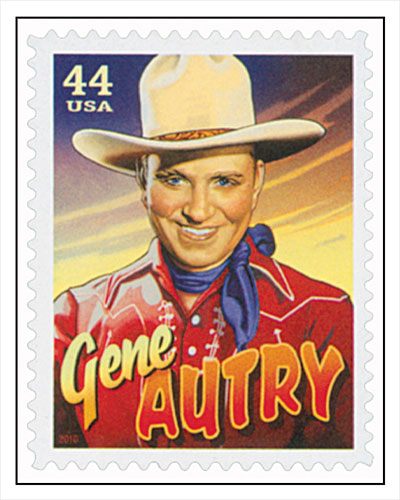 Composer, songwriter ("Back in the Saddle Again","That Silver Haired Daddy of Mine"), actor, author and businessman, educated at Ravia (Oklahoma) High School. In World War he was a flight officer for the United States Army Air Force. He won the National Parents-Teachers Film Award for the films and television programs he produced. He joined ASCAP in 1939, and his other popular-song compositions include: "Here Comes Santa Claus"; "Be Honest With Me"; "Tears on My Pillow"; "Dixie Cannonball"; "Good Old-Fashioned Hoedown"; "You're the Only Star in My Blue Heaven"; and "I Wish I Had Never Met Sunshine". Composer, songwriter ("Back in the Saddle Again","That Silver Haired Daddy of Mine"), actor, author and businessman, educated at Ravia (Oklahoma) High School. In World War he was a flight officer for the United States Army Air Force. He won the National Parents-Teachers Film Award for the films and television programs he produced. He joined ASCAP in 1939, and his other popular-song compositions include: "Here Comes Santa Claus"; "Be Honest With Me"; "Tears on My Pillow"; "Dixie Cannonball"; "Good Old-Fashioned Hoedown"; "You're the Only Star in My Blue Heaven"; and "I Wish I Had Never Met Sunshine".
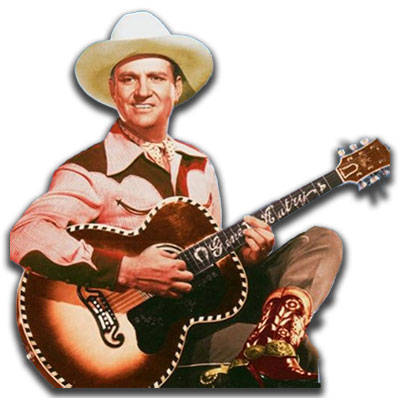 Orvon Gene Autry is considered by many to be the greatest western star of all time. He earned the designation of "America's Favorite Cowboy". He was "discovered" by Will Rogers while working as a telegrapher. One of his stars on the Walk of fame is for Live Performance (including rodeo), not live theater. Also, "That Silver-Haired Daddy of Mine" sold over 500,000 copies in its first release. He is the first artist in history to have a gold record. Also, he is also the first artist to ever sell 1,000,000 copies of a record - "That Silver-Haired Daddy of Mine". He was also the first artist ever to sell out Madison Square Garden. His song "Rudolph the Red-Nosed Reindeer" is the second highest selling Christmas song of all time. It has sold over 30 million copies. Orvon Gene Autry is considered by many to be the greatest western star of all time. He earned the designation of "America's Favorite Cowboy". He was "discovered" by Will Rogers while working as a telegrapher. One of his stars on the Walk of fame is for Live Performance (including rodeo), not live theater. Also, "That Silver-Haired Daddy of Mine" sold over 500,000 copies in its first release. He is the first artist in history to have a gold record. Also, he is also the first artist to ever sell 1,000,000 copies of a record - "That Silver-Haired Daddy of Mine". He was also the first artist ever to sell out Madison Square Garden. His song "Rudolph the Red-Nosed Reindeer" is the second highest selling Christmas song of all time. It has sold over 30 million copies.
In 1940, he was the 4th highest grossing box office attraction according to Theater Exhibitors of America. The only stars above him were Mickey Rooney, Clark Gable, and Spencer Tracy. By 1948, Dell Publishing was printing over 1,000,000 Gene Autry Comic Books per year. Gene Autry was #49 on CMT's 50 Greatest Men of Country Music, and he also had 2 songs on CMT's 100 Greatest Songs Of Country. Everything Gene touched seemed to turn to gold. After he retired from acting, he had many successful business ventures, including radio and television stations. He also owned the California Angels. When he sold part of his interest to Disney, they became the Anaheim Angels. He was Vice President of The American League until his death. Sadly, he never got to see his beloved Angels win the World Series. The team even retired Gene's number "26". He has a town named after him -- Gene Autry, Oklahoma. They host a festival/celebration every year. Gene died in 1998 from lymphoma.
|
|
| |
|
HENRY JOHN DEUTSCHENDORF JR.
JOHN DENVER |
 |
|
| |
 Henry John Deutschendorf Jr. (December 31, 1943 – October 12, 1997), known professionally as John Denver, was an American singer and songwriter. He was one of the most popular acoustic artists of the 1970s and one of the best-selling artists in that decade. AllMusic has called Denver "among the most beloved entertainers of his era". Henry John Deutschendorf Jr. (December 31, 1943 – October 12, 1997), known professionally as John Denver, was an American singer and songwriter. He was one of the most popular acoustic artists of the 1970s and one of the best-selling artists in that decade. AllMusic has called Denver "among the most beloved entertainers of his era".
Denver recorded and released approximately 300 songs, about 200 of which he wrote himself. He had 33 albums and singles that were certified Gold and Platinum in the U.S by the RIAA, with estimated sales of more than 33 million units. He recorded and performed primarily with an acoustic guitar and sang about his joy in nature, disdain for city life, enthusiasm for music, and relationship trials. Denver's music appeared on a variety of charts, including country music, the Billboard Hot 100, and adult contemporary, earning 12 gold and four platinum albums with his signature songs "Take Me Home, Country Roads", "Poems, Prayers & Promises", "Annie's Song", "Rocky Mountain High", "Calypso", "Thank God I'm a Country Boy", and "Sunshine on My Shoulders".
Read More >>>
Denver appeared in several films and television specials during the 1970s and 1980s, including the 1977 hit Oh, God!, in which he starred alongside George Burns. He continued to record into the 1990s, also focusing on environmental issues as well as lending vocal support to space exploration and testifying in front of Congress to protest censorship in music. Known for his love of Colorado, Denver lived in Aspen for much of his life. In 1974, Denver was named poet laureate of the state. The 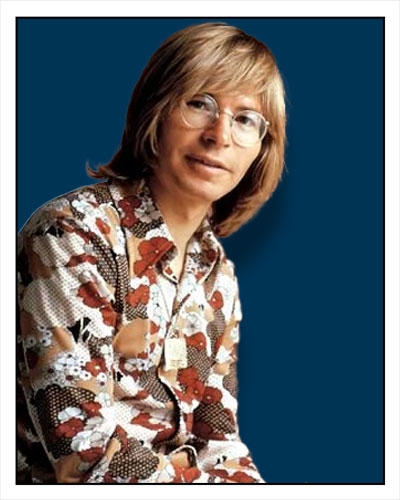 Colorado state legislature also adopted "Rocky Mountain High" as one of its two state songs in 2007, and West Virginia did the same for "Take Me Home, Country Roads" in 2014. Colorado state legislature also adopted "Rocky Mountain High" as one of its two state songs in 2007, and West Virginia did the same for "Take Me Home, Country Roads" in 2014.
Denver died on the afternoon of October 12, 1997, when his light homebuilt aircraft, a Rutan Long-EZ with registration number N555JD, crashed into Monterey Bay near Pacific Grove, California, while making a series of touch-and-go landings at the nearby Monterey Peninsula Airport. He was the plane's only occupant. The official cause of death was multiple blunt force trauma resulting from the crash.
Denver was a pilot with over 2,700 hours of experience. He had pilot ratings for single-engine land and sea, multi-engine land, glider and instrument. Denver also held a type rating in his Learjet. He had recently purchased the Long-EZ aircraft, made by someone else from a kit,[61] and had taken a half-hour checkout flight with the aircraft the day before his accident.
Denver was not legally permitted to fly at the time of the crash. In previous years, he had been arrested several times for drunk driving. In 1996, nearly a year before the accident, the FAA learned that Denver had failed to maintain sobriety by not refraining entirely from alcohol and revoked his medical certification. However, it was determined that the crash was not caused or influenced by alcohol use; an autopsy found no signs of alcohol or other drugs in Denver's body.
The post-accident investigation by the National Transportation Safety Board (NTSB) showed that the leading cause of the accident was Denver's inability to switch fuel tanks during flight. The quantity of fuel had been depleted during the plane's flight to Monterey and in several brief practice takeoffs and landings Denver performed at the airport immediately before the final flight. His newly purchased amateur-built Rutan aircraft had an unusual fuel tank selector valve handle configuration. The handle had originally been intended by the plane's designer to be between the pilot's legs. The builder instead put it behind the pilot's left shoulder. The fuel gauge was also placed behind the pilot's seat and was not visible to the person at the controls. An NTSB interview with the aircraft mechanic servicing Denver's plane revealed that he and Denver had discussed the inaccessibility of the cockpit fuel selector valve handle and its resistance to being turned.
Before the flight, Denver and the mechanic had attempted to extend the reach of the handle using a pair of Vise-Grip pliers, but this did not solve the problem, and the pilot still could not reach the handle while strapped into his seat. NTSB officials' post-accident investigation showed that because of the fuel selector valves' positioning, switching fuel tanks required the pilot to turn his body 90 degrees to reach the valve. This created a natural tendency to extend one's right foot against the right rudder pedal to support oneself while turning in the seat, which caused the aircraft to yaw (nose right) and pitch up.
The mechanic said that he told Denver that the fuel sight gauges were visible only to the rear cockpit occupant. Denver had asked how much fuel was shown. He told Denver that there was "less than half in the right tank and less than a quarter in the left tank". He then provided Denver with an inspection mirror so he could look over his shoulder at the fuel gauges. The mirror was later recovered from the wreckage. Denver said that he would use the autopilot in flight to hold the airplane level while he turned the fuel selector valve. He turned down an offer to refuel the aircraft, saying that he would only be flying for about an hour.
The NTSB interviewed 20 witnesses about Denver's last flight. Six of them had seen the plane crash into the bay near Point Pinos. Four said the aircraft was originally heading west. Five said that they saw the plane in a steep bank, with four saying that the bank was to the right (north). Twelve described seeing the aircraft in a steep nose-down descent. Witnesses estimated the plane's altitude between 350 and 500 feet (110 and 150 m) when heading toward the shoreline. Eight said they heard a "pop" or "backfire" accompanied by a reduction in the engine noise level just before the plane crashed into the sea.
In addition to Denver's failing to refuel and his subsequent loss of control while attempting to switch fuel tanks, the NTSB determined other key factors that led to the accident. Foremost among these was his inadequate transition training on this type of aircraft and the builder's decision to put the fuel selector handle in a hard-to-reach place. The board issued recommendations on the requirement and enforcement of mandatory training standards for pilots operating home-built aircraft. It also emphasized the importance of mandatory ease of access to all controls, including fuel selectors and fuel gauges, in all aircraft.
|
|
 |
|
JOHNNY CASH |
 |
|
| |
| Johnny Cash
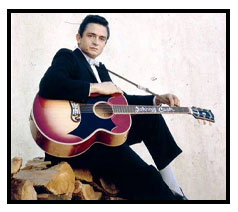 John R. Cash (born J. R. Cash; February 26, 1932 – September 12, 2003) was an American country singer-songwriter. Most of Cash's music contains themes of sorrow, moral tribulation, and redemption, especially songs from the later stages of his career. He was known for his deep, calm, bass-baritone voice, the distinctive sound of his Tennessee Three backing band that was characterized by its train-like chugging guitar rhythms, a rebelliousness coupled with an increasingly somber and humble demeanor, and his free prison concerts. Cash wore a trademark all-black stage wardrobe, which earned him the nickname as the "Man in Black". John R. Cash (born J. R. Cash; February 26, 1932 – September 12, 2003) was an American country singer-songwriter. Most of Cash's music contains themes of sorrow, moral tribulation, and redemption, especially songs from the later stages of his career. He was known for his deep, calm, bass-baritone voice, the distinctive sound of his Tennessee Three backing band that was characterized by its train-like chugging guitar rhythms, a rebelliousness coupled with an increasingly somber and humble demeanor, and his free prison concerts. Cash wore a trademark all-black stage wardrobe, which earned him the nickname as the "Man in Black".
Read More >>>
Born to poor cotton farmers in Kingsland, Arkansas, Cash grew up on gospel music and played on a local radio station in high school. He served four years in the Air Force, much of it in West Germany. After his return to the United States, he rose to fame during the mid-1950s in the burgeoning rockabilly scene in Memphis, Tennessee. He traditionally began his concerts by introducing himself with "Hello, I'm Johnny Cash". He began to follow that by "Folsom Prison Blues", one of his signature songs. His other signature songs include "I Walk the Line", "Ring of Fire", "Get Rhythm", and "Man in Black". He also recorded humorous numbers like "One Piece at a Time" and "A Boy Named Sue", a duet with his future wife June called "Jackson" (followed by many further duets after they married), and railroad songs such as "Hey, Porter", "Orange Blossom Special", and "Rock Island Line".
Cash is one of the best-selling music artists of all time, having sold more than 90 million records worldwide. His genre-spanning music embraced country, rock and roll, rockabilly, blues, folk, and gospel sounds. This crossover appeal earned him the rare honor of being inducted into the Country Music, Rock and Roll, and Gospel Music Halls of Fame.
|
|
| |
|
MARION ROBERT MORRISON
JOHN WAYNE |
 |
|
| |
I am an old-fashioned honest-to-goodness
flag-waving patriot.” John Wayne
 Marion Robert Morrison (May 26, 1907 – June 11, 1979), professionally known as John Wayne and nicknamed The Duke or Duke Wayne, was an American actor who became a popular icon through his starring roles in films which were produced during Hollywood's Golden Age, especially through his starring roles in Western and war movies. Marion Robert Morrison (May 26, 1907 – June 11, 1979), professionally known as John Wayne and nicknamed The Duke or Duke Wayne, was an American actor who became a popular icon through his starring roles in films which were produced during Hollywood's Golden Age, especially through his starring roles in Western and war movies.
His career flourished from the silent era of the 1920s through the American New Wave, as he appeared in a total of 179 film and television productions. He was among the top box-office draws for three decades, and appeared with many other important Hollywood stars of his era. In 1999, the American Film Institute selected Wayne as one of the greatest male stars of classic American cinema.
Read More >>>
Often described as a Super Patriot by many who agreed, or also disagreed 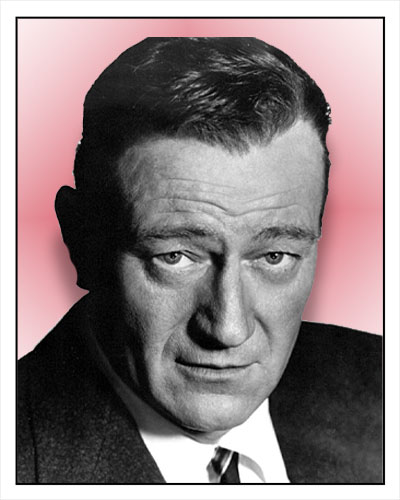 with him, John Wayne was hardly a close-minded type who wrapped himself in the flag and refused to listen to opposing points of view. As long as someone wasn’t trying to shut down the opposition, he was all in favor of letting everyone voice their opinion on the issues confronting us as a country. with him, John Wayne was hardly a close-minded type who wrapped himself in the flag and refused to listen to opposing points of view. As long as someone wasn’t trying to shut down the opposition, he was all in favor of letting everyone voice their opinion on the issues confronting us as a country.
No one needed to tell John Wayne to cowboy up. It was the role he was born to play. Of the many characters he portrayed in a career that spanned 50 years and an astounding 175 films, arguably none are more beloved as those he rode to stardom in some of the most iconic classic Westerns of all-time. Colonels, lawmen, gunslingers, men of shaky reputation — Duke could do it all. And practically did, defining the American cowboy.
CULTURAL ICON
Some people simply transcend culture. But Wayne wasn’t just someone. He was The Duke, commanding the attention of film audiences for five decades in which his star never dimmed. On-screen, while playing sports stars and leading men, he carved out the quintessential models for the American cowboy and American fighting man. Off-screen, Duke was an outdoorsman, a family man, and a patriot.
|
|
| |
|
HANK WILLIAMS |
 |
|
| |
Hank Williams (born September 17, 1923, Georgiana, Alabama, U.S.—died January 1, 1953, Oak Hill, West Virginia) American singer, 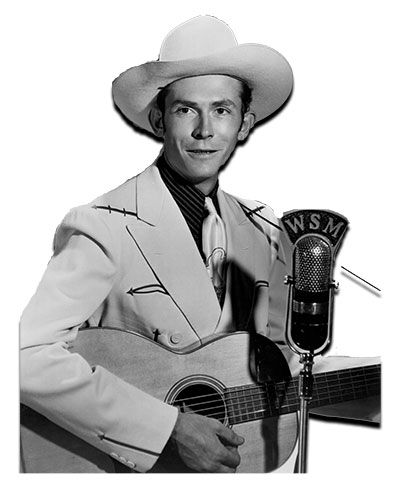 songwriter, and guitarist who in the 1950s arguably became country music’s first superstar. An immensely talented songwriter and an impassioned vocalist, he also experienced great crossover success in the popular music market. His iconic status was amplified by his death at age 29 and by his reputation for hard living and heart-on-the-sleeve vulnerability. songwriter, and guitarist who in the 1950s arguably became country music’s first superstar. An immensely talented songwriter and an impassioned vocalist, he also experienced great crossover success in the popular music market. His iconic status was amplified by his death at age 29 and by his reputation for hard living and heart-on-the-sleeve vulnerability.
In 1946 Williams landed a songwriting contract with Acuff-Rose Publications and began composing material for singer Molly O’Day. Later that year he received his first recording contract, with Sterling Records; however, it was on the start-up label MGM that he had his first hit, “Move It on Over” in 1947. Shortly thereafter he became a regular on the newly created Louisiana Hayride radio program based in Shreveport, Louisiana. His breakthrough moment came in 1949 with the release of “ Lovesick Blues,” an old show tune that Williams parlayed into a chart-topping hit, an invitation to join the Grand Ole Opry in Nashville, and international fame. |
|
| |
|
 |
|
| |
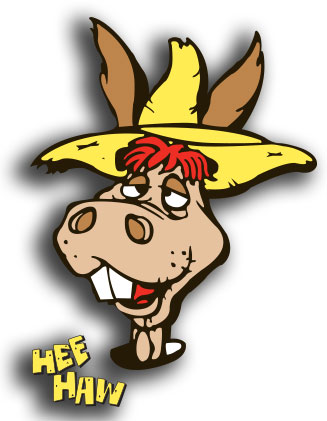 Hee Haw is an American television variety show featuring country music and humor with the fictional rural "Kornfield Kounty" as the backdrop. It aired from 1969 to 1993, and on TNN from 1996 to 1997. Hee Haw is an American television variety show featuring country music and humor with the fictional rural "Kornfield Kounty" as the backdrop. It aired from 1969 to 1993, and on TNN from 1996 to 1997.
Hee Haw's appeal, however, was not limited to a rural audience. It was successful in all of the major markets, including network-based Los Angeles and New York City, as well as Boston and Chicago. Other niche programs such as The Lawrence 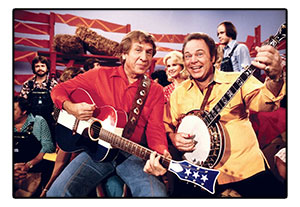 Welk Show and Soul Train, which targeted older and black audiences, respectively, also rose to prominence in syndication during the era. Like Laugh-In, the show minimized production costs by taping all of the recurring sketches for a season in batches, setting up the cornfield set one day, the joke fence on another, etc. At its peak, a season's worth of shows were recorded over the course of two separate, week-long shoots, and then assembled in the editing suite. Only musical performances were taped with a live audience. Welk Show and Soul Train, which targeted older and black audiences, respectively, also rose to prominence in syndication during the era. Like Laugh-In, the show minimized production costs by taping all of the recurring sketches for a season in batches, setting up the cornfield set one day, the joke fence on another, etc. At its peak, a season's worth of shows were recorded over the course of two separate, week-long shoots, and then assembled in the editing suite. Only musical performances were taped with a live audience.
Where, oh where, are you tonight?
Why did you leave me here all alone?
I searched the world over and thought I'd found true love,
You met another and PFFT! You was gone! |
|
| |
|
 |
|
| |
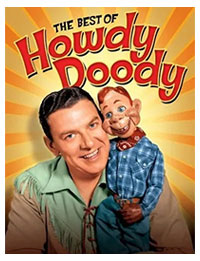 "Say, kids, what time is it?" Resounding from the peanut gallery—and from millions of television-watching kids around the country—came the reply, "It's Howdy Doody time!" "Say, kids, what time is it?" Resounding from the peanut gallery—and from millions of television-watching kids around the country—came the reply, "It's Howdy Doody time!"
Howdy Doody is an American children's television program (with circus and Western frontier themes) that was created and produced by Victor F. Campbell and E. Roger Muir. It was broadcast on the NBC television network in the United States from December 27, 1947, until September 24, 1960.
It was thus one of the first television shows with audience participation as a major component.
Read More >>>
Howdy Doody is an American children's television program (with circus and Western frontier themes) that was created and produced by Victor F. Campbell and E. Roger Muir. It was broadcast on the NBC television network in the United States from December 27, 1947, until September 24, 1960. It was a pioneer of children's programming and set the pattern for many similar shows. One of the first television series produced at NBC in Rockefeller Center, in Studio 3A, it pioneered color production in 1956 and NBC (then owned by RCA Television) used the show to promote color television sets in the late 1950s. “No comments from the peanut gallery!” For many Americans who were born in the 1940s or 1950s, this phrase conjures up fond memories of the “Howdy Doody” show. It launched in 1947 as one of the first children’s television programs.
On that show, Buffalo Bob Smith – the host – his marionette sidekick, Howdy Doody, and Clarabell the clown entertained children who sat in bleachers onstage. Each episode opened with the kids singing the “It’s Howdy Doody Time” theme song and were then filmed reacting to the performers’ antics. Buffalo Bob referred to them as the “peanut gallery,” but the term didn’t originate with his show.
|
|
| |
|
MAC DAVIS |
 |
|
| |
 Mac Davis, Pop and Country Singing Star, Is Dead at 78 Mac Davis, Pop and Country Singing Star, Is Dead at 78
After writing hits for Elvis Presley and others, he became famous in his own right with songs like the No. 1 hit “Baby Don’t Get Hooked on Me.”
The singer and songwriter Mac Davis in 1973. His songwriting revealed a debt to both the sunny humanism of 1967’s Summer of Love and the candid sensuality of the sexual revolution that accompanied it.
Mr. Davis enjoyed early success as a songwriter in the late 1960s, supplying Presley with Top 10 pop hits like “In the Ghetto” and “Don’t Cry Daddy” after spending much of the decade working in sales and publishing for independent record companies.
Read More >>>
Mr. Davis enjoyed early success as a songwriter in the late 1960s, supplying Presley with Top 10 pop hits like “In the Ghetto” and “Don’t Cry Daddy” after spending much of the decade working in sales and publishing for independent record companies. I Believe in Music” was recorded by scores of artists and became Mr. Davis’s signature song; he closed his concerts with it for decades. “Watching Scotty Grow,” another of his best-known compositions.
Singing in a warm, resonant baritone, Mr. Davis recorded many of these originals himself, working in a Southern pop vein akin to that of Presley, whom he often cited, and his fellow Lubbock, Texas, native Buddy Holly, whom he called his greatest musical influence.
“He was like nothing I’d ever seen before,” Mr. Davis said in an interview with the website Elvis Australia about the first time he saw Presley perform onstage, in a parking lot at the county fairgrounds in Lubbock. “Of course, I was just a kid, you know,” Mr. Davis went on. “So was he.” Genial, photogenic and fit, Mr. Davis had his own television variety hour, “The Mac Davis Show,” from 1974 to 1976 on NBC and was a regular guest on “The Tonight Show” and other talk shows in those years. He made his acting debut in the 1979 movie “North Dallas Forty,” a comedy that starred Nick Nolte as an aging football star and Mr. Davis as a calculating quarterback.
Mr. Davis’s songwriting in the late 1960s and early ’70s was a product of that era, revealing a debt to both the sunny humanism of 1967’s Summer of Love and the candid sensuality of the sexual revolution that accompanied it. “In the Ghetto” — inspired by Mr. Davis’s experience with a childhood playmate, the 5-year-old son of one of his father’s Black co-workers — conveyed empathy and depth in speaking to racial inequities.
“I really thought I was going to change the world with that song,” Mr. Davis said of “In the Ghetto” in a 2017. “I was very proud of it. But unfortunately, with the way things are today, the song is probably more poignant now than when I wrote it.”
Morris Mac Davis was born on Jan. 21, 1942, in Lubbock, the second of three children. He and his sister, Linda, spent their childhood living in an efficiency apartment complex with their father, T.J., a building contractor, after their parents divorced; his brother, Kim, grew up in Atlanta with their mother, Edith.
Mr. Davis’s first guitar was a gift from his father when he was 9 years old. But he was less interested in music than in sports and fist-fighting until he finished high school and moved in with his mother in Atlanta, where he started a rock ’n’ roll group called the Zots.
He moved to Liberty Records in the mid-1960s and was soon transferred to Hollywood, where he worked for the label’s publishing division before leaving to join Boots Enterprises, the production and publication company owned by Nancy Sinatra.
While working for Ms. Sinatra, he played on her studio recordings and in her stage shows. He also began publishing his own songs and persuading Presley and other artists to record them.
He left Boots Enterprises in 1970, shortly after meeting the Columbia Records executive Clive Davis and signing a recording contract with the label. He had his first major hit with “Baby Don’t Get Hooked on Me” two years later. Mr. Davis had only four Top 40 pop hit singles with Columbia. But by the mid-1970s he had become more of a force on the country chart, where he had 16 Top 40 singles, including the Top 10 hit “Hooked on Music,” between 1972 and 1985.
His work as an actor also gained momentum as the ’80s progressed, including roles in the Hollywood movies “Cheaper to Keep Her” (1981) and “The Sting II” (1983), as well as appearances on TV shows like “The Muppet Show” and “King of the Hill.”
He was honored as a star on the Hollywood Walk of Fame in 1998. Two years later he was inducted into the Nashville Songwriters Hall of Fame. He was inducted into the Songwriters Hall of Fame in 2006.
Mr. Davis in 2014. By the mid-1970s he had become a force on the country chart, where he had 16 Top 40 singles between 1972 and 1985.
Mr. Davis is survived by his wife of 38 years, Lise (Gerard) Davis; their two sons, Noah Claire and Cody Luke; another son, Joel Scott, from his first marriage; a sister, Linda; his mother; and a granddaughter.
Most accounts of Mr. Davis’s childhood cite his passion for sports and fisticuffs as the reason he ignored the guitar his father gave him as a Christmas present when he was a boy. A 1980 profile in People magazine, though, suggested that it wasn’t the guitar, but his father’s choice of models, that gave Mr. Davis pause.
He “saved up, bless his heart, and bought me a Hawaiian steel guitar, the exact opposite of what I wanted,” Mr. Davis explained. “I tried to act like I loved it,” he went on, “but I almost cried.”
Mac Davis died on Tuesday after undergoing heart surgery. He was 78 years old.
|
|
| |
|
MARTIN LUTHER KING JR. |
 |
| |
|
| |
 Martin Luther King, Jr. (born January 15, 1929, Atlanta, Georgia, U.S.—died April 4, 1968, Memphis, Tennessee) Baptist minister and social activist who led the civil rights movement in the United States from the mid-1950s until his death by assassination in 1968. Martin Luther King, Jr. (born January 15, 1929, Atlanta, Georgia, U.S.—died April 4, 1968, Memphis, Tennessee) Baptist minister and social activist who led the civil rights movement in the United States from the mid-1950s until his death by assassination in 1968.
His leadership was fundamental to that movement’s success in ending the legal segregation of African Americans in the South and other parts of the United States. King rose to national prominence as head of the Southern Christian Leadership Conference, which promoted nonviolent tactics, such as the massive March on Washington (1963), to achieve civil rights. He was awarded the Nobel Peace Prize in 1964.
Read More >>>
As with the lives of other major historical figures, King’s life has been interpreted in new ways by successive generations of scholars, many of whom have drawn attention to the crucial role of local Black leaders in the African American protest movements of the 1950s and ’60s. Recognizing that 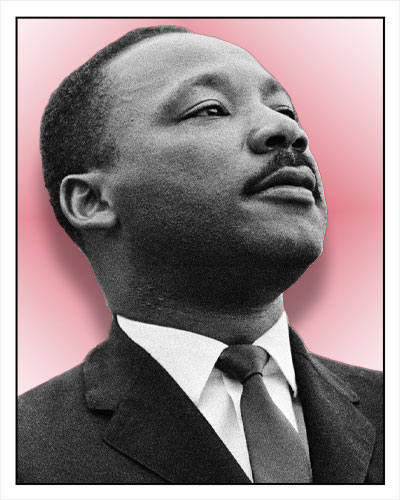 grassroots activists such as Rosa Parks, Fred Shuttlesworth, and others prepared the way for King’s rise to national prominence, biographers and historians have questioned the view that Southern Black protest movements relied on King’s charismatic guidance. Nonetheless, studies of King continue to acknowledge his distinctive leadership role. For example, though he often downplayed his contribution to the Montgomery bus boycott, King’s inspirational leadership and his speeches helped to transform a local protest over bus seating into a historically important event. More generally, studies of King have suggested that his most significant contribution to the modern African American freedom struggle was to link Black aspirations to transcendent, widely shared democratic and Christian ideals. While helping grassroots leaders mobilize African Americans for sustained mass struggles, he inspired participants to believe that their cause was just and consistent with traditional American egalitarian values. King also appealed to the consciences of all Americans, thus building popular support for civil rights reform. His strategy of emphasizing nonviolent protest and interracial cooperation enabled him to fight effectively against the Southern system of legalized racial segregation and discrimination, but it also proved inadequate during his final years as he sought to overcome racial and economic problems that were national in scope. grassroots activists such as Rosa Parks, Fred Shuttlesworth, and others prepared the way for King’s rise to national prominence, biographers and historians have questioned the view that Southern Black protest movements relied on King’s charismatic guidance. Nonetheless, studies of King continue to acknowledge his distinctive leadership role. For example, though he often downplayed his contribution to the Montgomery bus boycott, King’s inspirational leadership and his speeches helped to transform a local protest over bus seating into a historically important event. More generally, studies of King have suggested that his most significant contribution to the modern African American freedom struggle was to link Black aspirations to transcendent, widely shared democratic and Christian ideals. While helping grassroots leaders mobilize African Americans for sustained mass struggles, he inspired participants to believe that their cause was just and consistent with traditional American egalitarian values. King also appealed to the consciences of all Americans, thus building popular support for civil rights reform. His strategy of emphasizing nonviolent protest and interracial cooperation enabled him to fight effectively against the Southern system of legalized racial segregation and discrimination, but it also proved inadequate during his final years as he sought to overcome racial and economic problems that were national in scope.
|
 |
| |
|
 |
|
MARY TYLER MOORE |
 |
|
| |
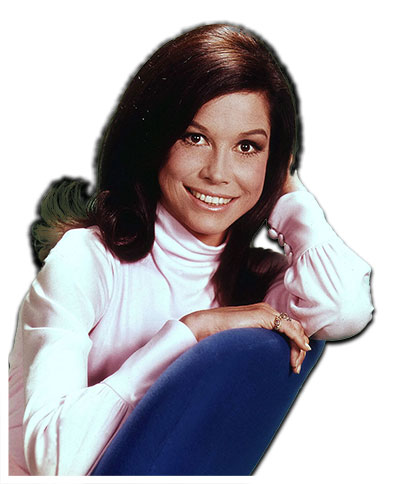 Mary Tyler Moore (December 29, 1936 – January 25, 2017) was an American actress, producer, and social advocate. She is best known for her roles on The Dick Van Dyke Show (1961–1966) and The Mary Tyler Moore Show (1970–1977), which "helped define a new vision of American womanhood" and "appealed to an audience facing the new trials of modern-day existence". Moore won seven Primetime Emmy Awards and three Golden Globe Awards. She was nominated for the Academy Award for Best Actress for her performance in Ordinary People. Mary Tyler Moore (December 29, 1936 – January 25, 2017) was an American actress, producer, and social advocate. She is best known for her roles on The Dick Van Dyke Show (1961–1966) and The Mary Tyler Moore Show (1970–1977), which "helped define a new vision of American womanhood" and "appealed to an audience facing the new trials of modern-day existence". Moore won seven Primetime Emmy Awards and three Golden Globe Awards. She was nominated for the Academy Award for Best Actress for her performance in Ordinary People.
Moore was diagnosed with type 1 diabetes in 1969. In 2011, she had surgery to remove a meningioma, a benign brain tumor. In 2014, friends reported that Moore had heart and kidney problems and was nearly blind from complications related to diabetes.
Moore died at the age of 80 on January 25, 2017, at Greenwich Hospital in Greenwich, Connecticut, from cardiopulmonary arrest complicated by pneumonia after having been placed on a ventilator the week before. |
 |
| |
|
 |
|
MERLE RONALD HAGGARD |
 |
|
| |
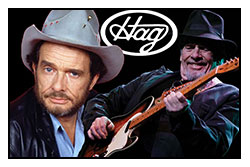 Merle Ronald Haggard (April 6, 1937 – April 6, 2016) was an American country music singer, songwriter, guitarist, and fiddler. Merle Ronald Haggard (April 6, 1937 – April 6, 2016) was an American country music singer, songwriter, guitarist, and fiddler.
Few artists have matched the impact that Merle Haggard has had on country music as both a singer and writer. Hank Williams, perhaps. Maybe Jimmie Rodgers or Bill Monroe.
In a genre where performers and writers often are separated into distinct camps, Haggard has written the lion's share of his hits, and nearly all of the greatest ones--among them classics like "Swinging Doors," "The Bottle Let Me Down," "Mama Tried" and "Hungry Eyes."
Born April 6, 1937 in Bakersfield, California, Haggard had a childhood filled with the same kind of hardships that his songs would later contain. He lived part of childhood in a converted boxcar. He spent three years in San Quentin for burglary (California governor Ronald Reagan pardoned him in 1972).
Read More >>>
After being released from San Quentin State Prison in 1960, he managed to turn his life around and launched a successful country music career. He gained popularity with his songs about the working class; these occasionally contained themes contrary to the anti–Vietnam War sentiment of some popular music of the time. Between the 1960s and the 1980s he had 38 number-one hits on the US country charts, several of which also made the Billboard all-genre singles chart. Haggard continued to release successful albums into the 2000s.
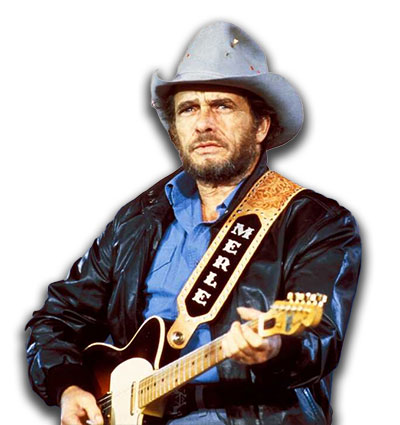 He received many honors and awards for his music, including a Kennedy Center Honor (2010); a Grammy Lifetime Achievement Award (2006); a BMI Icon Award (2006); and induction into the Nashville Songwriters Hall of Fame (1977); Country Music Hall of Fame (1994) and Oklahoma Music Hall of Fame (1997). He died on April 6, 2016—his 79th birthday—at his ranch in Shasta County, California, having recently suffered from double pneumonia. He received many honors and awards for his music, including a Kennedy Center Honor (2010); a Grammy Lifetime Achievement Award (2006); a BMI Icon Award (2006); and induction into the Nashville Songwriters Hall of Fame (1977); Country Music Hall of Fame (1994) and Oklahoma Music Hall of Fame (1997). He died on April 6, 2016—his 79th birthday—at his ranch in Shasta County, California, having recently suffered from double pneumonia.
Few country artists have been as popular and widely admired as Mr. Haggard, a ruggedly handsome performer who strode onto a stage, guitar in hand, as a poet of the common man. Thirty-eight of his singles, including “Workin’ Man Blues” and the 1973 recession-era lament “If We Make It Through December,” reached No. 1 on the Billboard country chart from 1966 to 1987. He released 71 Top 10 country hits in all, 34 in a row from 1967 to 1977. Seven of his singles crossed over to the pop charts.
He was always the outsider. His band was aptly named the Strangers.
Unlike his friend Johnny Cash, Mr. Haggard didn’t merely visit San Quentin State Prison in California to perform for the inmates. Convicted of burglary in 1957, he served nearly three years there and spent his 21st birthday in solitary confinement.
Mr. Haggard went on to write “Mama Tried,” “Branded Man” and several other candid songs about his incarceration, all of them sung in a supple baritone suffused with dignity and regret. Many of his other recordings championed the struggles of the working class from which he rose.
Defying the conventions of the Nashville musical establishment, Mr. Haggard was an architect of the twangy Bakersfield sound, a guitar-driven blend of blues, jazz, pop and honky-tonk that traced its roots to Bakersfield, Calif. In Mr. Haggard’s case the sound defined a body of work as indelibly as that of any country singer since Hank Williams.
Mr. Haggard cited Lefty Frizzell, Elvis Presley, Jimmie Rodgers, Chuck Berry and Bob Wills as among the artists who influenced his sound. “I thought, if I combine all that, maybe I can come up with something sustaining,” he told the magazine LA Weekly in 1999.
|
|
| |
|
 |
|
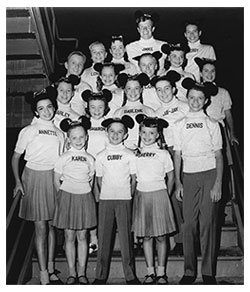 The Mickey Mouse Club The Mickey Mouse Club
"M-I-C-K-E-Y-M-O-U-S-E." Before the theme song's memorable spelling became an audio icon, before the series even aired, the Mickey Mouse Club was the most anticipated children's programming ever. The Mickey Mouse Club is a classic variety show from the 1950s. The children's program features the famous Mouseketeers, led by Jimmie and Roy, who entertain with song and dance numbers. The show also highlights educational newsreels about children around the world, as well as animated cartoons, often with Mickey Mouse himself. This program is presented as originally created. It may contain outdated cultural depictions.
The main cast members were called Mouseketeers, and they performed in a variety of musical and dance numbers, as well as some informational segments. The most popular of the Mouseketeers constituted the so-called Red Team, which was kept under contract for the entire run of the show (1955–1959). Its members included:
Read More >>>
 James Wesley Dodd was an American actor, singer and songwriter best known as the master of ceremonies for the popular 1950s Walt Disney television series The Mickey Mouse Club, as well as the writer of its well-known theme song "The Mickey Mouse Club March." James Wesley Dodd was an American actor, singer and songwriter best known as the master of ceremonies for the popular 1950s Walt Disney television series The Mickey Mouse Club, as well as the writer of its well-known theme song "The Mickey Mouse Club March."
Always quick with a smile and a song, Jimmie Dodd was the unforgettable host of the Mickey Mouse Club. With his trusty “Mousegetar” in hand, the singer, songwriter, musician, dancer, and actor was a friend to children across the nation. He often transferred his infectious spirit through Doddisms, delightful instruction on the principles of good living, which he shared on each show to “help us all be better Mouseketeers.”
Joseph Roy Williams was born July 30, 1907 in Colville, Washington.
 Roy Williams was a Disney animator and story idea guy who specialized in gags and pranks. He was also a skilled sketch artist, and often made live appearances at Disney events and at Disneyland to draw for guests. Though not an actor, Walt Disney himself decided Roy should be an “adult Mouseketeer” on The Mickey Mouse Club, where he would be called the Big Mooseketeer. Roy Williams was a Disney animator and story idea guy who specialized in gags and pranks. He was also a skilled sketch artist, and often made live appearances at Disney events and at Disneyland to draw for guests. Though not an actor, Walt Disney himself decided Roy should be an “adult Mouseketeer” on The Mickey Mouse Club, where he would be called the Big Mooseketeer.
Made a Disney Legend posthumously in 1992, Roy made many amazing contributions to the legacy of Disney, from his story work on the animated shorts to designing over 100 Disney military insignias during World War II (including one for the Flying Tigers) and from coming up with the concept of the Mouse Ears caps for Disneyland to his appearances on the Mickey Mouse Club television show that helped inspire young artists.
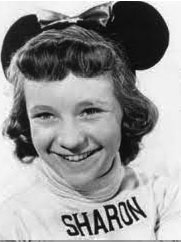
Sharon Baird is an American actress, voice actress, singer, dancer and puppeteer who is best known for having been a Mouseketeer.
Baird appeared in her first film, Bloodhounds of Broadway, in 1950. At age nine she began regular appearances on The Colgate Comedy Hour television show with Eddie Cantor. She did episodes of several different television shows, and an unbilled song-and-dance number with Dean Martin in Artists and Models (1955) (which also featured fellow mouseketeer Nancy Abbate), just before being selected for the Mickey Mouse Club.
Baird as a Mouseketeer circa 1956 Contrary to the impression given by Disney publicity, many of the Mickey Mouse Club cast had some prior experience in films and television. Baird was among the most experienced of these professionals, and performed with the show's "Red Team", or first-string unit, for all three seasons of original programming (1955–1958). Her specialty was tap, but she did other forms of dancing, as well as singing and acting on the show.
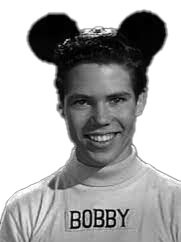
Robert Wilkie Burgess (born May 19, 1941) is an American dancer and singer. He was one of the original Mouseketeers. Later, he was a regular on The Lawrence Welk Show.
Growing up in Southern California, Burgess started performing at age five, which included dancing, singing and playing the accordion. At the age of 13, in 1955, he was selected as one of the original Mouseketeers by Walt Disney to appear on his new ABC television series, The Mickey Mouse Club, giving young Burgess his first taste of celebrity. He also guest starred on The Donna Reed Show as a suitor of Mary Stone (Shelley Fabares). Burgess attended Southern California Military Academy in Long Beach for his elementary and junior high school. By the time Burgess turned 11, he had appeared in at least 75 television programs.
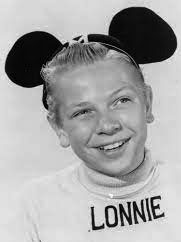
Lonnie Burr (born May 31, 1943) is an American actor, entertainer and writer best known as one of nine of the original thirty-nine Mouseketeers who remained under a seven-year contract for the complete filming (1955–1959) of Walt Disney’s children’s television show the Mickey Mouse Club. The Mickey Mouse Club was the first national TV show to star children who appeared primarily as themselves as well as acting as characters in scenes and musical numbers. The original show aired in syndication in the 1960s, reran again in 1975, then on the Disney Channel in the 1980s through the early 2000s.
After appearing on the show, Burr's entertainment career included work as a character actor, dancer, singer, and choreographer. His career as a writer included being a book author, playwright, lyricist, journalist, critic and poet. Throughout adulthood, he continued to honor his Disney experience. As he was quoted in an interview, "Whether I someday scale the Matterhorn or win my Pulitzer, I shall always be known as Mouseketeer Lonnie; that is the way the obituary will begin. I have come to learn that is a marvelous association."
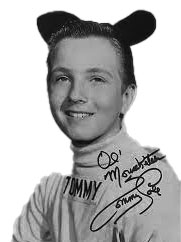
Tommy Cole (born December 20, 1941) is an American make-up artist, actor, and singer who appeared as a Mouseketeer on the Mickey Mouse Club television series.
Cole's singing ability earned him a transfer to The Mickey Mouse Club's first-string Red Team midway through the 1955–56 season. He remained with the show for its final two seasons (1956–1958) of original programming and, after filming stopped, attended Hollywood Professional School and went on live-performance tours with other Mouseketeers to Australia in 1959 and 1960. For the next several years Tommy Cole's career was based on live-singing at teenage clubs, public events, and as an opening act for other performers. He attended Pasadena City College, did a hitch in the Air Force, and had guest star parts on a few television shows. By 1964, he had realized that his days as a performer were ending, and so looked around for some other way to stay in show business.
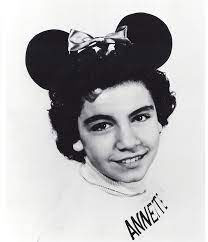
Annette Joanne Funicello (October 22, 1942 – April 8, 2013) was an American actress and singer. Funicello began her professional career as a child performer at the age of twelve. She was one of the most popular Mouseketeers on the original Mickey Mouse Club. In her teenage years, she recorded under the name Annette, and had a successful career as a pop singer. Her most notable singles are "O Dio Mio", "First Name Initial", "Tall Paul", and "Pineapple Princess". During the mid-1960s, she established herself as a film actress, popularizing the successful "Beach Party" genre alongside co-star Frankie Avalon.
Funicello took dancing and music lessons when she was a child in order to overcome her shyness. In 1955, the 12-year-old was discovered by Walt Disney when she performed as the Swan Queen in Swan Lake at a dance recital at the Starlight Bowl in Burbank, California. Disney cast her as one of the original Mouseketeers. She was the last to be selected, and one of the few cast members to be personally selected by Walt Disney himself.
In 1955, she signed a seven-year contract with Disney at $160 a week to rise to $500 a week if all options were exercised.
Funicello proved to be very popular, and by the end of the first season of The Mickey Mouse Club, she was receiving 6,000 letters a month, according to her Disney Legends biography – more than any other Mouseketeer.
She had a crush on, dated, had a first kiss with, and went steady with fellow Mouseketeer Lonnie Burr. In 1958, at the finale of the show, she had to say goodbye to each of the members of its cast, and, in her own words, "I never cried so hard in my life".
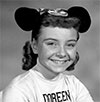
Darlene Faye Gillespie (born April 8, 1941) is a Canadian-American former child actress, most remembered as a singer and dancer on the original The Mickey Mouse Club television series from 1955 to 1959. After her career in entertainment ended, she became a nurse.
Gillespie auditioned for The Mickey Mouse Club in March 1955, was hired, and appeared on the program for all three seasons of its original run. She was the leading female singer and starred in the serial Corky and White Shadow (1956) during the first season.
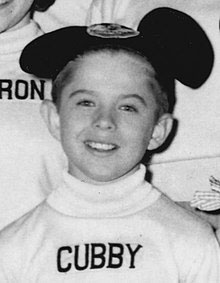
Carl "Cubby" Patrick O'Brien (born July 14, 1946), better known by his nickname Cubby, is an American drummer and former child actor. He is known as one of the original Mouseketeers on the weekday ABC television program The Mickey Mouse Club from 1955 to 1958.
O'Brien, like Annette Funicello, was personally selected to audition for The Mickey Mouse Club by Walt Disney, in the spring of 1955. Disney was alerted to him by a staff member who caught his live performance at a charity gala.
Though he had little prior singing or dancing experience, O'Brien was placed on The Mickey Mouse Club's first-string "Red Team" right from the start. He quickly picked up enough dance skills to perform in musical numbers, though his solo performances remained centered around his drums. He remained with the show for all three seasons (1955–1958) of original programming. When filming ended, he went on live-performance tours with other Mouseketeers to Australia in 1959 and 1960.
 Karen Anita Pendleton (August 1, 1946 – October 6, 2019) was an original Mickey Mouse Club Mouseketeer on the ABC television series from 1955 to 1959. She was one of only nine Mouseketeers who were on the show during its entire original run. Karen Anita Pendleton (August 1, 1946 – October 6, 2019) was an original Mickey Mouse Club Mouseketeer on the ABC television series from 1955 to 1959. She was one of only nine Mouseketeers who were on the show during its entire original run.
Pendleton was recruited to audition for the Mickey Mouse Club when Disney producers visited a Los Angeles dance studio seeking young talent. She toured Australia in 1959 and 1960 with a number of other Mouseketeers and Jimmie Dodd. She was often coupled with Carl "Cubby" O'Brien in the television series and in live performances, as they were the youngest members of the cast.
 Doreen Isabelle Tracey (April 13, 1943 – January 10, 2018) was a British-born American performer who appeared on the original Mickey Mouse Club television show from 1955 to 1959.< Doreen Isabelle Tracey (April 13, 1943 – January 10, 2018) was a British-born American performer who appeared on the original Mickey Mouse Club television show from 1955 to 1959.<
|
|
| |
|
MINSTREL SHOWS |
 |
|
| |
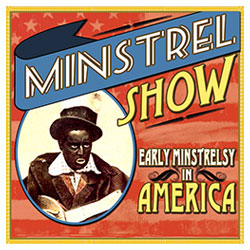 Minstrel show, an American theatrical form, popular from the early 19th to the early 20th century, that was founded on the comic enactment of racial stereotypes. The tradition reached its zenith between 1850 and 1870. Although the form gradually disappeared from the professional theatres and became purely a vehicle for amateurs, its influence endured—in vaudeville, radio, and television as well as in the motion-picture and world-music industries of the 20th and 21st centuries. Minstrel show, an American theatrical form, popular from the early 19th to the early 20th century, that was founded on the comic enactment of racial stereotypes. The tradition reached its zenith between 1850 and 1870. Although the form gradually disappeared from the professional theatres and became purely a vehicle for amateurs, its influence endured—in vaudeville, radio, and television as well as in the motion-picture and world-music industries of the 20th and 21st centuries.
The earliest minstrel shows were staged by white male minstrels (traveling musicians) who, with their faces painted black, caricatured the singing and dancing of slaves.
Read More >>>
Minstrel troupes composed of Black performers were formed after the American Civil War, and a number of these, including the Hicks and Sawyer Minstrels, had Black owners and managers. Some, such as Callendar’s Consolidated Spectacular Colored Minstrels, were popular in both the United 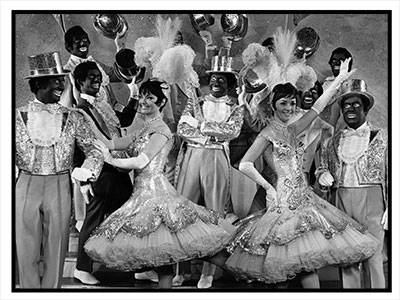 States and Britain in the late 19th and early 20th centuries. Initially these shows were staged by all-male companies that included male alto and soprano singers. The larger Black minstrel shows included bands of multitalented instrumentalists to play marches for the troupe’s parades in the daytime and perform string accompaniments for the evening shows. In addition to some music by Stephen Foster, their repertoire featured music by Black composers such as James Bland, a popular singer-banjoist who wrote some 700 songs, including “Carry Me Back to Old Virginny.” In general, these minstrel shows were the only theatrical medium in which gifted Black performers of the period could support themselves. States and Britain in the late 19th and early 20th centuries. Initially these shows were staged by all-male companies that included male alto and soprano singers. The larger Black minstrel shows included bands of multitalented instrumentalists to play marches for the troupe’s parades in the daytime and perform string accompaniments for the evening shows. In addition to some music by Stephen Foster, their repertoire featured music by Black composers such as James Bland, a popular singer-banjoist who wrote some 700 songs, including “Carry Me Back to Old Virginny.” In general, these minstrel shows were the only theatrical medium in which gifted Black performers of the period could support themselves.
A few of the larger companies employed both Black and white performers. By the 20th century, women were also appearing in minstrel shows; the great blues singers Ma Rainey and Bessie Smith were both minstrel performers early in their careers. Minstrel shows had effectively disappeared by the mid-20th century. However, vestiges of their racial stereotyping and performance aesthetics persisted for decades in various performance mediums, including television situation comedies such as Sanford and Son, Good Times, and The Jeffersons, which aired in the United States in the 1970s and ’80s.
|
|
| |
|
 |
|
| |
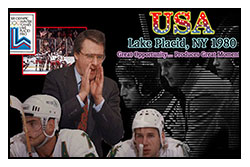 22 February 1980, Lake Placid, New York, USA 22 February 1980, Lake Placid, New York, USA
Great moments are born from great opportunity.
And that's what you have here tonight, boys.
That's what you've earned here, tonight. One game.
If we played 'em ten times, they might win nine. But not this game. Not tonight.
Tonight, we skate with 'em.
Tonight, we stay with 'em, and we shut them down because we can!
Tonight, we are the greatest hockey team in the world.
You were born to be hockey players -- every one of ya.
And you were meant to be here tonight.
This is your time.
Their time -- is done. It's over.
I'm sick and tired of hearin' about what a great hockey team the Soviets have. Screw 'em!
This is your time!!
Now go out there and take it!
Read More >>>
In 1962 The "Miracle on Ice" was an ice hockey game during the 1980 Winter Olympics in Lake Placid, New York. It was played between the hosting United States and the Soviet Union on February 22, 1980, during the medal round of the men's hockey tournament. Though the Soviet Union was a four-time defending gold medalist and heavily favored, the United States upset them and won 4–3.
The Soviet Union had won the gold medal in five of the six previous Winter Olympic Games, and they were the favorites to win once more in Lake Placid. The team consisted primarily of full-time players (professional in all but name) with significant experience in international play. By contrast, the United States' team, led by head coach Herb Brooks, was composed mostly of amateur players, with only four players with minimal minor-league experience. The United States had the youngest team in the tournament and in U.S. national team history.
In the group stage, both the Soviet and U.S. teams were unbeaten; the U.S. achieved several surprising results, including a 2–2 draw against Sweden, and a 7–3 upset victory over second-place favorite Czechoslovakia.
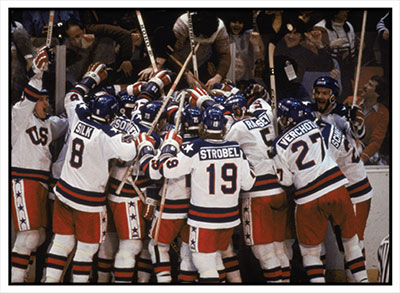 For the first game in the medal round, the United States played the Soviets. Finishing the first period tied at 2–2, and the Soviets leading 3–2 following the second, the U.S. team scored two more goals to take their first lead midway in the third and final period, then held on and won 4–3. Two days later, the U.S. won the gold medal by beating Finland in their final game. The Soviet Union took the silver medal by beating Sweden. For the first game in the medal round, the United States played the Soviets. Finishing the first period tied at 2–2, and the Soviets leading 3–2 following the second, the U.S. team scored two more goals to take their first lead midway in the third and final period, then held on and won 4–3. Two days later, the U.S. won the gold medal by beating Finland in their final game. The Soviet Union took the silver medal by beating Sweden.
The victory became one of the most iconic moments of the Games and in U.S. sports. Equally well-known was the television call of the final seconds of the game by Al Michaels for ABC, in which he declared: "Do you believe in miracles? YES!" In 1999, Sports Illustrated named the "Miracle on Ice" the top sports moment of the 20th century. As part of its centennial celebration in 2008, the International Ice Hockey Federation (IIHF) named the "Miracle on Ice" as the best international ice hockey story of the past 100 years
|
|
| |
|
NEIL ARMSTRONG |
 |
|
| |
Neil Armstrong (born August 5, 1930, Wapakoneta, Ohio, U.S.—died August 25, 2012, Cincinnati, Ohio) was a U.S. astronaut, and the first person to set foot on the Moon.
 Neil Armstrong was the eldest of three children born to Viola Louise Engel and Stephen Koenig Armstrong, a state auditor. Neil Armstrong was the eldest of three children born to Viola Louise Engel and Stephen Koenig Armstrong, a state auditor.
Neil’s passion for aviation and flight was kindled when he took his first airplane ride at age 6. He was active in the Boy Scouts of America and earned the rank of Eagle Scout, the highest rank attainable. He became a licensed pilot on his 16th birthday and a naval air cadet in 1947. His studies in aeronautical engineering at Purdue University in West Lafayette, Indiana, were interrupted in 1950 by his service in the Korean War, during which he was shot down once and was awarded three Air Medals. He completed his degree in 1955 and immediately became a civilian research pilot for the National Advisory Committee for Aeronautics (NACA), later the National Aeronautics and Space Administration (NASA). He flew more than 1,100 hours, testing various supersonic fighters as well as the X-15 rocket plane.
Read More >>>
In 1962 Armstrong joined the space program with its second group of astronauts. On March 16, 1966, Armstrong, as command pilot of Gemini 8, and David R. Scott rendezvoused with an unmanned Agena rocket and completed the first manual space docking maneuver. After the docking, a rocket thruster malfunction sent the spacecraft into an uncontrolled spin and forced them to separate from the Agena. Armstrong then regained control of the Gemini craft and made an emergency splashdown in the Pacific Ocean.
Moon landing
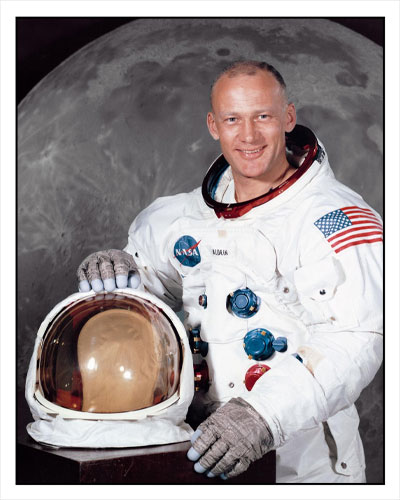 Perhaps the most famous of all space films, these clips document the arrival of the first human beings on the Moon during the afternoon of July 20, 1969. They comprise footage of the landing of the Apollo 11 spacecraft, taken with a 16-mm camera mounted in Edwin Aldrin's window, and Neil Armstrong's first steps on the Moon, recorded by a television camera whose signal was transmitted back to NASA Mission Control in Houston. In the audio can be heard one of the most famous misstatements in history: Armstrong had planned to say “That's one small step for a man, one giant leap for mankind,” but he forgot the “a” in the excitement of the moment. Perhaps the most famous of all space films, these clips document the arrival of the first human beings on the Moon during the afternoon of July 20, 1969. They comprise footage of the landing of the Apollo 11 spacecraft, taken with a 16-mm camera mounted in Edwin Aldrin's window, and Neil Armstrong's first steps on the Moon, recorded by a television camera whose signal was transmitted back to NASA Mission Control in Houston. In the audio can be heard one of the most famous misstatements in history: Armstrong had planned to say “That's one small step for a man, one giant leap for mankind,” but he forgot the “a” in the excitement of the moment.
On July 16, 1969, Armstrong, along with Edwin E. Aldrin, Jr., and Michael Collins, blasted off in the Apollo 11 vehicle toward the Moon (see Apollo program). Four days later, at 4:17 PM U.S. Eastern Daylight Time (EDT), the Eagle lunar landing module, guided manually by Armstrong, touched down on a plain near the southwestern edge of the Sea of Tranquillity ( Mare Tranquillitatis). At 10:56 PM EDT on July 20, 1969, Armstrong stepped from the Eagle onto the Moon’s dusty surface with the words, “That’s one small step for [a] man, one giant leap for mankind.” (In the excitement of the moment, Armstrong skipped the “a” in the statement that he had prepared.) Armstrong and Aldrin left the module for more than two hours and deployed scientific instruments, collected surface samples, and took numerous photographs.
On July 21, after 21 hours and 36 minutes on the Moon, they lifted off to rendezvous with Collins and begin the voyage back to Earth. After splashdown in the Pacific at 12:51 PM EDT on July 24, the three astronauts spent 18 days in quarantine to guard against possible contamination by lunar microbes. During the days that followed, and during a tour of 21 nations, they were hailed for their part in the opening of a new era in human exploration of the universe.
Later career
Armstrong resigned from NASA in 1971. After Apollo 11 he shied away from being a public figure and confined himself to academic and professional endeavours. From 1971 to 1979 he was professor of aerospace engineering at the University of Cincinnati (Ohio). After 1979 Armstrong served as chairman or director for a number of companies, among them Computing Technologies for Aviation from 1982 to 1992 and AIL Systems (later EDO Corporation), a maker of electronic equipment for the military, from 1977 until his retirement in 2002. He also served on the National Commission on Space (NCOS), a panel charged with setting goals for the space program, and on the Presidential Commission on the Space Shuttle Challenger Accident, the group appointed in 1986 to analyze the safety failures in the Challenger disaster. He was awarded the Presidential Medal of Freedom in 1969, the Congressional Space Medal of Honor in 1978, and the Congressional Gold Medal in 2009.
|
|
| |
|
RICKY NELSON |
 |
|
| |
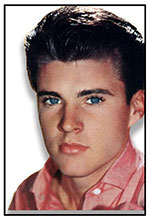 Rick Nelson (born May 8, 1940, -- December 31, 1985, De Kalb, Texas) American singer and actor, one of rock music’s first teen idols. Nelson gained fame on his parents’ television series, The Adventures of Ozzie and Harriet, which embodied middle-American values in the 1950s and early ’60s. Rick Nelson (born May 8, 1940, -- December 31, 1985, De Kalb, Texas) American singer and actor, one of rock music’s first teen idols. Nelson gained fame on his parents’ television series, The Adventures of Ozzie and Harriet, which embodied middle-American values in the 1950s and early ’60s.
At age 17, in 1957, he recorded a hit version of Fats Domino’s “I’m Walkin’.” Trading on his handsome wholesome television image, Nelson launched a recording career that resulted in a bevy of Top Ten hits and contributed to rock and roll’s mainstream acceptance. Yet, unlike Frankie Avalon and other teen idols who found fame on American Bandstand, Nelson created boisterous rockabilly-flavoured rock and roll as well as gentler ballads. |
|
| |
|
ROY ROGERS |
 |
 |
|
| |
 "The Roy Rogers Show," starring Roy Rogers, King of the Cowboys; Trigger, his golden palomino; and Dale Evans, Queen of the West; with Pat Brady, his comical sidekick; and Roy's wonder dog, Bullet. "The Roy Rogers Show," starring Roy Rogers, King of the Cowboys; Trigger, his golden palomino; and Dale Evans, Queen of the West; with Pat Brady, his comical sidekick; and Roy's wonder dog, Bullet.
Roy Rogers earned the title “King of the Cowboys” for his enormous popularity in films, on television and radio, and in personal appearances. But even before starring in his first film, Rogers earned an eventual place in the Country Music Hall of Fame by founding the Sons of the Pioneers.
Read More >>>
Rider's Rules By Roy Rogers
1. Be neat and clean.
2. Be courteous and polite.
3. Always obey your parents.
4. Protect the weak and help them.
5. Be brave but never take chances.
6. Study hard and learn all you can.
7. Be kind to animals and take care of them.
8. Eat all your food and never waste any.
9. Love God and go to Sunday school regularly.
10. Always respect our flag and our country.
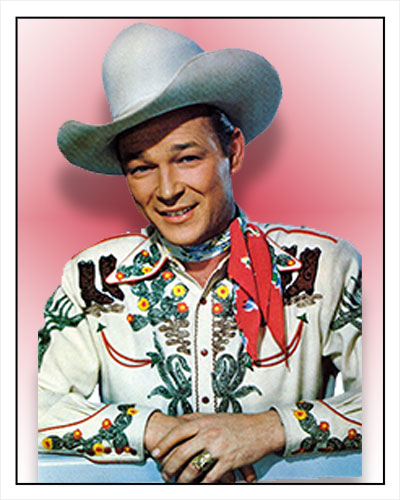 When Gene Autry walked out on his contract, Rogers was given the starring role in Under Western Stars, which had been scheduled to be Autry’s next film. The tremendous success of Rogers’s first film, which was released in 1938, marked the emergence of a new star. By 1943, Rogers was the top western star at the box office. He retained this rank until he made the transition into television in the early 1950s. He also maintained a busy schedule of personal appearances, most of them featuring his beloved horse, Trigger, who received near-equal billing. When Gene Autry walked out on his contract, Rogers was given the starring role in Under Western Stars, which had been scheduled to be Autry’s next film. The tremendous success of Rogers’s first film, which was released in 1938, marked the emergence of a new star. By 1943, Rogers was the top western star at the box office. He retained this rank until he made the transition into television in the early 1950s. He also maintained a busy schedule of personal appearances, most of them featuring his beloved horse, Trigger, who received near-equal billing.
In 1944, Dale Evans was cast as Rogers’s leading lady in The Cowboy and the Señorita. The chemistry between them was apparent to both audiences and the studio. Over the next five years, Evans was featured in Rogers’s next nineteen films. A little more than a year after the death of his first wife, Rogers and Evans married, on New Year’s Eve, 1947. A few years later, the couple launched their NBC network television series, which quickly became a favorite with Sunday night family viewers.
Personal Tragedies and Later Life
 Rogers’s success in films, radio, television, on records, and in personal appearances was dampened by a series of tragedies. His second wife, Arlene, the mother of his first three children, died a week after the birth of their third child, Roy Jr., in 1946. Robin, the only child born to Rodgers and Evans, suffered from Down syndrome and died in 1952, shortly before her second birthday. Rogers’s success in films, radio, television, on records, and in personal appearances was dampened by a series of tragedies. His second wife, Arlene, the mother of his first three children, died a week after the birth of their third child, Roy Jr., in 1946. Robin, the only child born to Rodgers and Evans, suffered from Down syndrome and died in 1952, shortly before her second birthday.
Rodgers and Evans eventually adopted four children from different ethnic and social backgrounds, only to lose two of them tragically. Debbie, an orphan they adopted from Korea, died in a church bus accident. Their son Sandy, who had suffered brain damage due to physical abuse before his adoption, died while serving in the Army. Each of these losses took a tremendous toll on Rogers, but he and Evans’s religious faith sustained them. Their positive outlook as they confronted life’s challenges only added to the public’s regard for them.
Rogers was a hero to audiences who saw him in films, at rodeos or state fairs, in television appearances, or at visits to his museum in Victorville, California. To fans throughout the world, the King of the Cowboys was one of the most beloved Americans. Rogers died on July 6, 1998, sixty years after making his first motion picture.
Roy Rogers is the only person to be elected twice to the Country Music Hall of Fame: first in 1980 as a member of the original Sons of the Pioneers, and then in 1988 as an individual, for his own career achievements.
|
 |
|
| |
|
GEORGE REEVES |
 |
 |
|
 |
| |
George Reeves (January 5, 1914 – June 16, 1959) was an American actor.
Reeves was born with the name of George Keefer Brewer in Woolstock, Iowa, U.S., son of Don Brewer and Helen Lescher. Reeves started acting in high school and then continued to serve on student productions. In 1943, 17 months after the attack on Pearl Harbor, Reeves enrolled in aviation until the  end of World War II, putting his acting career on hold. end of World War II, putting his acting career on hold.
After a successful career, Reeves died on June 16, 1959. However, the manner of death is controversial. He was officially found to have committed suicide, but some people think he was murdered or a shooting victim.
Read More >>>
He began his career playing small roles in short movies and movies as Ride, Cowboy, Ride (1939 short). In the classic movie starring Clark Gable, Gone with the Wind (1939), Reeves played of role Stuart Tarleton. In the 1940  Reeves continued to make appearances in movies such as Blood and Sand (1941) with Tyrone Power, So Proudly We Hail! (1943), Winged Victory (1944), Samson and Delilah (1949), and the Western starring by William Boyd Border Patrol (1943), Colt Comrades (1943), Bar 20 (1943). George Reeves got his first starring role in 1948 movie Jungle Goddess (1948), as Mike Patton, an explorer rescuing a young woman who has been kidnapped by an African tribe. He also accompanied Johnny Weissmuller in the Tarzan saga Jungle Jim (1948). Reeves continued to make appearances in movies such as Blood and Sand (1941) with Tyrone Power, So Proudly We Hail! (1943), Winged Victory (1944), Samson and Delilah (1949), and the Western starring by William Boyd Border Patrol (1943), Colt Comrades (1943), Bar 20 (1943). George Reeves got his first starring role in 1948 movie Jungle Goddess (1948), as Mike Patton, an explorer rescuing a young woman who has been kidnapped by an African tribe. He also accompanied Johnny Weissmuller in the Tarzan saga Jungle Jim (1948).
In the 1950s Reeves starred in several movies including Rancho Notorious (1952) with Marlene Dietrich - Arthur Kennedy and directed by Fritz Lang, Bugles in the Afternoon (1952) with Ray Milland, The Blue Gardenia (1953) by Fritz Lang, and without being listed in the credits had a role in Fred Zinnemann movie, From Here to Eternity (1953) with Burt Lancaster, Reeves as Sgt. Maylon Stark.
He started work in television in 1948, and in 1952 he was hired to play the double character of Superman and Clark Kent in Adventures of Superman. The series was a success without precedent in American television and made Reeves famous. George Reeves played Superman for 102 episodes broadcast between 1952 and 1958.
|
 |
|
| |
|
MOE HOWARD & SHEMP HOWARD
& LARRY FINE & CURLY HOWARD |
 |
|
| |
The Most Famous The Three Stooges |
Moe Howard
(Moses Horwitz)
Born: 6/19/1897
Died: 5/4/1975 |
Shemp Howard
(Samuel Horwitz)
Born: 3/17/1895
Died: 11/23/1955 |
Larry Fine
(Laurence Feinburg)
Born: 10/5/1902
Died: 1/24/1975 |
Curly Howard
(Jerome Horwitz)
Born: 10/22/1903
Died: 1/18/1952 |
|
The Three Stooges
 Best known as a threesome, the Stooges started as a twosome, with Moe Howard and his brother Samuel (“Shemp.”) The pair performed their shtick in vaudeville for five years before Larry Fine made the two Stooges three. As the magic of vaudeville began to wane, the Stooges took their head-knocking act to the big screen, making 200 short films between 1934 and 1958. Best known as a threesome, the Stooges started as a twosome, with Moe Howard and his brother Samuel (“Shemp.”) The pair performed their shtick in vaudeville for five years before Larry Fine made the two Stooges three. As the magic of vaudeville began to wane, the Stooges took their head-knocking act to the big screen, making 200 short films between 1934 and 1958.
Shemp Howard left the group in the early 1930s and Jerome “Curly” Howard signed on. When Curly suffered a stroke in 1946, Shemp returned. Joe Besser replaced Shemp when he died in 1955 and Joe De Rita replaced Besser in 1959. The Stooges made feature films, including Have Rocket Will Travel (1959) and Snow White and the Three Stooges (1961), but their current renown and status as pop icons depends on the incessant television exposure in the 1950s and '60s of their short films.
Read More >>>
The Three Stooges, American comedy team noted for violent anarchic slapstick and comedy routines rooted in the burlesque tradition. Six men were members of the team throughout the years: Shemp Howard, Moe Howard, Larry Fine, Woodland Hills, California), Curly Howard, Joe Besser.
 Moe Howard was the first of the Three Stooges to enter show business. He attempted to launch a stage career during the 1910s, acting in everything from burlesque revues to Shakespearean plays, but found little success until 1922, when he formed a comedy act with his older brother, Shemp, and longtime friend Ted Healy. Larry Fine, a comedian-violinist who had performed in a vaudeville act with his wife, joined Healy and the Howards in 1925. They performed in vaudeville for the next few years and achieved success on Broadway in the late 1920s as stars of Earl Carroll’s Vanities. The act at this point was fronted by Healy, whose attempts at singing or joke telling were frequently interrupted by the absurd antics of the Stooges. The team appeared in one film, Soup to Nuts (1930); shortly thereafter, Shemp, who disliked the frequently intoxicated Healy, quit the act. He was replaced by another Howard brother, Jerry, who shaved his head to conform to the Stooges’ trademark of bizarre hairstyles (a “bowl” cut for Moe; wild, frizzy curls for Larry), and he was thereafter known to all as “Curly.” Moe Howard was the first of the Three Stooges to enter show business. He attempted to launch a stage career during the 1910s, acting in everything from burlesque revues to Shakespearean plays, but found little success until 1922, when he formed a comedy act with his older brother, Shemp, and longtime friend Ted Healy. Larry Fine, a comedian-violinist who had performed in a vaudeville act with his wife, joined Healy and the Howards in 1925. They performed in vaudeville for the next few years and achieved success on Broadway in the late 1920s as stars of Earl Carroll’s Vanities. The act at this point was fronted by Healy, whose attempts at singing or joke telling were frequently interrupted by the absurd antics of the Stooges. The team appeared in one film, Soup to Nuts (1930); shortly thereafter, Shemp, who disliked the frequently intoxicated Healy, quit the act. He was replaced by another Howard brother, Jerry, who shaved his head to conform to the Stooges’ trademark of bizarre hairstyles (a “bowl” cut for Moe; wild, frizzy curls for Larry), and he was thereafter known to all as “Curly.”
The Stooges’ comic style was brash and brazen and was characterized by such cartoonishly violent acts as slapping, punching, eye-poking, and hair-pulling, all punctuated by exaggerated sound effects, and they often attacked one another with hammers, saws, and a variety of sharp and blunt objects. Derided by critics for many years for their lowbrow anarchy, their sheer longevity forced many critics to concede that the team exhibited expert comic timing and a mastery of burlesque-style humour. Moe was the bully of the act whose pugilistic tendencies required little provocation. Curly, the most popular member of the team with both audiences and critics, was the childlike patsy who was often on the receiving end of Moe’s abuse and who expressed himself through a variety of squeals, grunts, physical antics, and cries of “Woo-woo-woo!” Larry was the somewhat passive middleman who was usually given less to do but who proved a good foil for both Moe and Curly. The team made 97 short comedies during the “Curly years” (1934–46), with the period from 1938 to 1942 considered exceptionally strong.
Curly, a heavy drinker who suffered from hypertension, experienced serious health problems around 1945, and his performances in films made during the next two years are sluggish and bereft of the vitality and playfulness he displayed in earlier films. During the filming of Half-Wits’ Holiday (1947) in 1946, Curly was felled by a major stroke that rendered him incapacitated, and he was forced to retire. Shemp rejoined the act after a 15-year absence and remained with the Stooges through 78 films until his death from a heart attack in 1955. Although not as immediately endearing as Curly, Shemp (who was promoted as “the ugliest man in Hollywood”) was a highly skilled comic who excelled at ad-libbing and physical comedy. By the time Shemp rejoined the act, however, budgets for the films had been severely cut, and many of the films from the “Shemp era” are marred by blatantly low production values. After Shemp’s death, he was replaced in the act by Joe Besser, a rotund character comic with a prissy persona. He stayed with the team through the filming of their final Columbia short in 1958, after which he quit the act to care for his ailing wife.
Moe and Larry seriously considered retirement after Besser’s departure, but, within a year, the Stooges underwent a massive revival in popularity because of television showings of their old films. They added burlesque comic Joe DeRita (nicknamed “Curly Joe”) to the act and starred in several popular feature-length films from 1959 to 1965, the best among them being The Three Stooges Meet Hercules (1962) and Around the World in a Daze (1963). They began their last film, the low-budget comedy travelogue Kook’s Tour, in 1970. During its filming, Larry suffered a stroke; footage from the never-completed film was released years later on home video. Larry spent his last years promoting his autobiography, Stroke of Luck (1973). Moe, who toured the college lecture circuit and appeared on talk shows during the early ’70s, also wrote an autobiography, Moe Howard & the 3 Stooges, which was published posthumously in 1977.
|
|
|
|
| |
 Donald John Trump was born in Queens, New York, on June 14, 1946. His father, Fred Trump was a successful real estate developer. Trump was educated at the New York Military Academy and the Wharton School of Finance and Commerce at the University of Pennsylvania. In 1971, he took over his father’s real estate company, renaming it the Trump Organization. The business soon became involved in variety of projects, including hotels, resorts, residential and commercial building, casinos, and golf courses. His first of many books was The Art of the Deal, published in 1987. In 2004, he launched the reality television show The Apprentice. Donald John Trump was born in Queens, New York, on June 14, 1946. His father, Fred Trump was a successful real estate developer. Trump was educated at the New York Military Academy and the Wharton School of Finance and Commerce at the University of Pennsylvania. In 1971, he took over his father’s real estate company, renaming it the Trump Organization. The business soon became involved in variety of projects, including hotels, resorts, residential and commercial building, casinos, and golf courses. His first of many books was The Art of the Deal, published in 1987. In 2004, he launched the reality television show The Apprentice.
Read More >>>
 In 2005, Donald Trump married Melania Knauss. They have one son, Barron. Trump also has four adult children from previous marriages: Donald Jr., Ivanka, Eric, and Tiffany. In 2005, Donald Trump married Melania Knauss. They have one son, Barron. Trump also has four adult children from previous marriages: Donald Jr., Ivanka, Eric, and Tiffany.
During the 2016 primary, Trump defeated more than a dozen rivals to win the Republican nomination. While he lost the popular vote, Trump defeated former Secretary of State Hillary Clinton in the general election by winning a majority of Electoral College votes. His campaign slogan was “Make America Great Again.”
 Without previous elected political experience, President Trump used unconventional methods to communicate his priorities. Most notably, he used the social media platform Twitter as a primary mechanism for direct communication with the American public, other politicians, and the press corps. Without previous elected political experience, President Trump used unconventional methods to communicate his priorities. Most notably, he used the social media platform Twitter as a primary mechanism for direct communication with the American public, other politicians, and the press corps.
As president, he signed a major tax reform bill into law and oversaw a reduction of federal regulations. His protectionist trade policies included tariffs in foreign aluminum, steel, and other products. The Trump administration also renegotiated trade agreements with Mexico, Canada, China, Japan, and South Korea. Other domestic priorities included Supreme Court and federal judiciary appointments, increased military budgets, aggressive border and immigration control, criminal justice reform, and the reduction of prescription drug prices.
In foreign policy, the Trump administration moved the U.S. Embassy in Israel from Tel Aviv to Jerusalem and brokered normalization agreements between Israel and a number of countries. In 2018, President Trump attended a summit with Kim Jong Un, marking the first time a sitting president met with a North Korean leader.
In 2018, there was a partial government shutdown as Trump disagreed with Congress over funding for a border wall between the United States and Mexico. The funding lapse lasted thirty-five days before it was resolved.
In 2019, a federal whistleblower filed a complaint that Trump had pressured Ukrainian President Volodymyr Zelensky to investigate former Vice President Joe Biden’s son Hunter, who had served on the board of Bursima Holdings, a natural gas company in Ukraine. Later that year, the House of Representatives impeached President Trump based upon allegations of obstruction of Congress and abuse of power. In 2020, the Senate acquitted Trump on both articles of impeachment.
The first confirmed case of COVID-19 was reported in the United States on January 20, 2020. The remainder of Trump’s presidency was consumed with the coronavirus pandemic. Critics argued that Trump’s response to the pandemic was delayed and did not sufficiently encourage public health practices to reduce the spread of the virus. However, the Trump administration’s program “Operation Warp Speed” assisted in the private sector development of two approved vaccines. Nonetheless, by the time Trump left office, more than 400,000 Americans had died of COVID-19.
Trump lost reelection to Democratic candidate Joe Biden, but publicly claimed widespread voter fraud had affected the outcome. Supporters of President Trump traveled to Washington, D.C. for a “Save America” rally on January 6, 2021. Trump spoke to the large crowd on the Ellipse near the White House and encouraged attendees to protest the counting of the Electoral College votes in Congress. The rally turned violent when the president’s supporters overwhelmed law enforcement, breaching the United States Capitol and disrupting the vote count. Five people died as a result of the violence, and the Capitol complex suffered millions of dollars in damage.
On January 13, 2021, Trump’s actions resulted in the House of Representatives approving another article of impeachment: the incitement of insurrection. He is the only president in American history to be impeached twice by Congress.
|
|
 |
|
RONALD REAGAN |
 |
|
| |
 Ronald Reagan, originally an American actor and politician, became the 40th President of the United States serving from 1981 to 1989. His term saw a restoration of prosperity at home, with the goal of achieving “peace through strength” abroad. Ronald Reagan, originally an American actor and politician, became the 40th President of the United States serving from 1981 to 1989. His term saw a restoration of prosperity at home, with the goal of achieving “peace through strength” abroad.
At the end of his two terms in office, Ronald Reagan viewed with satisfaction the achievements of his innovative program known as the Reagan Revolution, which aimed to reinvigorate the American people and reduce their reliance upon Government. He felt he had fulfilled his campaign pledge of 1980 to restore “the great, confident roar of American progress and growth and optimism.” |
|
| |
|
|
| |
Gary Alan Sinise (Lt. Dan) (born March 17, 1955) is an American actor of stage and screen, as well as a director.
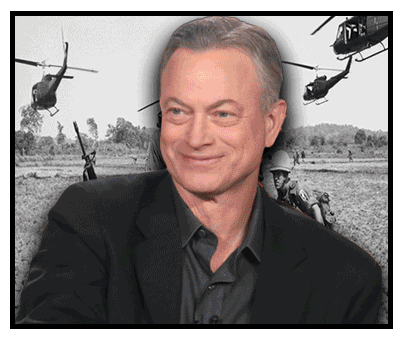 He is a supporter of various veterans' organizations and founded the Lt. Dan Band (named after his character in Forrest Gump), which plays at military bases around the world The Lt. Dan Band is an American cover band originally formed in Chicago in 2003 by Gary Sinise and Kimo Williams to perform at USO shows, entertain troops, and raise money for disabled veterans. The band is named after the character Lieutenant Dan Taylor, whom Sinise portrayed in the film Forrest Gump. Sinise has said in interviews that many people know him by sight as "Lieutenant Dan" rather than by his real name, hence the band's name. The concept came about when Sinise asked for permission to bring musicians on his USO tours. The group was initially known as "Gary Sinise and the Lt. Dan Band". He is a supporter of various veterans' organizations and founded the Lt. Dan Band (named after his character in Forrest Gump), which plays at military bases around the world The Lt. Dan Band is an American cover band originally formed in Chicago in 2003 by Gary Sinise and Kimo Williams to perform at USO shows, entertain troops, and raise money for disabled veterans. The band is named after the character Lieutenant Dan Taylor, whom Sinise portrayed in the film Forrest Gump. Sinise has said in interviews that many people know him by sight as "Lieutenant Dan" rather than by his real name, hence the band's name. The concept came about when Sinise asked for permission to bring musicians on his USO tours. The group was initially known as "Gary Sinise and the Lt. Dan Band".
Read More >>>
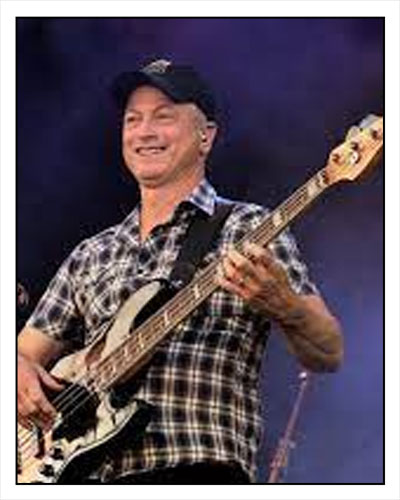 The Lt. Dan Band has grown from the occasional jam session and Chicago-area gigs to performing for charities and non-profit organizations including the United Service Organizations (USO) and Operation Iraqi Children, the latter of which was co-founded by Sinise in March 2004. In 2011, a documentary was released regarding the band and Sinise's work to benefit veterans. They frequently visit military bases in the United States and abroad, as of February 2019 they have played over 400 concerts. The Lt. Dan Band has grown from the occasional jam session and Chicago-area gigs to performing for charities and non-profit organizations including the United Service Organizations (USO) and Operation Iraqi Children, the latter of which was co-founded by Sinise in March 2004. In 2011, a documentary was released regarding the band and Sinise's work to benefit veterans. They frequently visit military bases in the United States and abroad, as of February 2019 they have played over 400 concerts.
Sinise was involved in building a memorial to America's three million, living, disabled veterans. Completed in 2014, the American Veterans Disabled for Life Memorial was built due to the efforts of Sinise and the band championing the cause of the Disabled American Veterans.
|
|
| |
|
WYATT EARP |
 |
 |
|
 |
| |
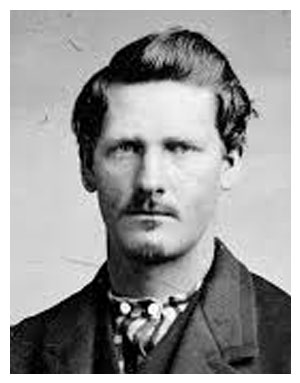 Wyatt Berry Stapp Earp (March 19, 1848 – January 13, 1929) was an American lawman and gambler in the American West, including Dodge City, Deadwood, and Tombstone. Earp was involved in the gunfight at the O.K. Corral, during which lawmen killed three outlaw Cochise County Cowboys. While Wyatt is often depicted as the key figure in the shootout, his brother Virgil was both Deputy U.S. Marshal and Tombstone City Marshal that day and had considerably more experience in law enforcement as a sheriff, constable, and marshal than did Wyatt. Virgil made the decision to enforce a city ordinance prohibiting carrying weapons in town and to disarm the Cowboys. Wyatt was only a temporary assistant marshal to his brother. Wyatt Berry Stapp Earp (March 19, 1848 – January 13, 1929) was an American lawman and gambler in the American West, including Dodge City, Deadwood, and Tombstone. Earp was involved in the gunfight at the O.K. Corral, during which lawmen killed three outlaw Cochise County Cowboys. While Wyatt is often depicted as the key figure in the shootout, his brother Virgil was both Deputy U.S. Marshal and Tombstone City Marshal that day and had considerably more experience in law enforcement as a sheriff, constable, and marshal than did Wyatt. Virgil made the decision to enforce a city ordinance prohibiting carrying weapons in town and to disarm the Cowboys. Wyatt was only a temporary assistant marshal to his brother.
Read More >>>
In 1874, Earp arrived in the boomtown of Wichita, Kansas, where his reputed wife opened a brothel. Wyatt was arrested more than once for his presence in a brothel where he may have been a pimp. He was later appointed to the Wichita police force and developed a solid reputation as a lawman but was fined and "not rehired as a police officer" after getting into a physical altercation with a political opponent of his boss. Earp immediately left Wichita, following his brother James to Dodge City, Kansas where his brother's wife Bessie and Earp's common-law wife Sally operated a brothel. He later became an assistant city marshal. In late 1878, he went to Texas to track down an outlaw, Dave Rudabaugh, and met John "Doc" Holliday, whom Earp credited with saving his life.
Throughout his life, Earp moved between boom towns. He left Dodge in 1879 and moved with his brothers James and Virgil to Tombstone where a silver boom was underway. The Earps clashed with a group of outlaws known as the "Cowboys". Wyatt, Virgil, and younger brother Morgan held various law-enforcement positions that put them in conflict with Tom McLaury, Frank McLaury, Ike Clanton, and Billy Clanton, who threatened to kill the Earps on several occasions. The conflict escalated, culminating in the shootout at the O.K. Corral on October 26, 1881, where the Earps and Doc Holliday killed three Cowboys. During the next five months, Virgil was ambushed and maimed, and Morgan was murdered. Wyatt, Warren Earp, Doc Holliday, and others formed a federal posse that killed three more Cowboys whom they thought responsible. Wyatt was never wounded in any of the gunfights, unlike his brothers Virgil and Morgan or Doc Holliday, which added to his mystique after his death.
After leaving Tombstone, Earp went to San Francisco where he reunited with Josephine Marcus, and they lived as husband and wife. They joined a gold rush to Eagle City, Idaho, where they owned mining interests and a saloon. Back in San Francisco, Wyatt raced horses, but his reputation suffered irreparably when he refereed the Fitzsimmons vs. Sharkey boxing match and called a foul, which led many to believe he fixed the fight. Earp and Marcus joined the Nome Gold Rush in 1899. He and Charlie Hoxie paid US$1,500 (equivalent to $55,000 in 2023) for a liquor license to open the Dexter, a two-story saloon, and made an estimated $80,000 (equivalent to $2,930,000 in 2023). But, Josephine had a notorious gambling habit and the money didn't last. Around 1911, Earp began working several mining claims in Vidal, California, retiring in the hot summers with Josephine to one of several small, modest cottages they rented in Los Angeles. He made friends among early Western actors in Hollywood and tried to get his story told, but he was portrayed during his lifetime only very briefly in one film: Wild Bill Hickok (1923).
Earp died on January 13, 1929. Known as a Western lawman, gunfighter, and boxing referee, he had earned notoriety for his handling of the Fitzsimmons–Sharkey fight and his role in the O.K. Corral gunfight. This changed only after his death when the extremely flattering biography Wyatt Earp: Frontier Marshal by Stuart N. Lake was published in 1931, becoming a bestseller and creating his reputation as a fearless lawman. Since then, Earp's fame and notoriety have been increased by films, television shows, biographies, and works of fiction. Long after his death, he has many devoted detractors and admirers.
|
 |
|
| |
|
| |
 Welcome Home to VSPA! I am writing to you on behalf of the membership of the Vietnam Security Police Association, Inc. (USAF). A thousand plus, and still growing, we extend our sincere appreciation to all who strive to preserve our history and honor our 111 fallen brothers. Welcome Home to VSPA! I am writing to you on behalf of the membership of the Vietnam Security Police Association, Inc. (USAF). A thousand plus, and still growing, we extend our sincere appreciation to all who strive to preserve our history and honor our 111 fallen brothers.
VSPA was formed for many reasons: to reunite friends, VSPA was formed for many reasons: to reunite friends, to preserve the memory of our fallen brothers, the history of our service in Vietnam, and to ensure that the hard lessons learned in Vietnam and Thailand would not be forgotten. Lessons of life and death, forged in war, tempered in battle, that when remembered will provide inspiration to Airmen who are yet to taste combat defending the fortress, and pride for those who have fought and bled with us.
Welcome Home to a very special brotherhood. You may have enjoyed web page stories and photos of bases and squadrons we served at during the Vietnam War. |
|
| |
|
| |
|
|
Vietnam Veterans Memorial, national monument in Washington, D.C.,
|
 |
|
| |
|
| The Wall: Of the 2.7 million Americans who served in the Vietnam war, 304,000 were wounded in action, and 75,000 were disabled. Of the casualties listed on The Wall, approximately 1,300 remain missing in action. |
|
 |
| |
 Vietnam Veterans Memorial, national monument in Vietnam Veterans Memorial, national monument in 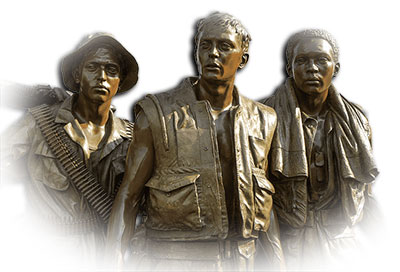 Washington, D.C., honouring members of the U.S. armed forces who served and died in the Vietnam War (1955–75). The memorial, located near the western end of the Mall, is a black granite V-shaped wall inscribed with the names of the approximately 58,000 men and women who were killed or missing in action. It was designed by American architect Maya Lin. Washington, D.C., honouring members of the U.S. armed forces who served and died in the Vietnam War (1955–75). The memorial, located near the western end of the Mall, is a black granite V-shaped wall inscribed with the names of the approximately 58,000 men and women who were killed or missing in action. It was designed by American architect Maya Lin.
Read More >>>
 The Vietnam Veterans Memorial in Washington, D.C. As a senior at Yale University, Lin entered a nationwide competition sponsored by the Vietnam Veterans Memorial Fund, and her design was selected from the more than 1,400 submissions that were received. Lin’s minimal plan was in sharp contrast to the traditional format for a memorial, which usually included figurative heroic sculpture. The design aroused a great deal of controversy, reflecting the lack of resolution of the national conflicts over the war as well as the lack of consensus over what constituted an appropriate memorial at the end of the 20th century. Eventually, a compromise was reached with the commissioning of a traditional statue depicting three servicemen with a flag to stand at the entrance to the memorial. After Lin’s monument was dedicated on November 13, 1982, however, it became a popular and moving tourist attraction. The Vietnam Veterans Memorial in Washington, D.C. As a senior at Yale University, Lin entered a nationwide competition sponsored by the Vietnam Veterans Memorial Fund, and her design was selected from the more than 1,400 submissions that were received. Lin’s minimal plan was in sharp contrast to the traditional format for a memorial, which usually included figurative heroic sculpture. The design aroused a great deal of controversy, reflecting the lack of resolution of the national conflicts over the war as well as the lack of consensus over what constituted an appropriate memorial at the end of the 20th century. Eventually, a compromise was reached with the commissioning of a traditional statue depicting three servicemen with a flag to stand at the entrance to the memorial. After Lin’s monument was dedicated on November 13, 1982, however, it became a popular and moving tourist attraction.
The Three Servicemen, statue by Frederick Hart, at the Vietnam Veterans Memorial in Washington, D.C. On November 11, 1984, the servicemen statue and a U.S. flag were formally added to the memorial, and the combined monument was placed under the control of the National Park Service. In 2009 the Vietnam Veterans Memorial Fund assumed responsibility for the maintenance of the site.
The Three Soldiers statue sits a few feet from the Vietnam Veterans Memorial Wall. This statue was added after the Wall opened to complement it and to offer an alternative memorial for critics who disliked the non-traditional design of the Wall. The sculpture's 3 soldiers represent the diversity of the US military by including a Caucasian, African American, and Latino American whose service branch is intentionally ambiguous. Together, they face the Wall of the fallen.
 In 1993 the Vietnam Women’s Memorial was unveiled a short distance from the wall. The bronze sculpture, depicting three women caring for an injured soldier, recognized the work of the more than 10,000 women who served in Vietnam. In 1993 the Vietnam Women’s Memorial was unveiled a short distance from the wall. The bronze sculpture, depicting three women caring for an injured soldier, recognized the work of the more than 10,000 women who served in Vietnam.
During the Vietnam War, women served in many different roles. Many women served as nurses and physicians while others acted as air traffic controllers, communication specialists, and intelligence officers. The Vietnam Women’s Memorial was established to honor the women who risked their lives to serve their country.
The memorial was dedicated in 1993 and includes a sculpture by Texas artist Glenna Goodacre depicting three women caring for a fallen soldier. Eight yellowwood trees surround the sculpture in honor of the eight servicewomen who gave their lives in Vietnam. The women's names are also among the over 58,000 names on the Vietnam Veterans Memorial.
|
 |
| |
|
 |
 |
Heavy Heart ...
I remember the biting cold as I stepped from my car. I looked toward the National Vietnam Veterans Memorial, and walked with the growing crowd. I saw people clustered from one end to the other of the Memorial ... The Wall.
Read More >>>
A mother called out, "Look honey, here he is ... over here." Wives, sons, daughters, loved ones, and veterans searching for that someone who had touched their life's.
As I approached the black granite Wall, I felt a lump in my throat as the stamina left my legs. I stopped a few feet from the chiseled names and waited as a soldier completed his time with his friend's name and their memories.
With the passing of time memories fade, although some are as clear as my cousins' name this day, some are too fragile to voice, though three decades have passed.
A kneeling soldier rose and walked away looking neither left nor right. I moved toward Panel 03-E, and there he was: Travis O Neal Poss, SGT, Panel 03-E, Line 61. 1st Cav Division (AMBL). Forever age 23, was married, in country Vietnam a day shy of three months, and Killed in Action on 11/15/1965.
There is another name I search for, glimpsing at the panel number repeatedly though I know it by heart: Panel Number 17-W, Line 40. Nearly four years later, and thousands of names, I found: Gary Steven Poss. KIA at age 20, after only two and a half months in country, on 10/05/1969.
A bridge of memories span the many panels between their names. I had touched their names, and it was if they in turned had touched me and Proved to soften my heart for the rest of my life. A feeling that a link still existed between us, as warriors of that war.
I sensed the calling of a Heavy Heart from within The Wall ...
We, who were returned to this side of The Wall came home with the Nation's Flag draped over us. Our Nation and Family put us to rest with a Twenty-one Gun Salute. Our hearts went out to all of you. We saw the hurt that you endured even as you stepped off the plane. Your Welcome Home for us, was seeing the Nation's Flag burning. If you felt a longing to return, that feeling was us standing by your side...and even when you felt unworthy and confused about your country.
We were there when our great Nation turned it's back on you. We watched as they put a crown of hate upon your head.
We were there and felt the scars take their toll, as anti-war demonstrations flared. We saw the look in your eyes, when you felt that serving your country was meanness and somehow not honorable. We were there, when as your brothers and sisters tried to talk to someone about how your life had changed...and when no one cared or would listen.
We felt your anger at acts of treason by Jane Fonda, and the hurt, and harm that cast upon you.
You kept a Roll on your side...and we on ours. Every warrior who fell is known and named by us. Every warrior killed in Vietnam, did not die in Vietnam. Names are still called out to this day as new casualties are found...and of those thousands still dying from Agent Orange.
But, the hardest name to say for us is when one of our own falls to drugs, alcohol ... or just drops out of life. But we are there...even then ... though tears ... we are there.
Those of you who picked up that crown can bear it with pride. We watched as you raised up from scars to become our Police Officer's, Doctor's, Lawyer's, Teacher's, Civil Servants, Warriors, and Blue Collar workers, and professions unknown in our time of life; and most important, parents of our generations future children. Knowing we left our nation in your hands is a comfort to us. We have never forgotten you, as you have not forgotten us. We will be with you, until you are with us.
Larry Poss,
SGT. US Army

POSS, GARY STEVEN
PFC - Army - Selective Service
4th Infantry Division
20 year old Married, Caucasian, Male
Born on 02/03/49
From ST LOUIS, MISSOURI
Tour of duty began on 07/31/69
Casualty was on 10/05/69
in BINH DINH, SOUTH VIETNAM
HOSTILE, GROUND CASUALTY
GUN, SMALL ARMS FIRE
Body was recovered
Religion - ROMAN CATHOLIC
Panel 17W - Line 40

POSS, TRAVIS O'NEAL
SGT - Army - Regular
1st Cav Division (AMBL)
23 year old Married, Caucasian, Male
Born on 02/26/42
From BROOK PARK, OHIO
Length of service 4 years.
Tour of duty began on 08/16/65
Casualty was on 11/15/65
in SOUTH VIETNAM
HOSTILE, GROUND CASUALTY
GUN, SMALL ARMS FIRE
Body was recovered
Religion - BAPTIST
Panel 03E - Line 61
|
|
| |
 |
 |
 |
The Power of a Name by: Valerie
The Castilleja School Palo Alto, CA © 1999
 I never really imagined that a name could have so much meaning. Walking along the Vietnam Veteran’s Memorial I was faced with thousands of names belonging to thousands of people who had each given their lives for our country. I stood there, surrounded by spectators, all quiet in respect and honor, but the personal meaning didn’t reach any deeper than the engraved letters on the wall. To me they were just labels, not the true souls that they represented. I had never known the soldiers who had lost their lives; I hadn’t even been alive to experience the war. I never really imagined that a name could have so much meaning. Walking along the Vietnam Veteran’s Memorial I was faced with thousands of names belonging to thousands of people who had each given their lives for our country. I stood there, surrounded by spectators, all quiet in respect and honor, but the personal meaning didn’t reach any deeper than the engraved letters on the wall. To me they were just labels, not the true souls that they represented. I had never known the soldiers who had lost their lives; I hadn’t even been alive to experience the war.
Read More >>>
I slowly made my way deeper into the list, passing flowers and small gifts left in remembrance. I saw a wreath left by Boy Scout Troop #471, and a letter left by a little girl for her "grampa." For some reason it surprised me that people would come to the memorial to pay their respects to their loved ones. Wasn’t this just a place for tourists to come take pictures of a very historical monument? Besides, they were, after all,just names.
Soon I began to become tired of the repetitive carvings in stone. Row after row, it became harder and harder for me to imagine that each identity listed had a true character and personality. I began to walk on the less crowded side of the path that was farther away from the wall. After snapping a few pictures with my disposable camera, I thought I had experienced the essence of the memorial.
Then I saw something that made my heart fall silent and my feet freeze in their place. There, standing in front of Section 34 on the right half of the wall, was a woman. Her royal blue outfit and white gloves highlighted her dark chocolate skin, making her stand out from the crowd as it rushed past her. It was as if she were in a completely different world, surrounded by nothing except her thoughts. I watched as she reached her gentle hand up and lightly touched the wall in front of her. Slowly, she traced her fingers over the name "Frederick Holeburg.*" She stroked it with such softness and purity, it was as if she had never felt anything more precious in her life. Closing her eyes, she took a breath, and I could see her imagine him standing there in front of her. She didn’t move, as if afraid to lose her husband all over again Her breathing became so deep and relaxed, she seemed to be in a state of complete solitude. I tried not to make any noise, even though I knew she wouldn’t notice. I didn’t want to disturb what seemed to be such a placid and tranquil moment.
By looking at the way she held her hand against the stone, I felt I could see back into the many years they spent in each other’s arms. I could see her smiling at him and touching his face; not just his name. I saw them taking long walks and falling more in love with each other every minute they were together. I could see him holding her hand as long as he could as he had to leave to go and fight in the war. I could see her sitting at home, barely being able to sit still, as she waited to hear news of him. I could see her crying when she found out he had died.
Then, as if she had suddenly awoken from her dream, a tear quickly ran down her cheek. She opened her eyes and looked at the name of the one who had meant more than anything else in the world to her. She began to cry as she leaned her head against the wall. "I love you," she said. "I will always love you."
With that she stood up and wiped her eyes. She pressed her lips against her hand, making sure that her kiss would be felt, and then she touched her husband’s name one last time. Slowly her arm retreated down to her side, and after standing in peace for a minute, she reached into her purse and pulled something out. She placed it on the ground, glanced at the wall once more, and slowly turned and walked away.
I moved closer towards Fred Holeburg’s name. Beneath me I saw a white rose with a maroon red bow tied around it. Next to it lay a white card with calligraphy writing. I leaned over to read what had been written;
"In honor of the best husband, chef, and friend I have ever met: I love you, Fred."
I smiled as a tear rolled down the side of my face. I never guessed that a complete stranger could have such an effect on me without even knowing. In those twenty minutes I learned more about life and about myself than I could have ever aspired to learn in months. I learned what it means to truly love someone. I discovered that some people are cherished so much in life and death that the sight of their name can cause great emotion in those they have touched.
Fred Holeburg had made an impact that went deeper than the engraved letters of his name. Fred Holeburg affected the fate of his country; Fred Holeburg affected the soul of his wife; and unintentionally, Fred Holeburg affected my heart. To me he was no longer just a name on the side of the wall. Even though I had never met him, I knew he was a hero, and that he deserved so much more recognition than he received, as did the other thousands of names that stood in front of me. Looking around, I no longer saw thousands of words; I saw thousands of brothers, grandparents, husbands and sons. I saw inspiring people who each had been adored by their loved ones. Only then did I realize the essence of the Vietnam Memorial. It is not a name that needs to be remembered, it is a person.
I then quickly began frantically reading the names on the wall, trying not to miss one of the remarkable soldiers that undoubtedly deserved so much more than just a glance. I wanted to understand and learn about each man who had lost his life, but then I became aware of the amazing magnitude of the memorial.
As it was time to leave, I thought of the countless soldiers’ names that I did not even have time to read, let alone get to know. Even though I couldn’t get to know each soldier in the war, my eyes had been opened to a new world of perspective.
I walked away from the wall, the names growing smaller with every step I took. Finally they were no longer visible, and I said good-bye to the names I had read, and the heroes I had respected.
* Name used is fictional.
Valerie is thirteen years old. She visited The Wall while on a class visit to Washington D.C. She is an 8th grade student [1999] at The Castilleja School in Palo Alto, California.
This story was sent to us by her teacher, Nancy Ware.
|
| |
 |
|
|

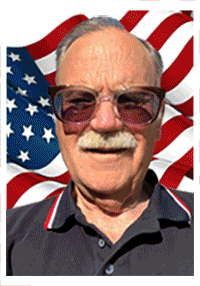



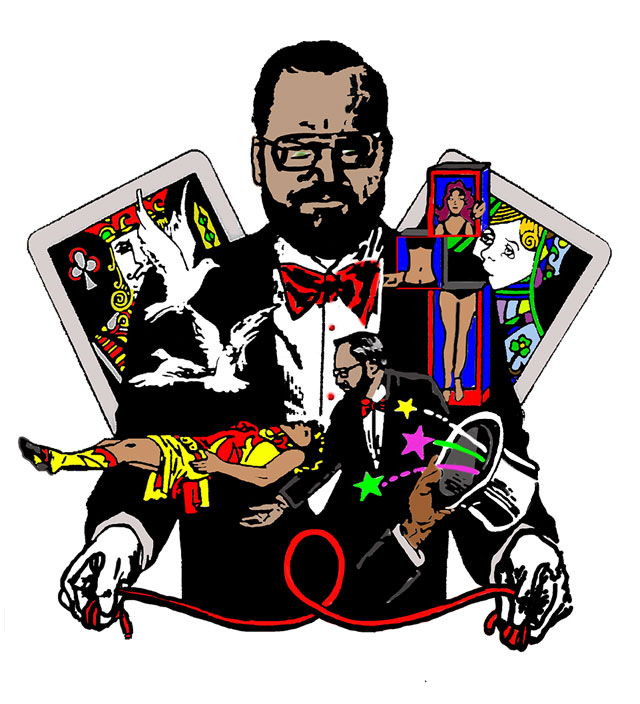
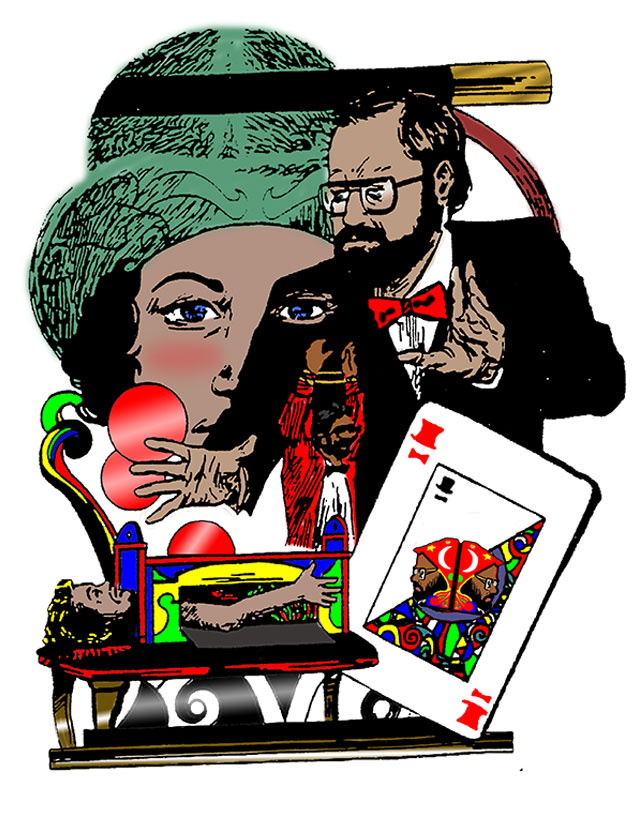
 For God so loved the world, that he gave his only begotten Son, that whosoever believeth in him should not perish, but have everlasting life.... John 3:16
For God so loved the world, that he gave his only begotten Son, that whosoever believeth in him should not perish, but have everlasting life.... John 3:16
 Jesus Christ plays a central role in our beliefs and in our lives. Our mission is to invite all of God’s children to follow Jesus and experience the joy that is possible because of Him.
Jesus Christ plays a central role in our beliefs and in our lives. Our mission is to invite all of God’s children to follow Jesus and experience the joy that is possible because of Him.  Dad was a very hard worker always doing something and doing it very well. I can remember watching him build a project with no plans or supply list. When he would start a project, he always had the blueprint in his head. I was always amazed when he finished the job, there were no scraps. It didn’t matter if it was concrete work, brick, carpentry or metal, dad knew how to do
Dad was a very hard worker always doing something and doing it very well. I can remember watching him build a project with no plans or supply list. When he would start a project, he always had the blueprint in his head. I was always amazed when he finished the job, there were no scraps. It didn’t matter if it was concrete work, brick, carpentry or metal, dad knew how to do Mom was always there for us and very understanding even with 4 boys. In 1957, mom told dad day she wanted a pink Cadillac, so of course dad bought her a new 1957 Pink Cadillac. One day Mom came home with a half dozen ping pong paddles with attached rubber band to the red rubber balls. We thought that was great until she snapped off the rubber bands … we knew it wasn’t good. She told us she was tired of us growing boys laughing when she swatted us for the latest transgressions and was going to place the paddles around the house so they would be close when needed. Mom was about 5 ft tall, we were taller and growing but she always ruled the roost with us. We knew for certain we were in trouble when she said, ‘just wait till your dad gets home!’ Dad would always show up in a good mood and glad to be home from work, until mom said, “Honey do you know what your son did?” You could see dad’s face as she made her statement, he really didn’t want to deal with it. The look was always followed by, “Boy, this is going to hurt me more than it hurts you.” Maybe you have also heard this statement. With no Air conditioner back then, when it was hot, mom would shew us boys out ‘to play’ and tell us to be back when the streetlight came on.
Mom was always there for us and very understanding even with 4 boys. In 1957, mom told dad day she wanted a pink Cadillac, so of course dad bought her a new 1957 Pink Cadillac. One day Mom came home with a half dozen ping pong paddles with attached rubber band to the red rubber balls. We thought that was great until she snapped off the rubber bands … we knew it wasn’t good. She told us she was tired of us growing boys laughing when she swatted us for the latest transgressions and was going to place the paddles around the house so they would be close when needed. Mom was about 5 ft tall, we were taller and growing but she always ruled the roost with us. We knew for certain we were in trouble when she said, ‘just wait till your dad gets home!’ Dad would always show up in a good mood and glad to be home from work, until mom said, “Honey do you know what your son did?” You could see dad’s face as she made her statement, he really didn’t want to deal with it. The look was always followed by, “Boy, this is going to hurt me more than it hurts you.” Maybe you have also heard this statement. With no Air conditioner back then, when it was hot, mom would shew us boys out ‘to play’ and tell us to be back when the streetlight came on.  What can I say about my brothers. I was very blessed to have my brother Ray, Don, and Jerry. From Ray rescuing me from a cliff in Apple Valley California. And, watching him being able to do anything. Don for spending time with him in a patrol car keeping citizens safe. And Jerry being there when I got in trouble and getting me out of in. Having a bedroom that was named THE J&L RANCH.
What can I say about my brothers. I was very blessed to have my brother Ray, Don, and Jerry. From Ray rescuing me from a cliff in Apple Valley California. And, watching him being able to do anything. Don for spending time with him in a patrol car keeping citizens safe. And Jerry being there when I got in trouble and getting me out of in. Having a bedroom that was named THE J&L RANCH. 



 In 1968, Americans were asking, "Do you know the way to San
Jose?" as Diane Warwicke serenading this great land of ours
with her songs. I never made it to San Jose, but Uncle Sam
showed me the way to Fort Ord, California.
In 1968, Americans were asking, "Do you know the way to San
Jose?" as Diane Warwicke serenading this great land of ours
with her songs. I never made it to San Jose, but Uncle Sam
showed me the way to Fort Ord, California.  I thought from the day I saw her I noticed her humor and her love for life. She was my 1st only wife although we got a divorce, she had been a wonderful mother to our children. I watch her conquering nursing school and become a wonderful nurse. We had four wonderful children together, each of our children was very much wanted in our lives. Andi wherever you are I wish you the best of luck and love
I thought from the day I saw her I noticed her humor and her love for life. She was my 1st only wife although we got a divorce, she had been a wonderful mother to our children. I watch her conquering nursing school and become a wonderful nurse. We had four wonderful children together, each of our children was very much wanted in our lives. Andi wherever you are I wish you the best of luck and love Ann came into my life in the late 80’s. Our friendship goes with out saying. Ann is one of a kind. Her love for family and God is what make her stand out among others. Ann passion for the well-being of others is unmatchable.
Ann came into my life in the late 80’s. Our friendship goes with out saying. Ann is one of a kind. Her love for family and God is what make her stand out among others. Ann passion for the well-being of others is unmatchable.  Susan, well she can light up any room or make anyone smile. Just being around, she shines a light on your day. She always finds a silver light in all things.
Susan, well she can light up any room or make anyone smile. Just being around, she shines a light on your day. She always finds a silver light in all things.  Abbott and Costello were an American comedy duo composed of comedians Bud Abbott and Lou Costello, whose work in radio, film, and television made them the most popular comedy team of the 1940s and 1950s, and the highest-paid entertainers in the world during the Second World War. Their patter routine "Who's on First?" is considered one of the greatest comedy routines of all time, a version of which appears in their 1945 film The Naughty Nineties.
Abbott and Costello were an American comedy duo composed of comedians Bud Abbott and Lou Costello, whose work in radio, film, and television made them the most popular comedy team of the 1940s and 1950s, and the highest-paid entertainers in the world during the Second World War. Their patter routine "Who's on First?" is considered one of the greatest comedy routines of all time, a version of which appears in their 1945 film The Naughty Nineties.
 As a young man, Costello greatly admired Charlie Chaplin. In 1927 he moved to Hollywood, where he worked as a stuntman; after an injury he quit stunt work to perform in New York burlesque. Although he had never worked onstage before, he quickly became one of the top burlesque comics and learned the hundreds of standard comedy routines of the circuit. Those stock routines allowed comics to work interchangeably with a variety of partners (often on a moment’s notice); in such informal pairings, Abbott and Costello performed together sporadically throughout the early 1930s, before their official teaming in early 1936.
As a young man, Costello greatly admired Charlie Chaplin. In 1927 he moved to Hollywood, where he worked as a stuntman; after an injury he quit stunt work to perform in New York burlesque. Although he had never worked onstage before, he quickly became one of the top burlesque comics and learned the hundreds of standard comedy routines of the circuit. Those stock routines allowed comics to work interchangeably with a variety of partners (often on a moment’s notice); in such informal pairings, Abbott and Costello performed together sporadically throughout the early 1930s, before their official teaming in early 1936.
 I was born February 12, 1809 in Hardin County, Kentucky. My father removed from Kentucky to what is now Spencer County, Indiana in my eighth year. There, I grew up. My mother, who died in my tenth year, was of a family of the name of Hanks. I went to A-B-C schools by littles.
I was born February 12, 1809 in Hardin County, Kentucky. My father removed from Kentucky to what is now Spencer County, Indiana in my eighth year. There, I grew up. My mother, who died in my tenth year, was of a family of the name of Hanks. I went to A-B-C schools by littles.  (May 26, 1886 – October 23, 1950)
(May 26, 1886 – October 23, 1950) Among the many songs he popularized were "You Made Me Love You (I Didn't Want to Do It)," "Rock-A-Bye Your Baby With A Dixie Melody," "Swanee" (songwriter George Gershwin's first success), "April Showers," "Toot, Toot, Tootsie, Goodbye," "California, Here I Come," "When the Red, Red Robin Comes Bob-Bob-Bobbin' Along," "Sonny Boy," and "Avalon."
Among the many songs he popularized were "You Made Me Love You (I Didn't Want to Do It)," "Rock-A-Bye Your Baby With A Dixie Melody," "Swanee" (songwriter George Gershwin's first success), "April Showers," "Toot, Toot, Tootsie, Goodbye," "California, Here I Come," "When the Red, Red Robin Comes Bob-Bob-Bobbin' Along," "Sonny Boy," and "Avalon." After dancing the lead in Walt Disney's production of Swan Lake at the Starlight Bowl in Burbank, California, in 1955, Funicello was invited by Disney to audition for his new children's show, The Mickey Mouse Club. She landed a part on the show, which premiered in October 1955, when Funicello was just 13 years old, and soon became the series' the most popular "Mouseketeer." Audiences regularly tuned in to watch Funicello and other members of the children's variety show perform song and dance routines in turtle-neck sweaters displaying their names in big block letters, blue skirts/slacks and, most notably, mouse-eared beanies.
After dancing the lead in Walt Disney's production of Swan Lake at the Starlight Bowl in Burbank, California, in 1955, Funicello was invited by Disney to audition for his new children's show, The Mickey Mouse Club. She landed a part on the show, which premiered in October 1955, when Funicello was just 13 years old, and soon became the series' the most popular "Mouseketeer." Audiences regularly tuned in to watch Funicello and other members of the children's variety show perform song and dance routines in turtle-neck sweaters displaying their names in big block letters, blue skirts/slacks and, most notably, mouse-eared beanies. After leaving The Mickey Mouse Club, Annette Funicello remained under contract to Disney and appeared on TV shows such as Zorro (1957) and The Nine Lives of Elfego Baca (1958). She also starred in a number of Disney feature films, including The Shaggy Dog (1959), Babes in Toyland (1961), The Misadventures of Merlin Jones (1964) and The Monkey's Uncle (1965).
After leaving The Mickey Mouse Club, Annette Funicello remained under contract to Disney and appeared on TV shows such as Zorro (1957) and The Nine Lives of Elfego Baca (1958). She also starred in a number of Disney feature films, including The Shaggy Dog (1959), Babes in Toyland (1961), The Misadventures of Merlin Jones (1964) and The Monkey's Uncle (1965). George Herman "Babe" Ruth (February 6, 1895 – August 16, 1948) was an American professional baseball player whose career in Major League Baseball (MLB) spanned 22 seasons, from 1914 throughm 1935. Nicknamed "the Bambino" and "the Sultan of Swat", he began his MLB career as a star left-handed pitcher for the Boston Red Sox, but achieved his greatest fame as a slugging outfielder for the New York Yankees.
George Herman "Babe" Ruth (February 6, 1895 – August 16, 1948) was an American professional baseball player whose career in Major League Baseball (MLB) spanned 22 seasons, from 1914 throughm 1935. Nicknamed "the Bambino" and "the Sultan of Swat", he began his MLB career as a star left-handed pitcher for the Boston Red Sox, but achieved his greatest fame as a slugging outfielder for the New York Yankees.  In 1922 Ruth’s home run totals dropped to 35, but in 1923—with the opening of the magnificent new Yankee Stadium, dubbed by a sportswriter “The House That Ruth Built”—he hit 41 home runs, batted .393, and had a record-shattering slugging percentage (total bases divided by at bats) of .764. He continued with a strong season in 1924 when he hit a league-leading 46 home runs, but in 1925, while suffering from an intestinal disorder (thought by many to be syphilis), his offensive production declined sharply. That season, while playing in only 98 games, he hit 25 home runs.
In 1922 Ruth’s home run totals dropped to 35, but in 1923—with the opening of the magnificent new Yankee Stadium, dubbed by a sportswriter “The House That Ruth Built”—he hit 41 home runs, batted .393, and had a record-shattering slugging percentage (total bases divided by at bats) of .764. He continued with a strong season in 1924 when he hit a league-leading 46 home runs, but in 1925, while suffering from an intestinal disorder (thought by many to be syphilis), his offensive production declined sharply. That season, while playing in only 98 games, he hit 25 home runs. Leslie Townes "Bob" Hope (May 29, 1903 – July 27, 2003) was a British-born.
Leslie Townes "Bob" Hope (May 29, 1903 – July 27, 2003) was a British-born.  Presenting the Distinguished Service Medal to Hope in 1946, Past National Commander John R. Quinn called the entertainer "the personal jester of every man and woman in uniform ... Wherever they were - in foxhole, Quonset hut, jungle or warship - he administered the toxin of cheer and laughter. ... He has flown one-half million miles to perform in the din of the front lines as well as in the hush of hospitals."
Presenting the Distinguished Service Medal to Hope in 1946, Past National Commander John R. Quinn called the entertainer "the personal jester of every man and woman in uniform ... Wherever they were - in foxhole, Quonset hut, jungle or warship - he administered the toxin of cheer and laughter. ... He has flown one-half million miles to perform in the din of the front lines as well as in the hush of hospitals." Hope was the fifth of seven sons of a stonemason and a former Welsh concert singer; his family immigrated to the United States when he was four years old. He grew up in Cleveland, Ohio, manifesting the first signs of his vocation at age 10 when he won a Charlie Chaplin imitation contest. After a series of odd jobs, including amateur boxer, Hope during his late teens embarked on an entertainment career and later performed with a succession of partners in vaudeville. He first appeared on Broadway in Sidewalks of New York (1927), and after additional work in vaudeville and a failed Hollywood screen test, he landed his first substantial stage role in the Jerome Kern musical Roberta (1933). During the mid-1930s he starred in a series of comedy shorts and found increasing success in radio, a medium well-suited to his loquacious style. Hope made his feature-film debut in The Big Broadcast of 1938 (1938), in which he first sang his signature tune “Thanks for the Memory,” and he launched the long-running The Bob Hope Show on radio in that same year. By the end of the decade, Hope was one of America’s most popular comics.
Hope was the fifth of seven sons of a stonemason and a former Welsh concert singer; his family immigrated to the United States when he was four years old. He grew up in Cleveland, Ohio, manifesting the first signs of his vocation at age 10 when he won a Charlie Chaplin imitation contest. After a series of odd jobs, including amateur boxer, Hope during his late teens embarked on an entertainment career and later performed with a succession of partners in vaudeville. He first appeared on Broadway in Sidewalks of New York (1927), and after additional work in vaudeville and a failed Hollywood screen test, he landed his first substantial stage role in the Jerome Kern musical Roberta (1933). During the mid-1930s he starred in a series of comedy shorts and found increasing success in radio, a medium well-suited to his loquacious style. Hope made his feature-film debut in The Big Broadcast of 1938 (1938), in which he first sang his signature tune “Thanks for the Memory,” and he launched the long-running The Bob Hope Show on radio in that same year. By the end of the decade, Hope was one of America’s most popular comics.
 Doris Day (born Doris Mary Anne Kappelhoff; April 3, 1922 – May 13, 2019)
Doris Day (born Doris Mary Anne Kappelhoff; April 3, 1922 – May 13, 2019) Between “Romance on the High Seas” in 1948 and “With Six You Get Eggroll” in 1968, she starred in nearly 40 movies. On the screen she turned from the perky girl next door in the 1950s to the woman next door in a series of 1960s sex comedies that brought her four first-place rankings in the yearly popularity poll of theater owners, an accomplishment equaled by no other actress except Shirley Temple.
Between “Romance on the High Seas” in 1948 and “With Six You Get Eggroll” in 1968, she starred in nearly 40 movies. On the screen she turned from the perky girl next door in the 1950s to the woman next door in a series of 1960s sex comedies that brought her four first-place rankings in the yearly popularity poll of theater owners, an accomplishment equaled by no other actress except Shirley Temple. John Henry Holliday (August 14, 1851 – November 8, 1887), better known as Doc Holliday, was an American dentist, gambler, and gunfighter who was a close friend and associate of lawman Wyatt Earp. Holliday is best known for his role in the events surrounding and his participation in the gunfight at the O.K. Corral in Tombstone, Arizona. He developed a reputation as having killed more than a dozen men in various altercations, but modern researchers have concluded that, contrary to popular myth-making, Holliday killed only one to three men. Holliday's colorful life and character have been depicted in many books and portrayed by well-known actors in numerous movies and television series.
John Henry Holliday (August 14, 1851 – November 8, 1887), better known as Doc Holliday, was an American dentist, gambler, and gunfighter who was a close friend and associate of lawman Wyatt Earp. Holliday is best known for his role in the events surrounding and his participation in the gunfight at the O.K. Corral in Tombstone, Arizona. He developed a reputation as having killed more than a dozen men in various altercations, but modern researchers have concluded that, contrary to popular myth-making, Holliday killed only one to three men. Holliday's colorful life and character have been depicted in many books and portrayed by well-known actors in numerous movies and television series.  Elizabeth Victoria Montgomery (April 15, 1933 – May 18, 1995) was an American actress whose career spanned five decades in film, stage, and television. She portrayed the good witch Samantha Stephens on the popular television series Bewitched, which earned her five Primetime Emmy Award nominations and four Golden Globe Award nominations.
Elizabeth Victoria Montgomery (April 15, 1933 – May 18, 1995) was an American actress whose career spanned five decades in film, stage, and television. She portrayed the good witch Samantha Stephens on the popular television series Bewitched, which earned her five Primetime Emmy Award nominations and four Golden Globe Award nominations.  performers from the mid-1950s until his death.
performers from the mid-1950s until his death.  Presley knew some of this music from the radio, some of it from his parents’ Pentecostal church and the group sings he attended at the Rev. H.W. Brewster’s Black Memphis church, and some of it from the Beale Street blues clubs he began frequenting as a teenager.
Presley knew some of this music from the radio, some of it from his parents’ Pentecostal church and the group sings he attended at the Rev. H.W. Brewster’s Black Memphis church, and some of it from the Beale Street blues clubs he began frequenting as a teenager. Almost immediately upon hearing of his death, mourners from around the world gathered at Graceland to say farewell to the poor boy who had lived out the American dream. In a way, that mourning has never ceased: Graceland remains one of the country’s top tourist attractions, and Presley’s albums and other artifacts continue to sell briskly. Each August crowds flock to Graceland—which, under the direction of Priscilla Presley, first opened to the public in 1982—to honour him on the anniversary not of his birth but of his death. From time to time, rumours cropped up that he did not really die, that his death was a fake designed to free him from fame. Elvis impersonators are legion. His biggest fans—working-class white women, almost exclusively—passed their fanaticism on to their children, or at least to a surprising number of daughters. “Elvis has left the building,” but those who are still inside have decided to carry on regardless. Once more, Elvis Presley is triumphant, although this triumph is shadowed by something far less than happiness.
Almost immediately upon hearing of his death, mourners from around the world gathered at Graceland to say farewell to the poor boy who had lived out the American dream. In a way, that mourning has never ceased: Graceland remains one of the country’s top tourist attractions, and Presley’s albums and other artifacts continue to sell briskly. Each August crowds flock to Graceland—which, under the direction of Priscilla Presley, first opened to the public in 1982—to honour him on the anniversary not of his birth but of his death. From time to time, rumours cropped up that he did not really die, that his death was a fake designed to free him from fame. Elvis impersonators are legion. His biggest fans—working-class white women, almost exclusively—passed their fanaticism on to their children, or at least to a surprising number of daughters. “Elvis has left the building,” but those who are still inside have decided to carry on regardless. Once more, Elvis Presley is triumphant, although this triumph is shadowed by something far less than happiness. Orvon Grover "Gene" Autry (September 29, 1907 – October 2, 1998
Orvon Grover "Gene" Autry (September 29, 1907 – October 2, 1998 Composer, songwriter ("Back in the Saddle Again","That Silver Haired Daddy of Mine"), actor, author and businessman, educated at Ravia (Oklahoma) High School. In World War he was a flight officer for the United States Army Air Force. He won the National Parents-Teachers Film Award for the films and television programs he produced. He joined ASCAP in 1939, and his other popular-song compositions include: "Here Comes Santa Claus"; "Be Honest With Me"; "Tears on My Pillow"; "Dixie Cannonball"; "Good Old-Fashioned Hoedown"; "You're the Only Star in My Blue Heaven"; and "I Wish I Had Never Met Sunshine".
Composer, songwriter ("Back in the Saddle Again","That Silver Haired Daddy of Mine"), actor, author and businessman, educated at Ravia (Oklahoma) High School. In World War he was a flight officer for the United States Army Air Force. He won the National Parents-Teachers Film Award for the films and television programs he produced. He joined ASCAP in 1939, and his other popular-song compositions include: "Here Comes Santa Claus"; "Be Honest With Me"; "Tears on My Pillow"; "Dixie Cannonball"; "Good Old-Fashioned Hoedown"; "You're the Only Star in My Blue Heaven"; and "I Wish I Had Never Met Sunshine".  Orvon Gene Autry is considered by many to be the greatest western star of all time. He earned the designation of "America's Favorite Cowboy". He was "discovered" by Will Rogers while working as a telegrapher. One of his stars on the Walk of fame is for Live Performance (including rodeo), not live theater. Also, "That Silver-Haired Daddy of Mine" sold over 500,000 copies in its first release. He is the first artist in history to have a gold record. Also, he is also the first artist to ever sell 1,000,000 copies of a record - "That Silver-Haired Daddy of Mine". He was also the first artist ever to sell out Madison Square Garden. His song "Rudolph the Red-Nosed Reindeer" is the second highest selling Christmas song of all time. It has sold over 30 million copies.
Orvon Gene Autry is considered by many to be the greatest western star of all time. He earned the designation of "America's Favorite Cowboy". He was "discovered" by Will Rogers while working as a telegrapher. One of his stars on the Walk of fame is for Live Performance (including rodeo), not live theater. Also, "That Silver-Haired Daddy of Mine" sold over 500,000 copies in its first release. He is the first artist in history to have a gold record. Also, he is also the first artist to ever sell 1,000,000 copies of a record - "That Silver-Haired Daddy of Mine". He was also the first artist ever to sell out Madison Square Garden. His song "Rudolph the Red-Nosed Reindeer" is the second highest selling Christmas song of all time. It has sold over 30 million copies. Henry John Deutschendorf Jr. (December 31, 1943 – October 12, 1997), known professionally as John Denver, was an American singer and songwriter. He was one of the most popular acoustic artists of the 1970s and one of the best-selling artists in that decade. AllMusic has called Denver "among the most beloved entertainers of his era".
Henry John Deutschendorf Jr. (December 31, 1943 – October 12, 1997), known professionally as John Denver, was an American singer and songwriter. He was one of the most popular acoustic artists of the 1970s and one of the best-selling artists in that decade. AllMusic has called Denver "among the most beloved entertainers of his era". Colorado state legislature also adopted "Rocky Mountain High" as one of its two state songs in 2007, and West Virginia did the same for "Take Me Home, Country Roads" in 2014.
Colorado state legislature also adopted "Rocky Mountain High" as one of its two state songs in 2007, and West Virginia did the same for "Take Me Home, Country Roads" in 2014. John R. Cash (born J. R. Cash; February 26, 1932 – September 12, 2003) was an American country singer-songwriter. Most of Cash's music contains themes of sorrow, moral tribulation, and redemption, especially songs from the later stages of his career. He was known for his deep, calm, bass-baritone voice, the distinctive sound of his Tennessee Three backing band that was characterized by its train-like chugging guitar rhythms, a rebelliousness coupled with an increasingly somber and humble demeanor, and his free prison concerts. Cash wore a trademark all-black stage wardrobe, which earned him the nickname as the "Man in Black".
John R. Cash (born J. R. Cash; February 26, 1932 – September 12, 2003) was an American country singer-songwriter. Most of Cash's music contains themes of sorrow, moral tribulation, and redemption, especially songs from the later stages of his career. He was known for his deep, calm, bass-baritone voice, the distinctive sound of his Tennessee Three backing band that was characterized by its train-like chugging guitar rhythms, a rebelliousness coupled with an increasingly somber and humble demeanor, and his free prison concerts. Cash wore a trademark all-black stage wardrobe, which earned him the nickname as the "Man in Black".  Marion Robert Morrison (May 26, 1907 – June 11, 1979), professionally known as John Wayne and nicknamed The Duke or Duke
Marion Robert Morrison (May 26, 1907 – June 11, 1979), professionally known as John Wayne and nicknamed The Duke or Duke  with him, John Wayne was hardly a close-minded type who wrapped himself in the flag and refused to listen to opposing points of view. As long as someone wasn’t trying to shut down the opposition, he was all in favor of letting everyone voice their opinion on the issues confronting us as a country.
with him, John Wayne was hardly a close-minded type who wrapped himself in the flag and refused to listen to opposing points of view. As long as someone wasn’t trying to shut down the opposition, he was all in favor of letting everyone voice their opinion on the issues confronting us as a country. s
s Hee Haw is an American television variety show featuring country music and humor with the fictional rural "Kornfield Kounty" as the backdrop. It aired from 1969 to 1993, and on TNN from 1996 to 1997.
Hee Haw is an American television variety show featuring country music and humor with the fictional rural "Kornfield Kounty" as the backdrop. It aired from 1969 to 1993, and on TNN from 1996 to 1997.  Welk Show and Soul Train, which targeted older and black audiences, respectively, also rose to prominence in syndication during the era. Like Laugh-In, the show minimized production costs by taping all of the recurring sketches for a season in batches, setting up the cornfield set one day, the joke fence on another, etc. At its peak, a season's worth of shows were recorded over the course of two separate, week-long shoots, and then assembled in the editing suite. Only musical performances were taped with a live audience.
Welk Show and Soul Train, which targeted older and black audiences, respectively, also rose to prominence in syndication during the era. Like Laugh-In, the show minimized production costs by taping all of the recurring sketches for a season in batches, setting up the cornfield set one day, the joke fence on another, etc. At its peak, a season's worth of shows were recorded over the course of two separate, week-long shoots, and then assembled in the editing suite. Only musical performances were taped with a live audience. "Say, kids, what time is it?" Resounding from the peanut gallery—and from millions of television-watching kids around the country—came the reply, "It's Howdy Doody time!"
"Say, kids, what time is it?" Resounding from the peanut gallery—and from millions of television-watching kids around the country—came the reply, "It's Howdy Doody time!"  Mac Davis, Pop and Country Singing Star, Is Dead at 78
Mac Davis, Pop and Country Singing Star, Is Dead at 78  Martin Luther King, Jr. (born January 15, 1929, Atlanta, Georgia, U.S.—died April 4, 1968, Memphis, Tennessee) Baptist minister and social activist who led the civil rights movement in the United States from the mid-1950s until his death by assassination in 1968.
Martin Luther King, Jr. (born January 15, 1929, Atlanta, Georgia, U.S.—died April 4, 1968, Memphis, Tennessee) Baptist minister and social activist who led the civil rights movement in the United States from the mid-1950s until his death by assassination in 1968.  grassroots activists such as Rosa Parks, Fred Shuttlesworth, and others prepared the way for King’s rise to national prominence, biographers and historians have questioned the view that Southern Black protest movements relied on King’s charismatic guidance. Nonetheless, studies of King continue to acknowledge his distinctive leadership role. For example, though he often downplayed his contribution to the Montgomery bus boycott, King’s inspirational leadership and his speeches helped to transform a local protest over bus seating into a historically important event. More generally, studies of King have suggested that his most significant contribution to the modern African American freedom struggle was to link Black aspirations to transcendent, widely shared democratic and Christian ideals. While helping grassroots leaders mobilize African Americans for sustained mass struggles, he inspired participants to believe that their cause was just and consistent with traditional American egalitarian values. King also appealed to the consciences of all Americans, thus building popular support for civil rights reform. His strategy of emphasizing nonviolent protest and interracial cooperation enabled him to fight effectively against the Southern system of legalized racial segregation and discrimination, but it also proved inadequate during his final years as he sought to overcome racial and economic problems that were national in scope.
grassroots activists such as Rosa Parks, Fred Shuttlesworth, and others prepared the way for King’s rise to national prominence, biographers and historians have questioned the view that Southern Black protest movements relied on King’s charismatic guidance. Nonetheless, studies of King continue to acknowledge his distinctive leadership role. For example, though he often downplayed his contribution to the Montgomery bus boycott, King’s inspirational leadership and his speeches helped to transform a local protest over bus seating into a historically important event. More generally, studies of King have suggested that his most significant contribution to the modern African American freedom struggle was to link Black aspirations to transcendent, widely shared democratic and Christian ideals. While helping grassroots leaders mobilize African Americans for sustained mass struggles, he inspired participants to believe that their cause was just and consistent with traditional American egalitarian values. King also appealed to the consciences of all Americans, thus building popular support for civil rights reform. His strategy of emphasizing nonviolent protest and interracial cooperation enabled him to fight effectively against the Southern system of legalized racial segregation and discrimination, but it also proved inadequate during his final years as he sought to overcome racial and economic problems that were national in scope. Mary Tyler Moore (December 29, 1936 – January 25, 2017) was an American actress, producer, and social advocate. She is best known for her roles on The Dick Van Dyke Show (1961–1966) and The Mary Tyler Moore Show (1970–1977), which "helped define a new vision of American womanhood" and "appealed to an audience facing the new trials of modern-day existence". Moore won seven Primetime Emmy Awards and three Golden Globe Awards. She was nominated for the Academy Award for Best Actress for her performance in Ordinary People.
Mary Tyler Moore (December 29, 1936 – January 25, 2017) was an American actress, producer, and social advocate. She is best known for her roles on The Dick Van Dyke Show (1961–1966) and The Mary Tyler Moore Show (1970–1977), which "helped define a new vision of American womanhood" and "appealed to an audience facing the new trials of modern-day existence". Moore won seven Primetime Emmy Awards and three Golden Globe Awards. She was nominated for the Academy Award for Best Actress for her performance in Ordinary People. Merle Ronald Haggard (April 6, 1937 – April 6, 2016) was an American country music singer, songwriter, guitarist, and fiddler.
Merle Ronald Haggard (April 6, 1937 – April 6, 2016) was an American country music singer, songwriter, guitarist, and fiddler. He received many honors and awards for his music, including a Kennedy Center Honor (2010); a Grammy Lifetime Achievement Award (2006); a BMI Icon Award (2006); and induction into the Nashville Songwriters Hall of Fame (1977); Country Music Hall of Fame (1994) and Oklahoma Music Hall of Fame (1997). He died on April 6, 2016—his 79th birthday—at his ranch in Shasta County, California, having recently suffered from double pneumonia.
He received many honors and awards for his music, including a Kennedy Center Honor (2010); a Grammy Lifetime Achievement Award (2006); a BMI Icon Award (2006); and induction into the Nashville Songwriters Hall of Fame (1977); Country Music Hall of Fame (1994) and Oklahoma Music Hall of Fame (1997). He died on April 6, 2016—his 79th birthday—at his ranch in Shasta County, California, having recently suffered from double pneumonia.  The Mickey Mouse Club
The Mickey Mouse Club James Wesley Dodd was an American actor, singer and songwriter best known as the master of ceremonies for the popular 1950s Walt Disney television series The Mickey Mouse Club, as well as the writer of its well-known theme song "The Mickey Mouse Club March."
James Wesley Dodd was an American actor, singer and songwriter best known as the master of ceremonies for the popular 1950s Walt Disney television series The Mickey Mouse Club, as well as the writer of its well-known theme song "The Mickey Mouse Club March." 







 Karen Anita Pendleton (August 1, 1946 – October 6, 2019) was an original Mickey Mouse Club Mouseketeer on the ABC television series from 1955 to 1959. She was one of only nine Mouseketeers who were on the show during its entire original run.
Karen Anita Pendleton (August 1, 1946 – October 6, 2019) was an original Mickey Mouse Club Mouseketeer on the ABC television series from 1955 to 1959. She was one of only nine Mouseketeers who were on the show during its entire original run.
 States and Britain in the late 19th and early 20th centuries. Initially these shows were staged by all-male companies that included male alto and soprano singers. The larger Black minstrel shows included bands of multitalented instrumentalists to play marches for the troupe’s parades in the daytime and perform string accompaniments for the evening shows. In addition to some music by Stephen Foster, their repertoire featured music by Black composers such as James Bland, a popular singer-banjoist who wrote some 700 songs, including “Carry Me Back to Old Virginny.” In general, these minstrel shows were the only theatrical medium in which gifted Black performers of the period could support themselves.
States and Britain in the late 19th and early 20th centuries. Initially these shows were staged by all-male companies that included male alto and soprano singers. The larger Black minstrel shows included bands of multitalented instrumentalists to play marches for the troupe’s parades in the daytime and perform string accompaniments for the evening shows. In addition to some music by Stephen Foster, their repertoire featured music by Black composers such as James Bland, a popular singer-banjoist who wrote some 700 songs, including “Carry Me Back to Old Virginny.” In general, these minstrel shows were the only theatrical medium in which gifted Black performers of the period could support themselves.  22 February 1980, Lake Placid, New York, USA
22 February 1980, Lake Placid, New York, USA For the first game in the medal round, the United States played the Soviets. Finishing the first period tied at 2–2, and the Soviets leading 3–2 following the second, the U.S. team scored two more goals to take their first lead midway in the third and final period, then held on and won 4–3. Two days later, the U.S. won the gold medal by beating Finland in their final game. The Soviet Union took the silver medal by beating Sweden.
For the first game in the medal round, the United States played the Soviets. Finishing the first period tied at 2–2, and the Soviets leading 3–2 following the second, the U.S. team scored two more goals to take their first lead midway in the third and final period, then held on and won 4–3. Two days later, the U.S. won the gold medal by beating Finland in their final game. The Soviet Union took the silver medal by beating Sweden. Neil Armstrong was the eldest of three children born to Viola Louise Engel and Stephen Koenig Armstrong, a state auditor.
Neil Armstrong was the eldest of three children born to Viola Louise Engel and Stephen Koenig Armstrong, a state auditor.  Perhaps the most famous of all space films, these clips document the arrival of the first human beings on the Moon during the afternoon of July 20, 1969. They comprise footage of the landing of the Apollo 11 spacecraft, taken with a 16-mm camera mounted in Edwin Aldrin's window, and Neil Armstrong's first steps on the Moon, recorded by a television camera whose signal was transmitted back to NASA Mission Control in Houston. In the audio can be heard one of the most famous misstatements in history: Armstrong had planned to say “That's one small step for a man, one giant leap for mankind,” but he forgot the “a” in the excitement of the moment.
Perhaps the most famous of all space films, these clips document the arrival of the first human beings on the Moon during the afternoon of July 20, 1969. They comprise footage of the landing of the Apollo 11 spacecraft, taken with a 16-mm camera mounted in Edwin Aldrin's window, and Neil Armstrong's first steps on the Moon, recorded by a television camera whose signal was transmitted back to NASA Mission Control in Houston. In the audio can be heard one of the most famous misstatements in history: Armstrong had planned to say “That's one small step for a man, one giant leap for mankind,” but he forgot the “a” in the excitement of the moment.  Rick Nelson (born May 8, 1940, -- December 31, 1985, De Kalb, Texas) American singer and actor, one of rock music’s first teen idols. Nelson gained fame on his parents’ television series, The Adventures of Ozzie and Harriet, which embodied middle-American values in the 1950s and early ’60s
Rick Nelson (born May 8, 1940, -- December 31, 1985, De Kalb, Texas) American singer and actor, one of rock music’s first teen idols. Nelson gained fame on his parents’ television series, The Adventures of Ozzie and Harriet, which embodied middle-American values in the 1950s and early ’60s "The Roy Rogers Show," starring Roy Rogers, King of the Cowboys; Trigger, his golden palomino; and Dale Evans, Queen of the West; with Pat Brady, his comical sidekick; and Roy's wonder dog, Bullet.
"The Roy Rogers Show," starring Roy Rogers, King of the Cowboys; Trigger, his golden palomino; and Dale Evans, Queen of the West; with Pat Brady, his comical sidekick; and Roy's wonder dog, Bullet.  When Gene Autry walked out on his contract, Rogers was given the starring role in Under Western Stars, which had been scheduled to be Autry’s next film. The tremendous success of Rogers’s first film, which was released in 1938, marked the emergence of a new star. By 1943, Rogers was the top western star at the box office. He retained this rank until he made the transition into television in the early 1950s. He also maintained a busy schedule of personal appearances, most of them featuring his beloved horse, Trigger, who received near-equal billing.
When Gene Autry walked out on his contract, Rogers was given the starring role in Under Western Stars, which had been scheduled to be Autry’s next film. The tremendous success of Rogers’s first film, which was released in 1938, marked the emergence of a new star. By 1943, Rogers was the top western star at the box office. He retained this rank until he made the transition into television in the early 1950s. He also maintained a busy schedule of personal appearances, most of them featuring his beloved horse, Trigger, who received near-equal billing.  Rogers’s success in films, radio, television, on records, and in personal appearances was dampened by a series of tragedies. His second wife, Arlene, the mother of his first three children, died a week after the birth of their third child, Roy Jr., in 1946. Robin, the only child born to Rodgers and Evans, suffered from Down syndrome and died in 1952, shortly before her second birthday.
Rogers’s success in films, radio, television, on records, and in personal appearances was dampened by a series of tragedies. His second wife, Arlene, the mother of his first three children, died a week after the birth of their third child, Roy Jr., in 1946. Robin, the only child born to Rodgers and Evans, suffered from Down syndrome and died in 1952, shortly before her second birthday. end of World War II, putting his acting career on hold.
end of World War II, putting his acting career on hold.  Reeves continued to make appearances in movies such as Blood and Sand (1941) with Tyrone Power, So Proudly We Hail! (1943), Winged Victory (1944), Samson and Delilah (1949), and the Western starring by William Boyd Border Patrol (1943), Colt Comrades (1943), Bar 20 (1943). George Reeves got his first starring role in 1948 movie Jungle Goddess (1948), as Mike Patton, an explorer rescuing a young woman who has been kidnapped by an African tribe. He also accompanied Johnny Weissmuller in the Tarzan saga Jungle Jim (1948).
Reeves continued to make appearances in movies such as Blood and Sand (1941) with Tyrone Power, So Proudly We Hail! (1943), Winged Victory (1944), Samson and Delilah (1949), and the Western starring by William Boyd Border Patrol (1943), Colt Comrades (1943), Bar 20 (1943). George Reeves got his first starring role in 1948 movie Jungle Goddess (1948), as Mike Patton, an explorer rescuing a young woman who has been kidnapped by an African tribe. He also accompanied Johnny Weissmuller in the Tarzan saga Jungle Jim (1948). 
 Moe Howard was the first of the Three Stooges to enter show business. He attempted to launch a stage career during the 1910s, acting in everything from burlesque revues to Shakespearean plays, but found little success until 1922, when he formed a comedy act with his older brother, Shemp, and longtime friend Ted Healy. Larry Fine, a comedian-violinist who had performed in a vaudeville act with his wife, joined Healy and the Howards in 1925. They performed in vaudeville for the next few years and achieved success on Broadway in the late 1920s as stars of Earl Carroll’s Vanities. The act at this point was fronted by Healy, whose attempts at singing or joke telling were frequently interrupted by the absurd antics of the Stooges. The team appeared in one film, Soup to Nuts (1930); shortly thereafter, Shemp, who disliked the frequently intoxicated Healy, quit the act. He was replaced by another Howard brother, Jerry, who shaved his head to conform to the Stooges’ trademark of bizarre hairstyles (a “bowl” cut for Moe; wild, frizzy curls for Larry), and he was thereafter known to all as “Curly.”
Moe Howard was the first of the Three Stooges to enter show business. He attempted to launch a stage career during the 1910s, acting in everything from burlesque revues to Shakespearean plays, but found little success until 1922, when he formed a comedy act with his older brother, Shemp, and longtime friend Ted Healy. Larry Fine, a comedian-violinist who had performed in a vaudeville act with his wife, joined Healy and the Howards in 1925. They performed in vaudeville for the next few years and achieved success on Broadway in the late 1920s as stars of Earl Carroll’s Vanities. The act at this point was fronted by Healy, whose attempts at singing or joke telling were frequently interrupted by the absurd antics of the Stooges. The team appeared in one film, Soup to Nuts (1930); shortly thereafter, Shemp, who disliked the frequently intoxicated Healy, quit the act. He was replaced by another Howard brother, Jerry, who shaved his head to conform to the Stooges’ trademark of bizarre hairstyles (a “bowl” cut for Moe; wild, frizzy curls for Larry), and he was thereafter known to all as “Curly.” 

 In 2005, Donald Trump married Melania Knauss. They have one son, Barron. Trump also has four adult children from previous marriages: Donald Jr., Ivanka, Eric, and Tiffany.
In 2005, Donald Trump married Melania Knauss. They have one son, Barron. Trump also has four adult children from previous marriages: Donald Jr., Ivanka, Eric, and Tiffany. Without previous elected political experience, President Trump used unconventional methods to communicate his priorities. Most notably, he used the social media platform Twitter as a primary mechanism for direct communication with the American public, other politicians, and the press corps.
Without previous elected political experience, President Trump used unconventional methods to communicate his priorities. Most notably, he used the social media platform Twitter as a primary mechanism for direct communication with the American public, other politicians, and the press corps.
 He is a supporter of various veterans' organizations and founded the Lt. Dan Band (named after his character in Forrest Gump), which plays at military bases around the world The Lt. Dan Band is an American cover band originally formed in Chicago in 2003 by Gary Sinise and Kimo Williams to perform at USO shows, entertain troops, and raise money for disabled veterans. The band is named after the character Lieutenant Dan Taylor, whom Sinise portrayed in the film Forrest Gump. Sinise has said in interviews that many people know him by sight as "Lieutenant Dan" rather than by his real name, hence the band's name. The concept came about when Sinise asked for permission to bring musicians on his USO tours. The group was initially known as "Gary Sinise and the Lt. Dan Band".
He is a supporter of various veterans' organizations and founded the Lt. Dan Band (named after his character in Forrest Gump), which plays at military bases around the world The Lt. Dan Band is an American cover band originally formed in Chicago in 2003 by Gary Sinise and Kimo Williams to perform at USO shows, entertain troops, and raise money for disabled veterans. The band is named after the character Lieutenant Dan Taylor, whom Sinise portrayed in the film Forrest Gump. Sinise has said in interviews that many people know him by sight as "Lieutenant Dan" rather than by his real name, hence the band's name. The concept came about when Sinise asked for permission to bring musicians on his USO tours. The group was initially known as "Gary Sinise and the Lt. Dan Band". The Lt. Dan Band has grown from the occasional jam session and Chicago-area gigs to performing for charities and non-profit organizations including the United Service Organizations (USO) and Operation Iraqi Children, the latter of which was co-founded by Sinise in March 2004. In 2011, a documentary was released regarding the band and Sinise's work to benefit veterans. They frequently visit military bases in the United States and abroad, as of February 2019 they have played over 400 concerts.
The Lt. Dan Band has grown from the occasional jam session and Chicago-area gigs to performing for charities and non-profit organizations including the United Service Organizations (USO) and Operation Iraqi Children, the latter of which was co-founded by Sinise in March 2004. In 2011, a documentary was released regarding the band and Sinise's work to benefit veterans. They frequently visit military bases in the United States and abroad, as of February 2019 they have played over 400 concerts.  Wyatt Berry Stapp Earp (March 19, 1848 – January 13, 1929) was an American lawman and gambler in the American West, including Dodge City, Deadwood, and Tombstone. Earp was involved in the gunfight at the O.K. Corral, during which lawmen killed three outlaw Cochise County Cowboys. While Wyatt is often depicted as the key figure in the shootout, his brother Virgil was both Deputy U.S. Marshal and Tombstone City Marshal that day and had considerably more experience in law enforcement as a sheriff, constable, and marshal than did Wyatt. Virgil made the decision to enforce a city ordinance prohibiting carrying weapons in town and to disarm the Cowboys. Wyatt was only a temporary assistant marshal to his brother.
Wyatt Berry Stapp Earp (March 19, 1848 – January 13, 1929) was an American lawman and gambler in the American West, including Dodge City, Deadwood, and Tombstone. Earp was involved in the gunfight at the O.K. Corral, during which lawmen killed three outlaw Cochise County Cowboys. While Wyatt is often depicted as the key figure in the shootout, his brother Virgil was both Deputy U.S. Marshal and Tombstone City Marshal that day and had considerably more experience in law enforcement as a sheriff, constable, and marshal than did Wyatt. Virgil made the decision to enforce a city ordinance prohibiting carrying weapons in town and to disarm the Cowboys. Wyatt was only a temporary assistant marshal to his brother.  Welcome Home to VSPA! I am writing to you on behalf of the membership of the Vietnam Security Police Association, Inc. (USAF). A thousand plus, and still growing, we extend our sincere appreciation to all who strive to preserve our history and honor our 111 fallen brothers.
Welcome Home to VSPA! I am writing to you on behalf of the membership of the Vietnam Security Police Association, Inc. (USAF). A thousand plus, and still growing, we extend our sincere appreciation to all who strive to preserve our history and honor our 111 fallen brothers. 

 Washington, D.C., honouring members of the U.S. armed forces who served and died in the Vietnam War (1955–75). The memorial, located near the western end of the Mall, is a black granite V-shaped wall inscribed with the names of the approximately 58,000 men and women who were killed or missing in action. It was designed by American architect Maya Lin.
Washington, D.C., honouring members of the U.S. armed forces who served and died in the Vietnam War (1955–75). The memorial, located near the western end of the Mall, is a black granite V-shaped wall inscribed with the names of the approximately 58,000 men and women who were killed or missing in action. It was designed by American architect Maya Lin. The Vietnam Veterans Memorial in Washington, D.C. As a senior at Yale University, Lin entered a nationwide competition sponsored by the Vietnam Veterans Memorial Fund, and her design was selected from the more than 1,400 submissions that were received. Lin’s minimal plan was in sharp contrast to the traditional format for a memorial, which usually included figurative heroic sculpture. The design aroused a great deal of controversy, reflecting the lack of resolution of the national conflicts over the war as well as the lack of consensus over what constituted an appropriate memorial at the end of the 20th century. Eventually, a compromise was reached with the commissioning of a traditional statue depicting three servicemen with a flag to stand at the entrance to the memorial. After Lin’s monument was dedicated on November 13, 1982, however, it became a popular and moving tourist attraction.
The Vietnam Veterans Memorial in Washington, D.C. As a senior at Yale University, Lin entered a nationwide competition sponsored by the Vietnam Veterans Memorial Fund, and her design was selected from the more than 1,400 submissions that were received. Lin’s minimal plan was in sharp contrast to the traditional format for a memorial, which usually included figurative heroic sculpture. The design aroused a great deal of controversy, reflecting the lack of resolution of the national conflicts over the war as well as the lack of consensus over what constituted an appropriate memorial at the end of the 20th century. Eventually, a compromise was reached with the commissioning of a traditional statue depicting three servicemen with a flag to stand at the entrance to the memorial. After Lin’s monument was dedicated on November 13, 1982, however, it became a popular and moving tourist attraction.